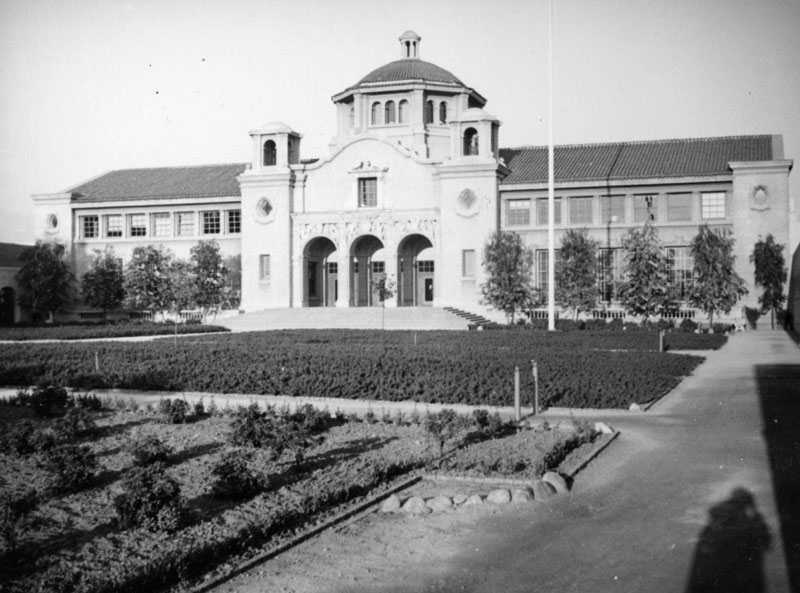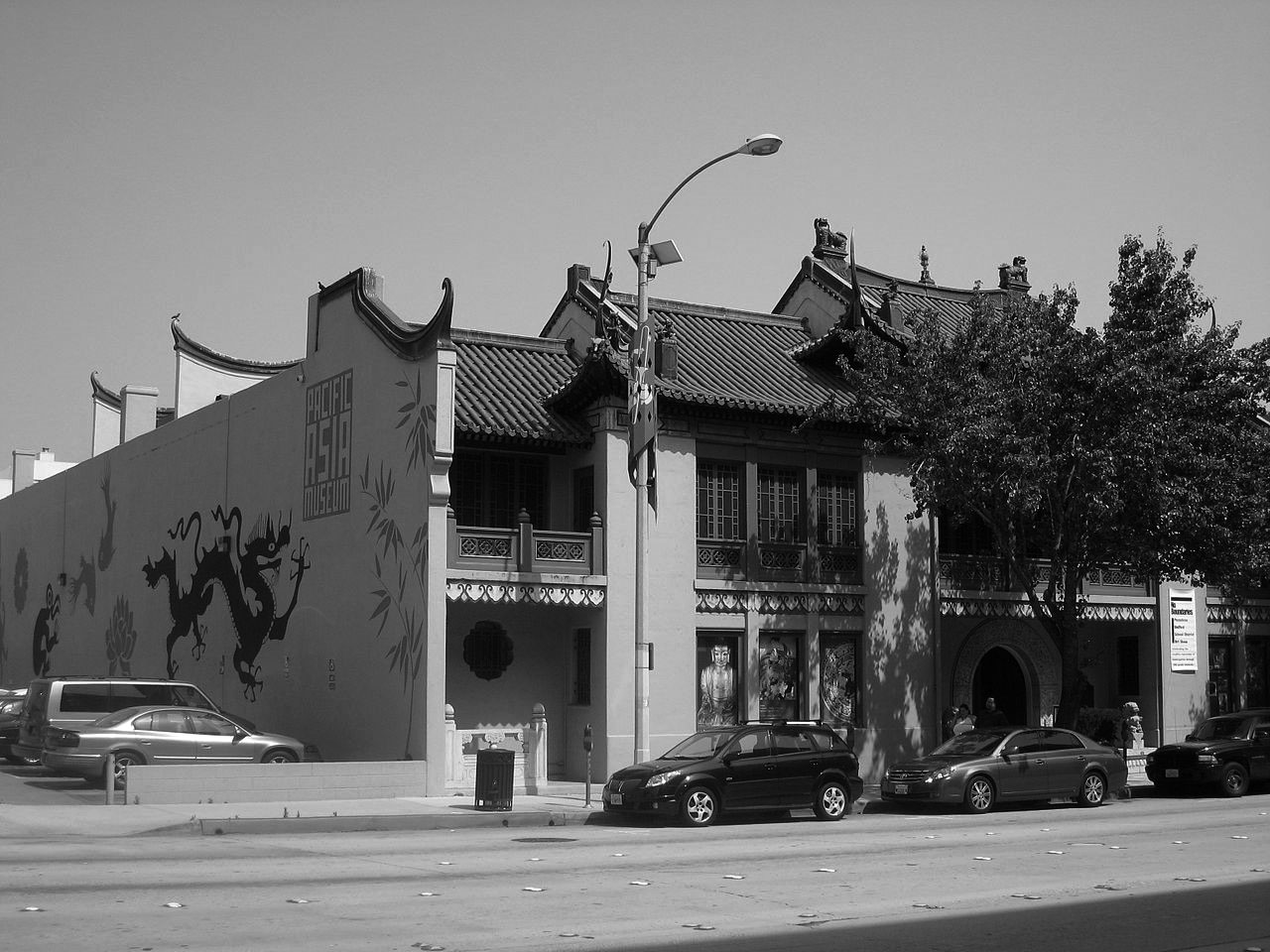Early Views of Pasadena
Historical Photos of Early Pasadena |
 |
|
| (1929)*^* – Balloons support an advertisement for "1929 Century Hupmobile 6's-and-8's now showing" above West Colorado. At ground level, there are Lincoln and Chrysler automobile dealerships. |
Historical Notes Most early Pasadena automobile dealers located their showrooms on Colorado Boulevard. Two groupings developed: one on a two-block stretch of West Colorado Boulevard between Orange Grove Boulevard and downtown, and the other located in the then-geographic center of the city along East Colorado Boulevard between Lake and Hill Avenues. |
.jpg) |
|
| (1929)*^ – View showing a 1929 Hupmobile Series M De Luxe Century 4-Door Sedan. |
Historical Notes The Hupmobile was an automobile built from 1909 through 1940 by the Hupp Motor Company in Detroit, Michigan. Its first car, the Model 20, was introduced to the public at the Detroit Auto Show in February 1909. The company initially produced 500 vehicles. Robert Hupp, a former employee of Oldsmobile and Ford, founded the company with his brother Louis in 1908. Production began in 1909. In 1910, production increased by more than 5000. Hupp Motor Company continued to grow after its founder left. A new plant was purchased in 1924 as Hupp competed strongly against Ford and Chevrolet. DuBois Young became company president in 1924 moving up from vice-president of manufacturing. By 1928 sales had reached over 65,000 units Sales and production began to fall even before the onset of the depression in 1930. By 1940, the company became defunct.*^ |
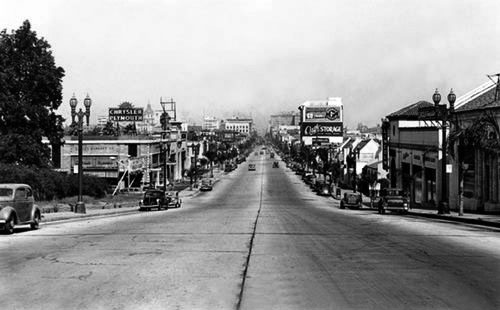 |
|
| (1929)^*** - Colorado Boulevard, just a few years after Route 66 was commissioned. View is from the hill looking East toward what is now Old Town. This may be taken right in front of where the Norton Simon Museum is today. |
Historical Notes Historic U.S. Route 66 ran through Pasadena until it was decommissioned in 1964. The historic highway entered Pasadena from the east on Colorado Boulevard and then jogged south on Arroyo Parkway before becoming part of the Pasadena Freeway (SR 110).*^ |
Raymond and Green
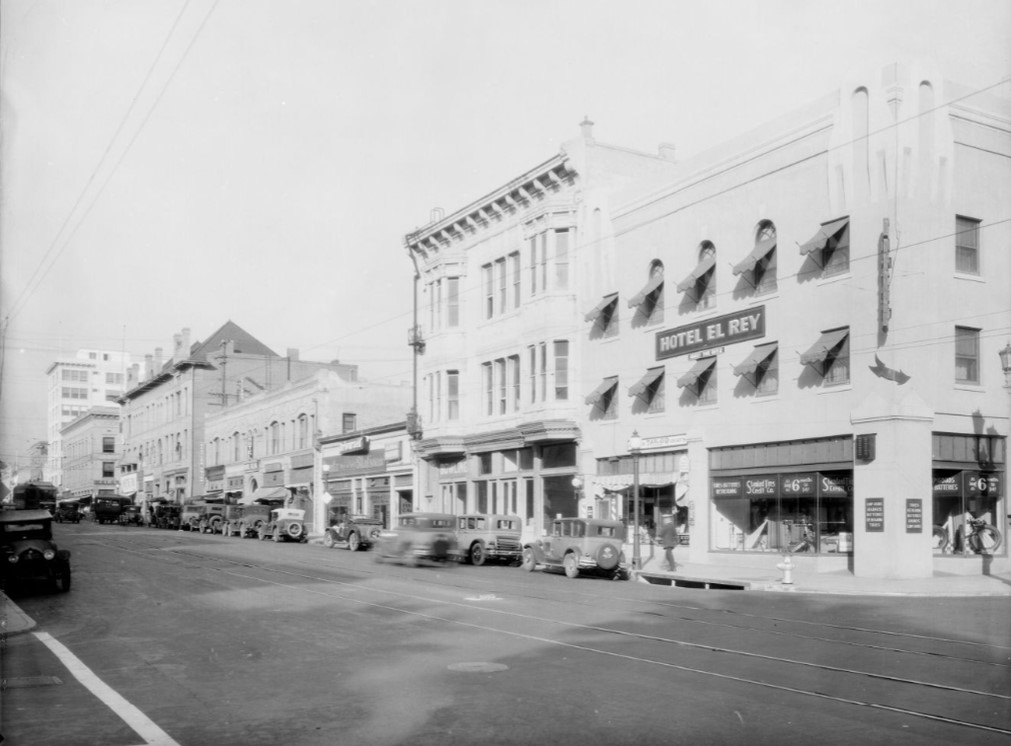 |
|
| (1928)*- Street view on South Raymond, looking north from Green Street. Hotel El Rey, on the corner, is at 87 East Green Street. Numerous businesses are visible on the right, including a camp goods store, a tailor, and a bowling alley. Photo by Harold A. Parker |
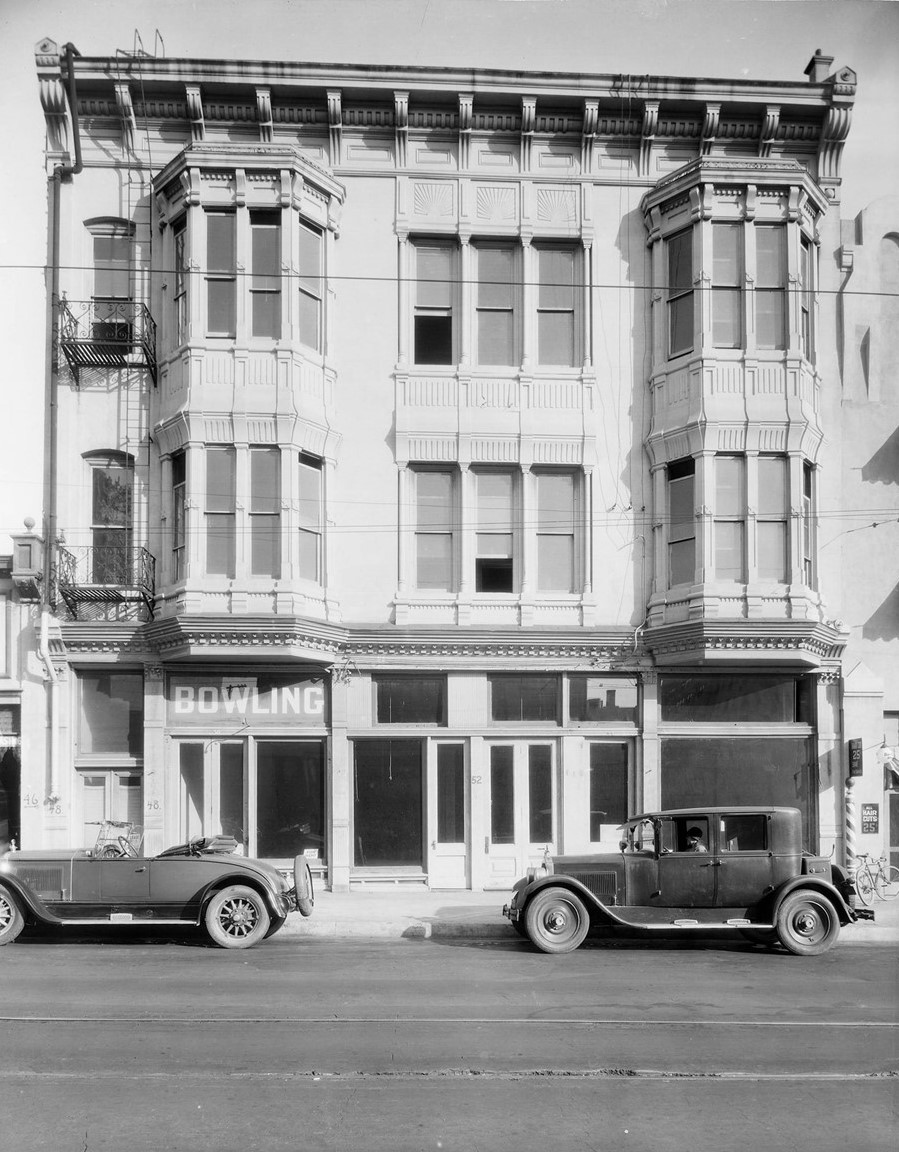 |
|
| (1928)* – Three-story Victorian style building located at 48-52 South Raymond in Pasadena. The building still exists today but has undergone significant changes, making it unrecognizable compared to its original appearance. Photo by Harold A. Parker |
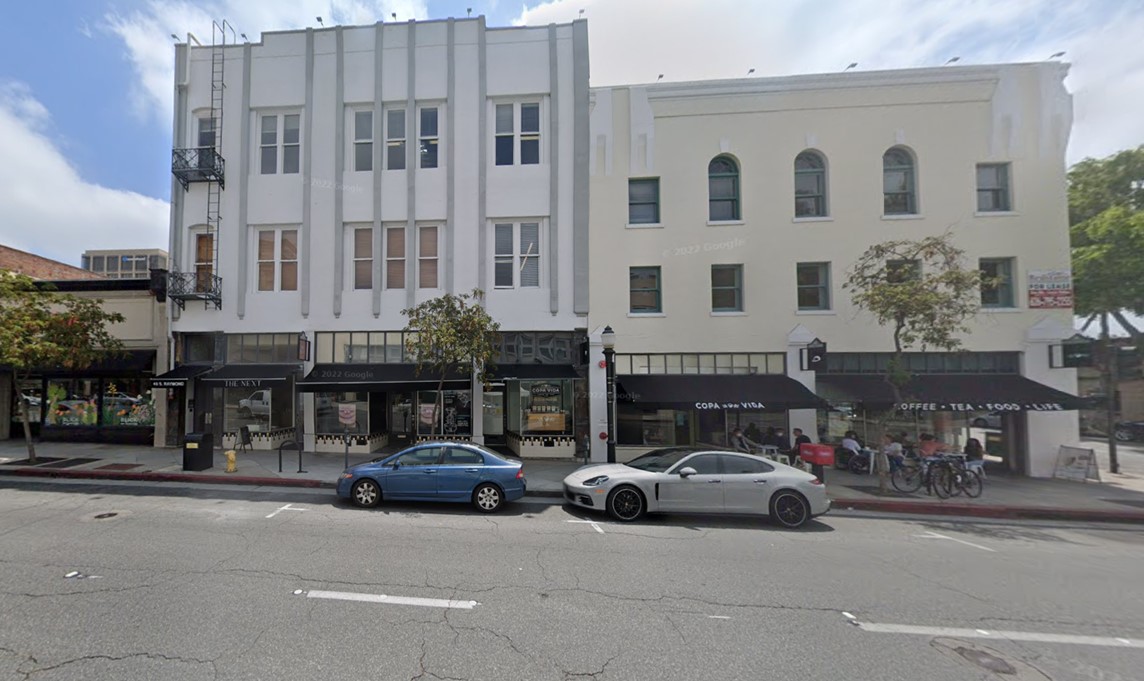 |
|
| (2022)* – Looking at the east side of S. Raymond Ave just north of Green Street showing (on the left) the new version of the building seen in previous photo. |
Then and Now
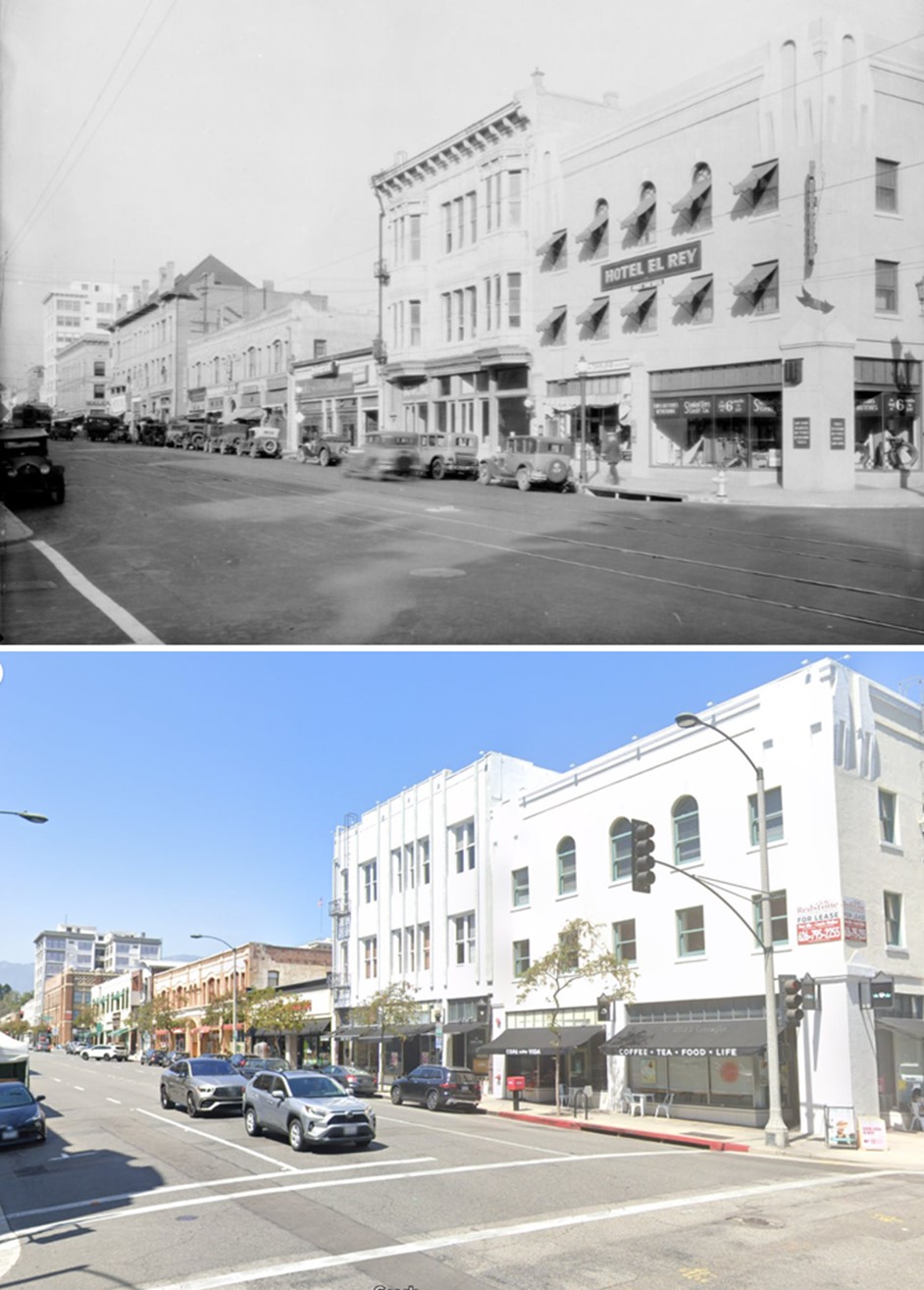 |
|
| (1928 vs 2022)* - Raymond Avenue looking North from Green Street. |
.jpg) |
|
| (1928 vs 2022)* - Three-story Victorian style building located at 48-52 South Raymond Avenue in Pasadena. |
* * * * * |
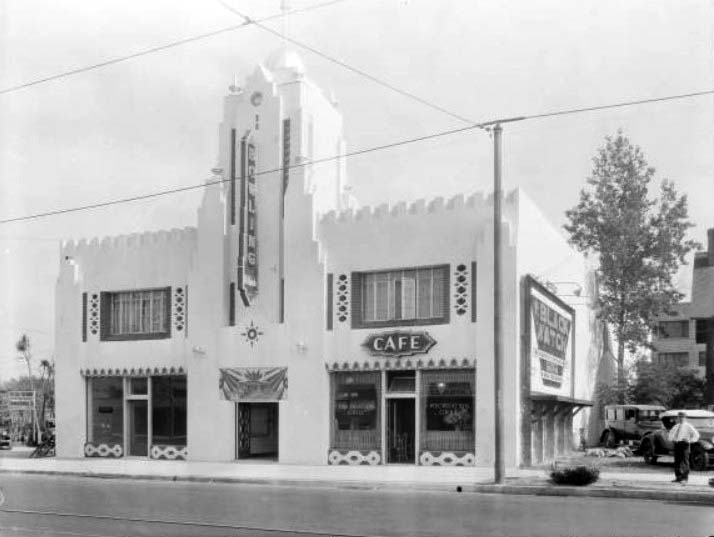 |
|
| (1929)**- Street view of a bowling hall and billiard parlor at grand opening at 970 East Colorado. To one side is a cafe called the Recreation Grill, while the space on the other side is vacant. |
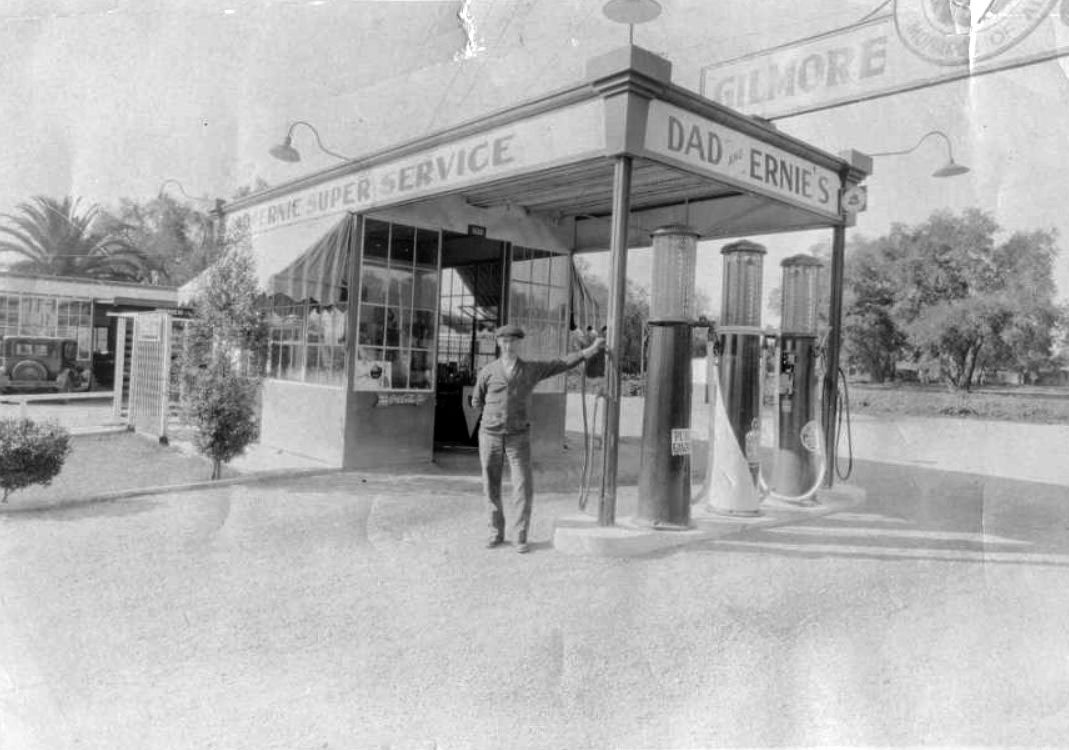 |
|
| (1930)*^* - Adolph Thore stands in front of Dad's and Ernie's Gas Station, which was located at 2830 E. Colorado at Daisy. He and Ernie Pare, the garage mechanic, were the owners and operators. They provided fuel from Gilmore Gas. |
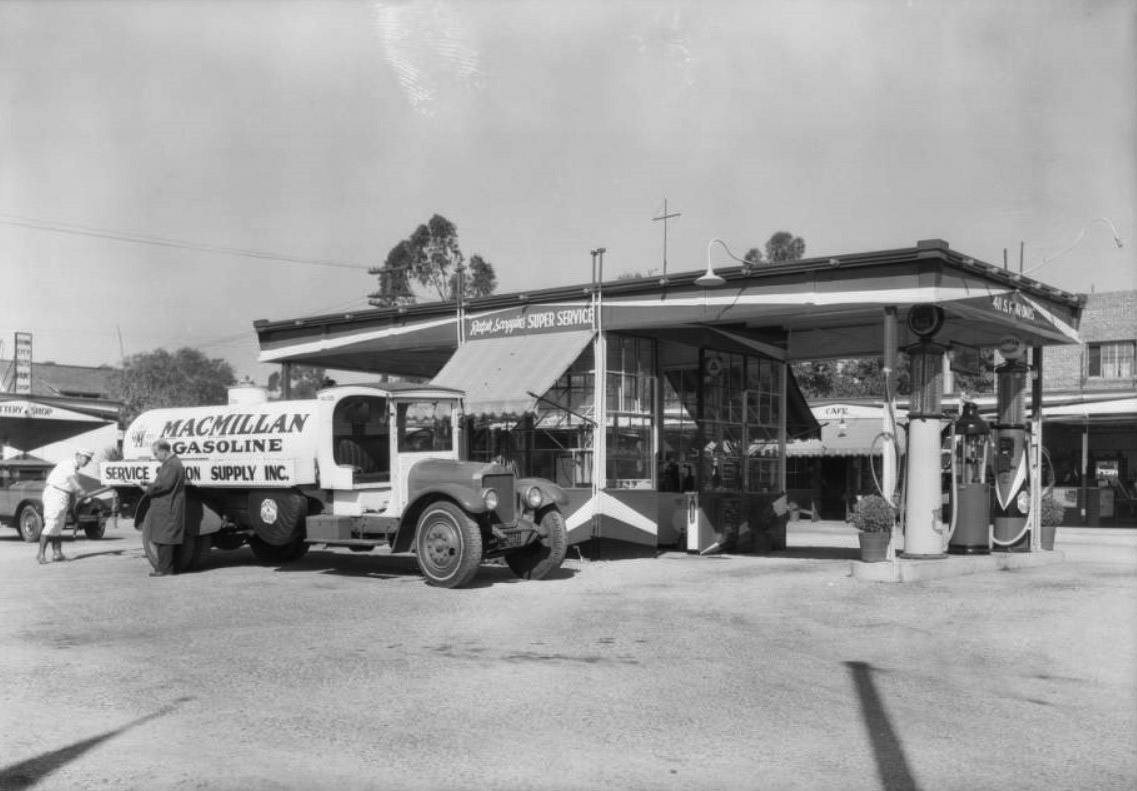 |
|
| (1929)^ – View showing a MacMillan Oil truck at a 'Super Service' Station located at 411 South Fair Oaks Avenue. |
Historical Notes Super service stations were important elaborations of the original filling stations. Introduced in Los Angeles prior to World War I, super service stations combined operations that had been handled separately. Before that time, a motorist went one place for gas and oil, and other places for lubrication and cleaning, for repairs, or for tires and other accessories. Combining these activities was convenient for consumers and opened up new marketing possibilities for those interested in taking advantage of the boom in automobiles. The earliest known super service station—Service Town—was built in 1914, three miles from downtown Los Angeles. Several of these stations were constructed in southern California in the early 1920s and soon spread across the country. +** Click HERE to see more Views of Early Gas Stations. |
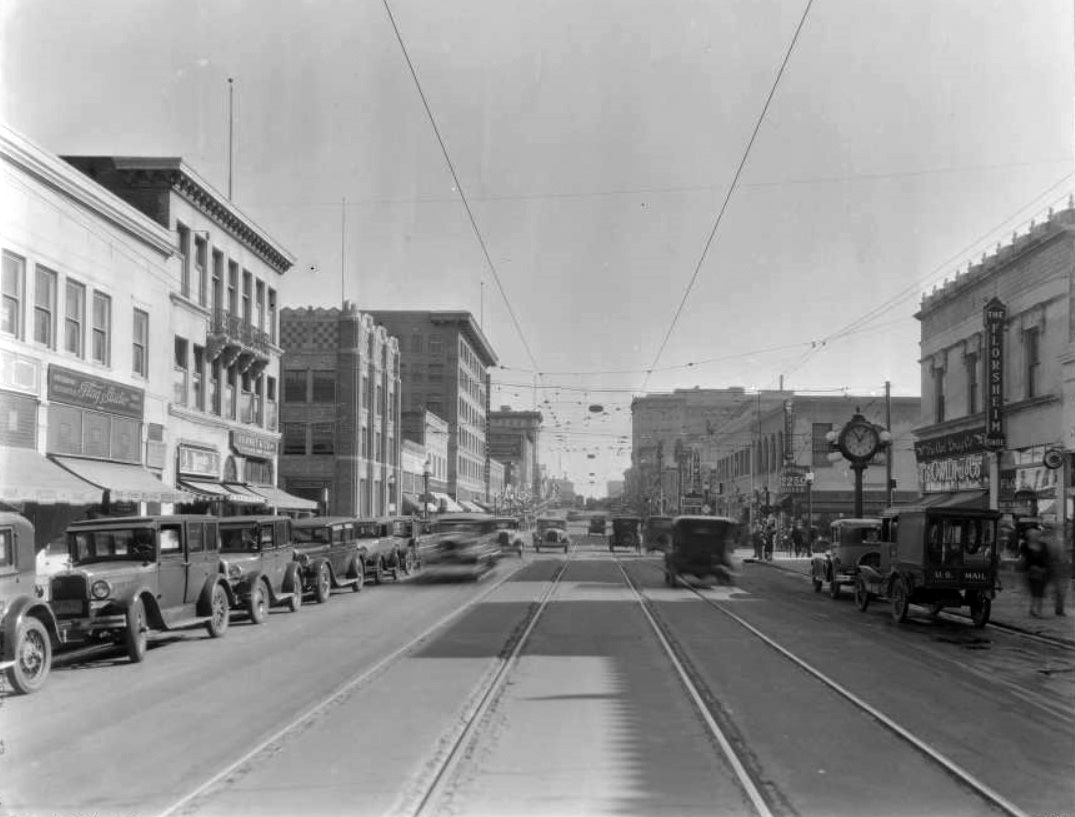 |
|
| (1929)*^* - View of East Colorado facing east from midway between Fair Oaks and Raymond. Shows 64 East Colorado, Owl Drug Company, which was Sun Drug Company in 1925. Other businesses shown include the Florsheim Shoe Store, the Flag Studio, and Bernet & Co. clothing store. The street is lined with parked automobiles and busy with moving automobiles and streetcars. |
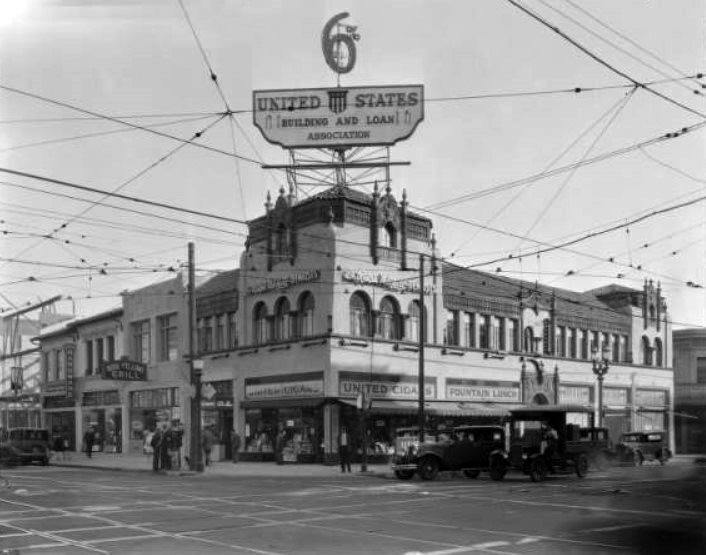 |
|
| (1929)#* - Street view of United Cigar at 2 East Colorado, on the southeast corner of Fair Oaks and Colorado. Above the cigar store is Dr. Ralph Mitchell Dentists. Other businesses pictured include the Goodfellows Grill and Steven Hardware. The large sign above the building reads: “6% - United States Building and Loan Association” |
Historical Notes With an untimely opening soon after the stock market crash in 1929, the building’s main tenant, the United States Building and Loan Association, was soon history. The building exists today but without the spires that used to extend above the third story windows. #*# |
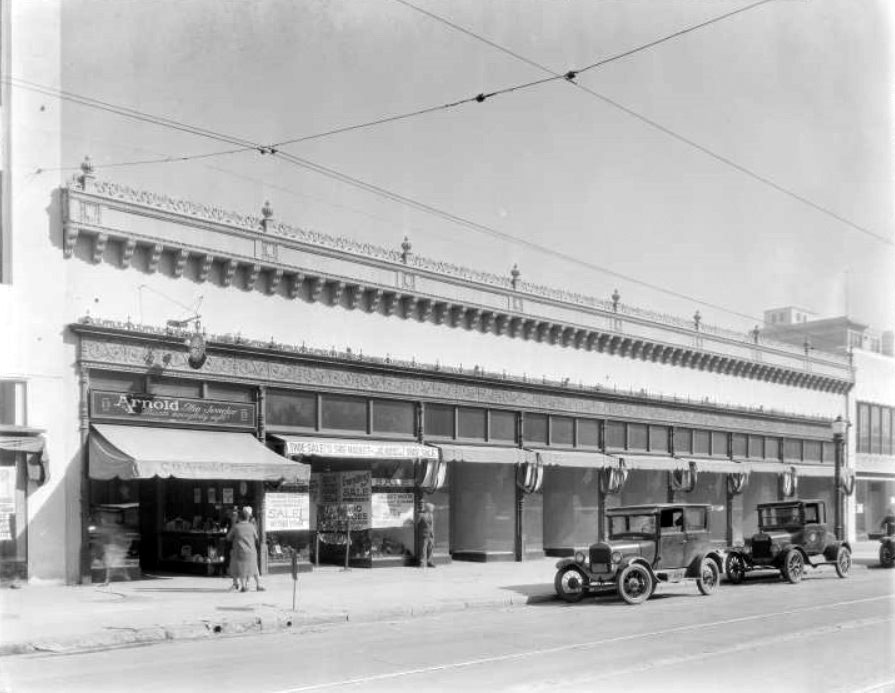 |
|
| (1930)*^* – Street view of the businesses from 13 to 31 East Colorado. The businesses shown are the C.O. Arnold Jewelers and the Shoe Market which has signs announcing a close-out sale. All the shops beyond that are vacant. |
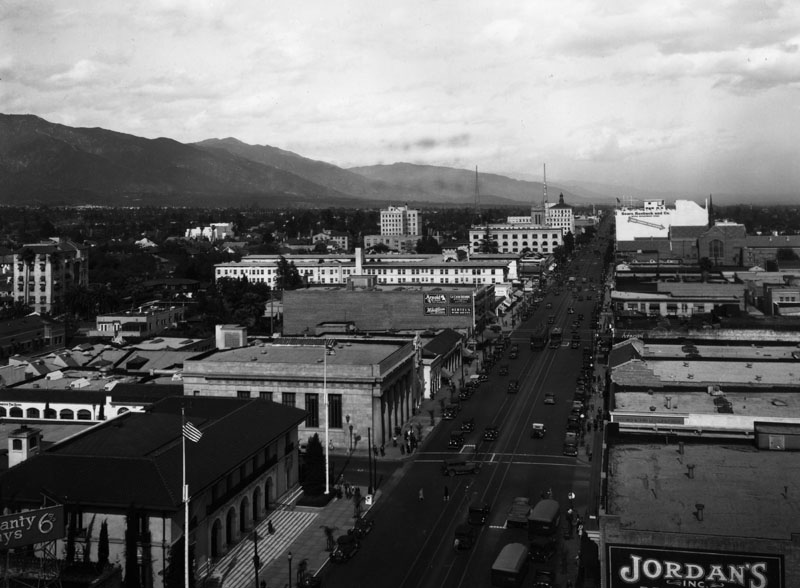 |
|
| (1930)*- View of Colorado Blvd. in Pasadena looking east from Marengo Ave. in 1930. The Post Office is at left, and Jordan's Inc. Dry Goods at right. |
.jpg) |
|
| (1930)* - Colorado Blvd. in Pasadena looking east from the Elks Club (near Orange Grove) in 1930. |
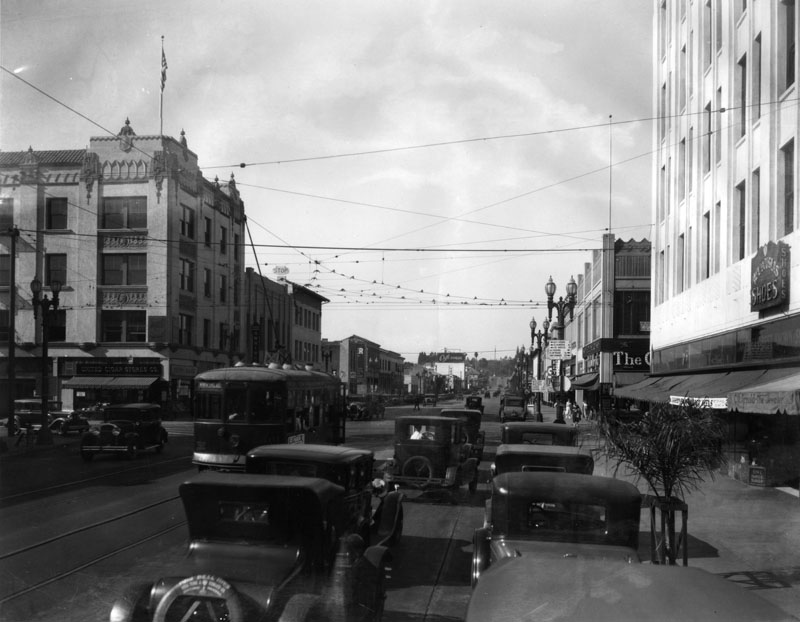 |
|
| (1930)* - Colorado Blvd. at Fair Oaks Avenue in Pasadena in 1930. View is toward the west. |
.jpg) |
|
| (1930)* - View of Colorado Blvd. in Pasadena in 1930, looking west from the Maryland Hotel. |
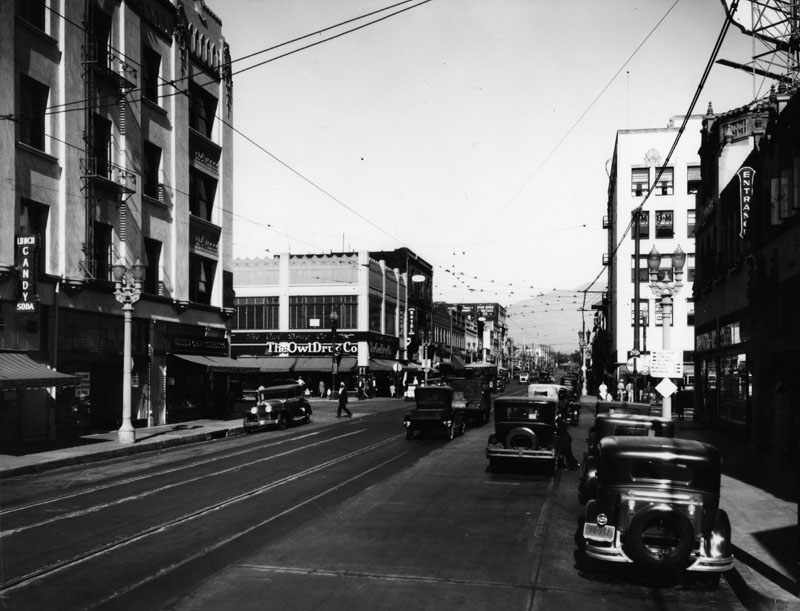 |
|
| (1930s)* - View of Fair Oaks Avenue looking north from Colorado Boulevard toward Union Street. An Owl Drug Store can be seen on the northwest corner. |
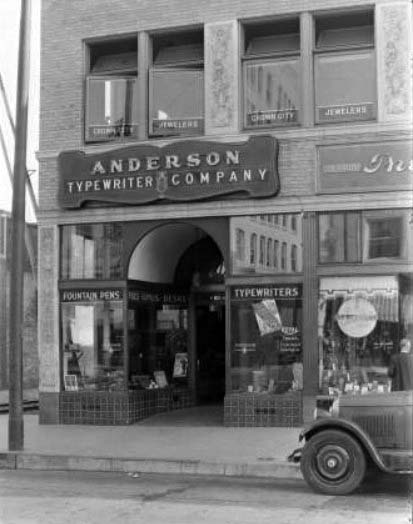 |
(1930)* - Street view of the Anderson Typewriter Company at 104 East Colorado. The display windows show various kinds of typewriters. A sign in the window announces that all makes of typewriters are available for rent. The space above is occupied by Crown City Jewelers.
|
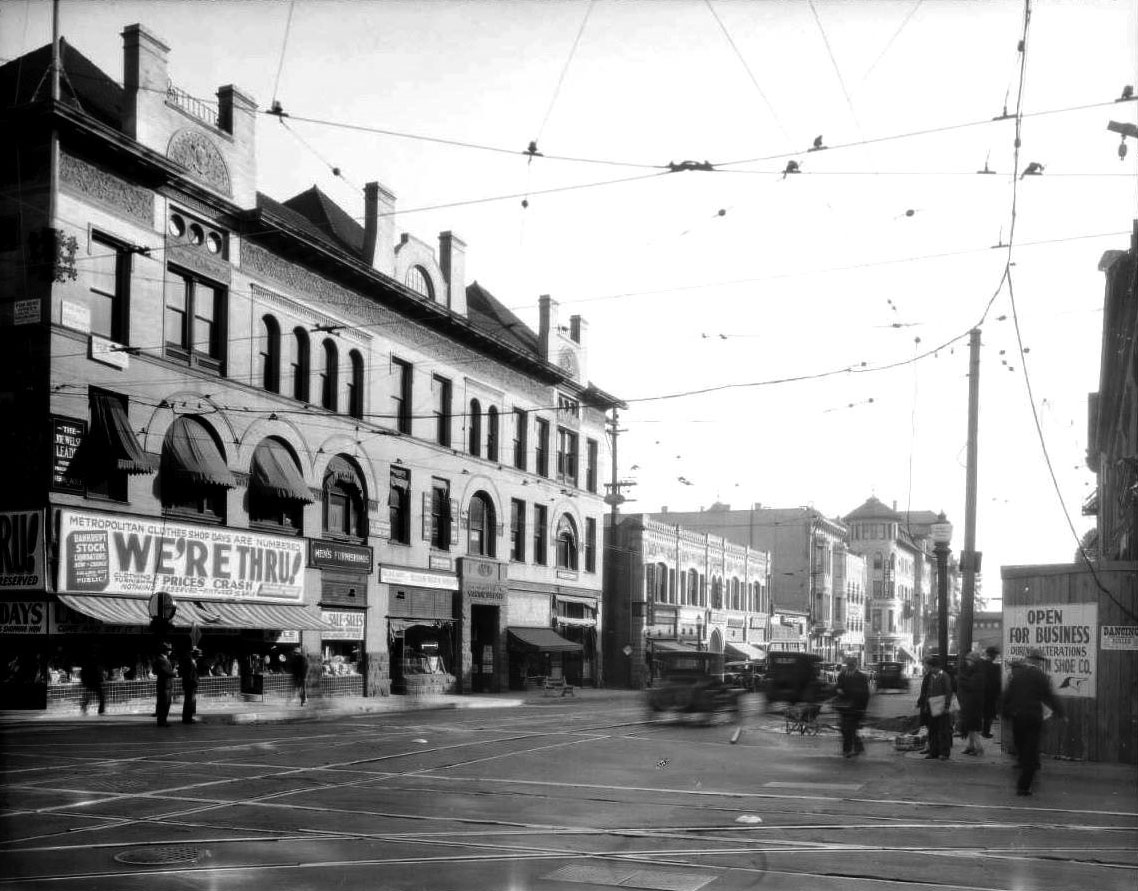 |
|
| (1928)*- View looking south on Raymond from Colorado. The large sign on southeast corner building (old Masonic Temple Block, built in 1898) reads: “Metropolitan Clothes Shop Days are Numbered – WE’RE THRU!” Sign on southwest corner reads: “OPEN FOR BUSINESS”. The tower in the distance, on the east side of Raymond, is the addition to the original Hotel Green structure. |
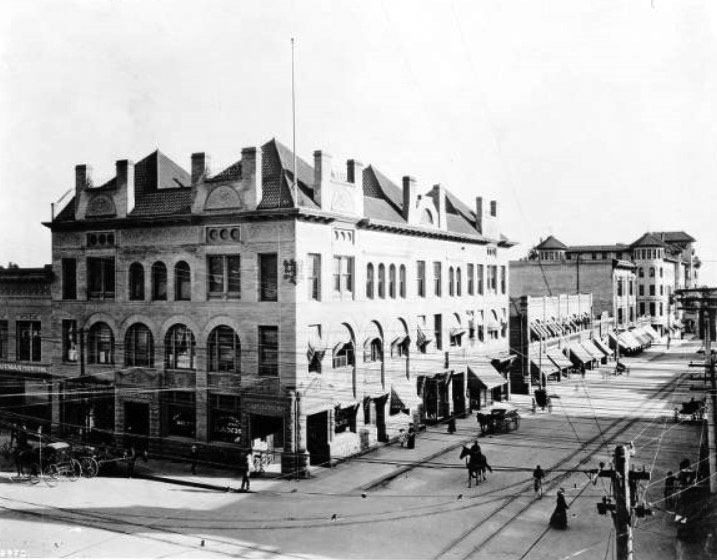 |
 |
|
| (1908 vs 1928)* - View looking south on Raymond from Colorado toward the Green Hotel. |
Historical Notes Harry Ridgway designed the imposing Masonic Temple block at the southeast corner of Raymond and Colorado in Romanesque Revival style in 1894. He was also the architect/designer for the First National Bank building, built in 1886 on the n/w corner of Colorado and Fair Oaks. |
Then (1932)
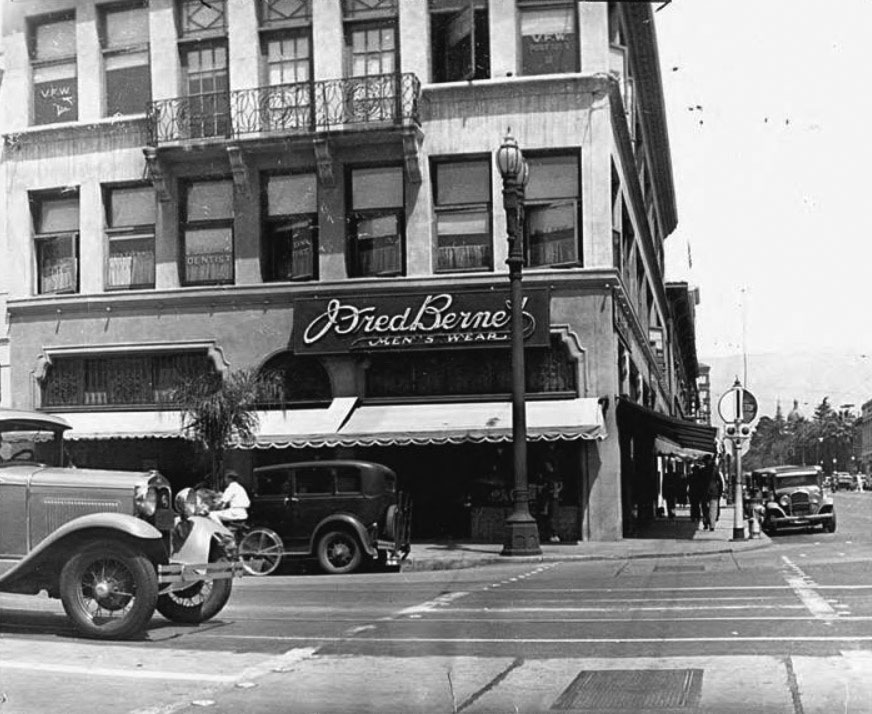 |
|
| (1932)* – View looking at the northwest corner of Raymond Ave and East Colorado Boulevard showing Fred Bernet Men’s Wear. |
Now (2015)
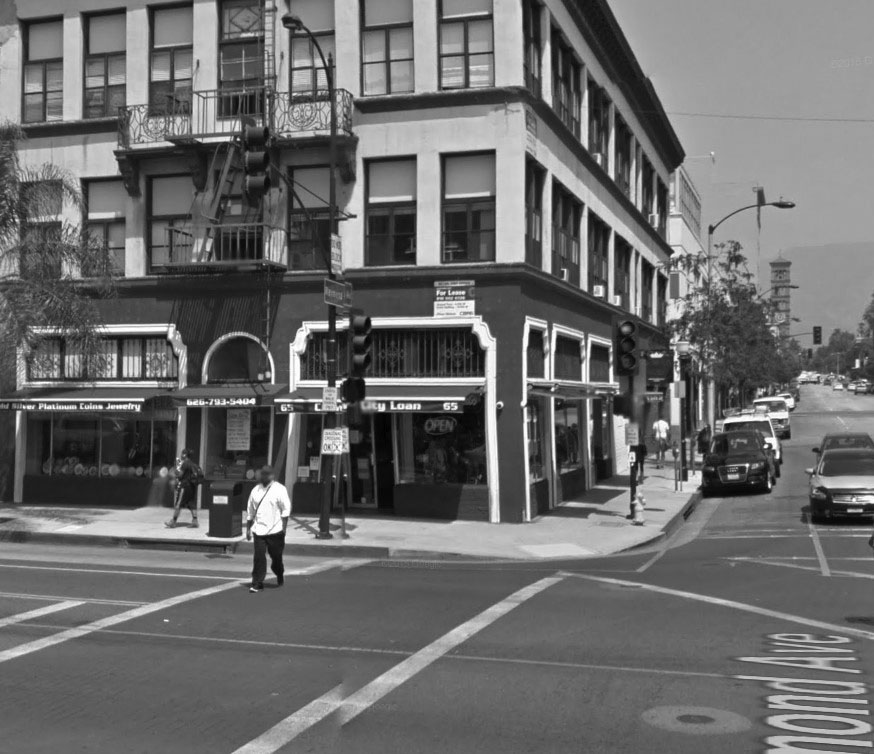 |
|
| (2015)* – View looking at the northwest corner of Raymond Ave and East Colorado Boulevard. |
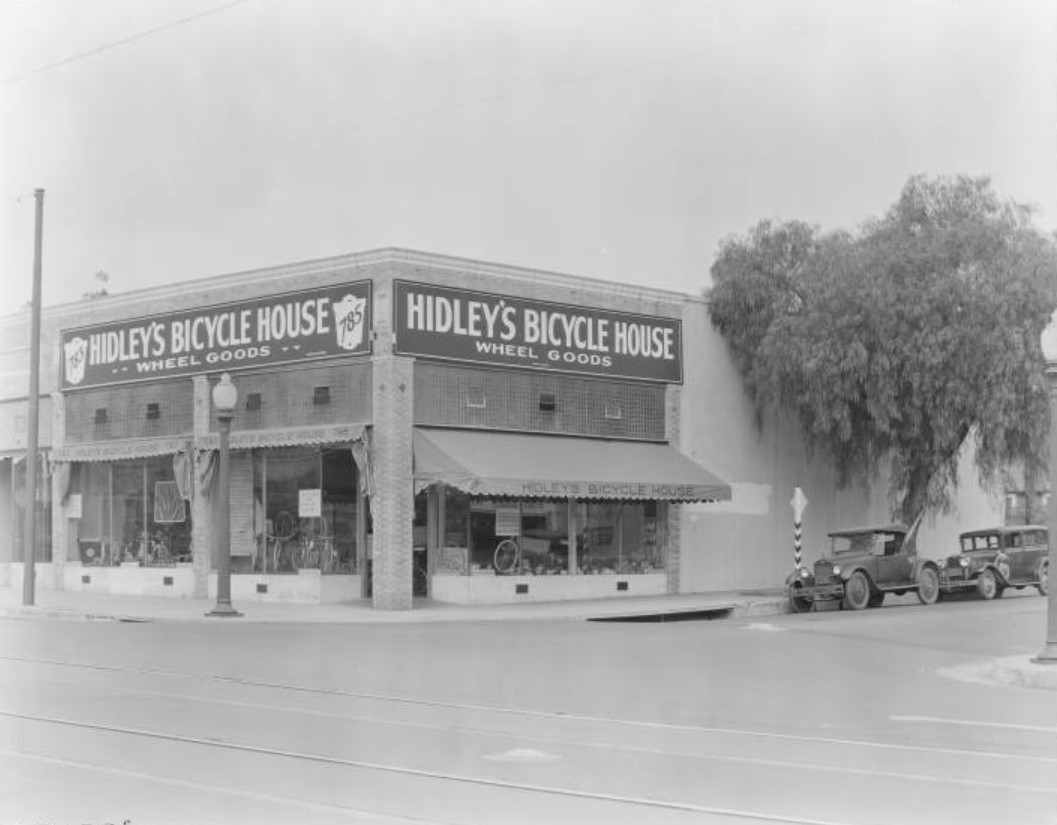 |
|
| (1930)* – Street view of Hidley's Bicycle House at 785 East Colorado Blvd (N/W corner of Colorado and Hudson). The store has large display windows showing off bicycles, bicycle equipment, scooters, and racquets. Signs in the window announce deals and promotions for the Christmas season, and several note that "Yes, we buy bicycles." |
Historical Notes The above corner site is currently occupied by a Target Store. |
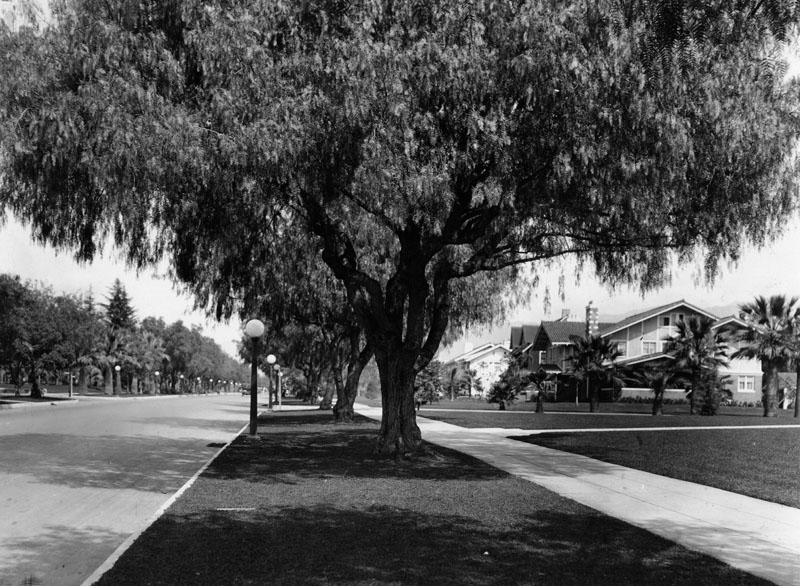 |
|
| (1930)* - View of Orange Grove Blvd. in Pasadena in 1930. A residential area, it is lined with pepper trees. |
Van de Kamp's Bakery
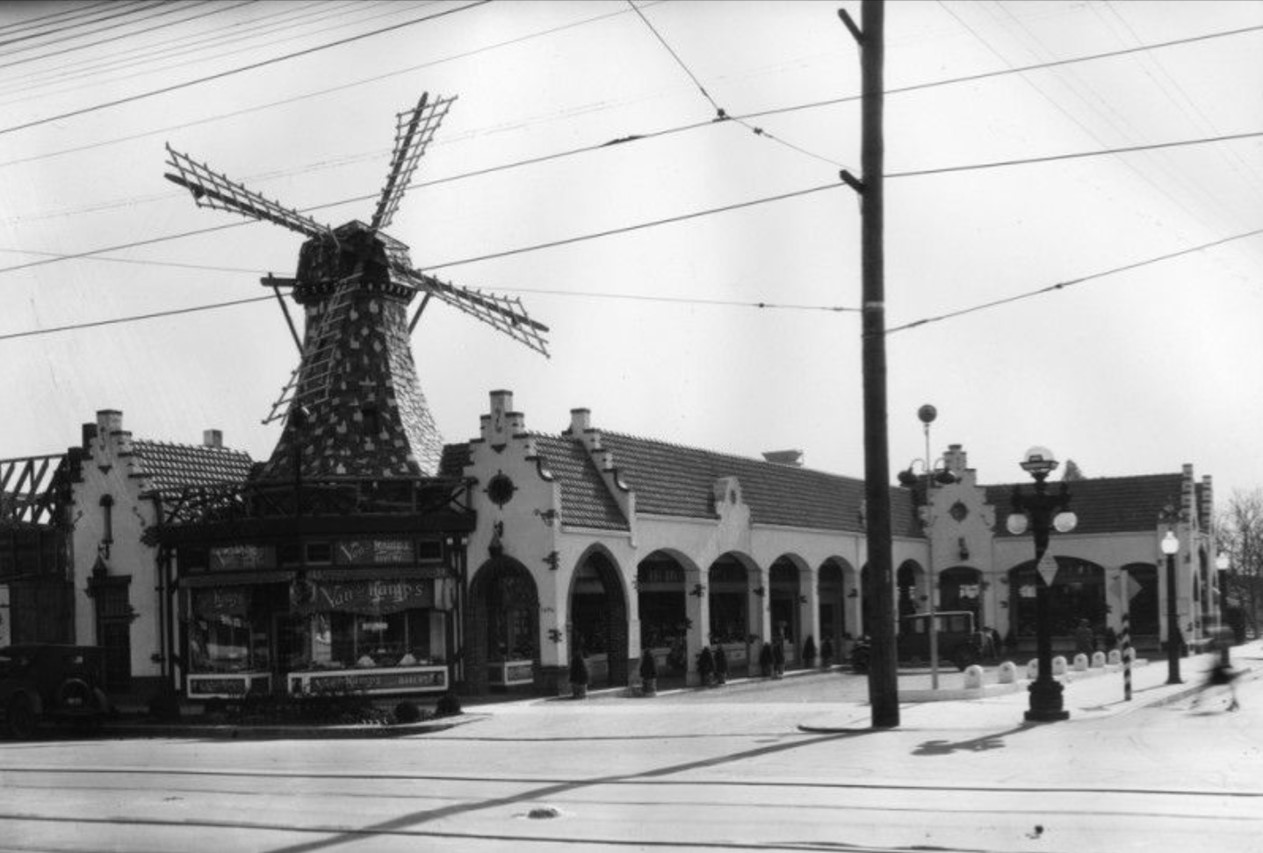 |
|
| (1930s)* - View showing Van de Kamp's Bakery located on the SE corner of East Colorado Blvd and Bonnie Ave. |
Historical Notes Built in 1927, the Pasadena bakery was located on the southeast corner of East Colorado Boulevard and Bonnie Avenue (1696 E Colorado Boulevard). A prominent windmill atop the store was attached to a white L-shaped structure with stepped Dutch pediments. It’s very likely it was a project of New York architect J. Edwin Hopkins who designed Van de Kamp’s factory and headquarters in Glassell Park in 1930 – the two buildings had much in common. It’s a pity this little plaza resembling an old Dutch farmhouse was demolished in 1974 and later replaced by a generic Chick-fil-A branch. Click HERE for contemporary view. |
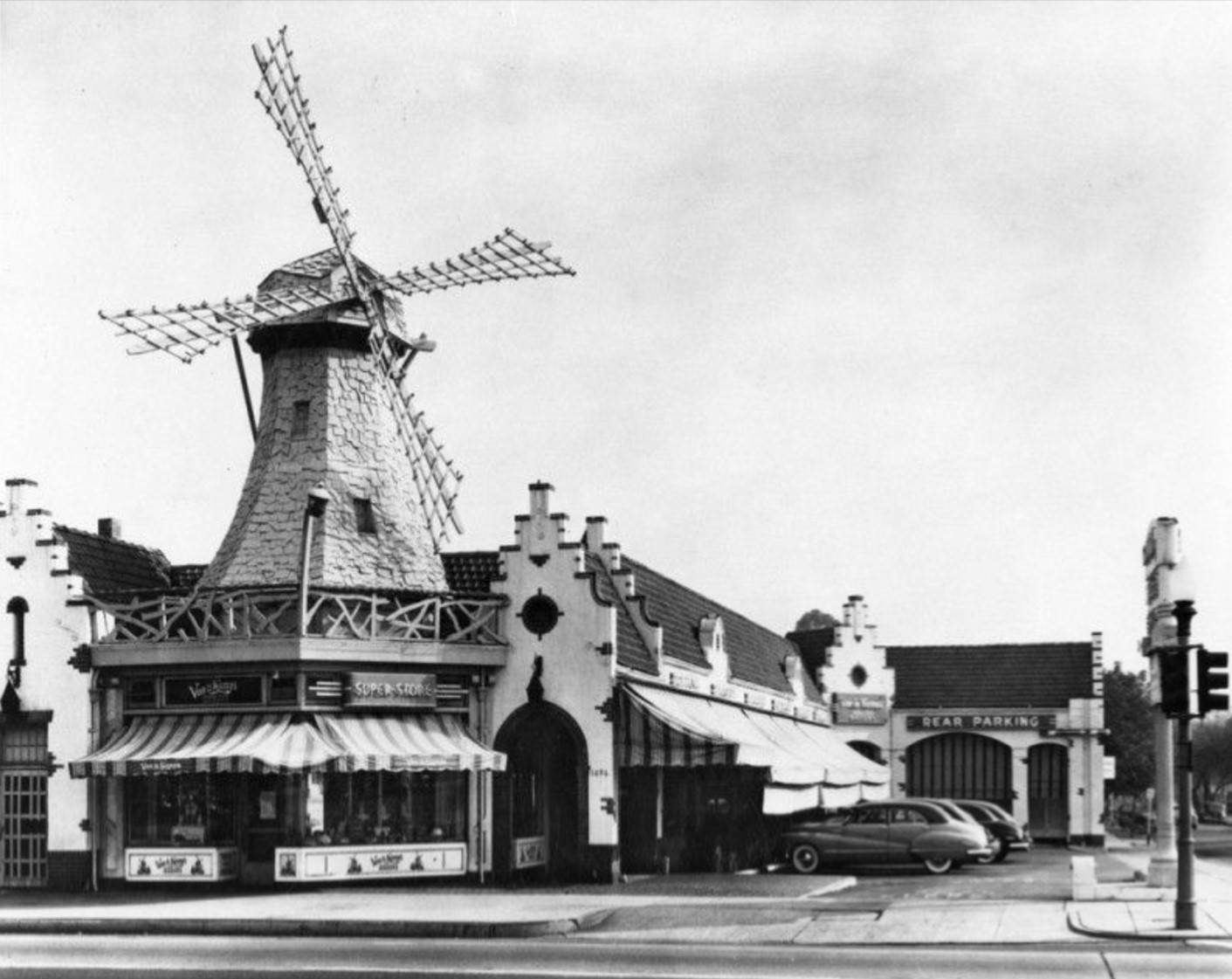 |
|
| (ca. 1947)* - Van de Kamp's Bakery located at 1696 E. Colorado Boulevard in Pasadena. Almost the same view as the previous photo but 10 plus years later. There is now a new traffic signal on the corner and the overhead power lines have been removed. |
Historical Notes Although the Van de Kamp’s company was based in Los Angeles, the Van de Kamp family was from Pasadena. The company formed in 1915 by Theodore, Marian, and Henrietta Van de Kamp, along with Lawrence Frank. Theodore J. Van de Kamp and brother-in-law Lawrence L. Frank were the owners and originators of the Van de Kamp Bakeries. Fondly known as the "Taj Mahal of all bakeries". Van de Kamp and Frank also founded both the Tam O'Shanter's (1922) and Lawry's The Prime Rib (1938) restaurants. |
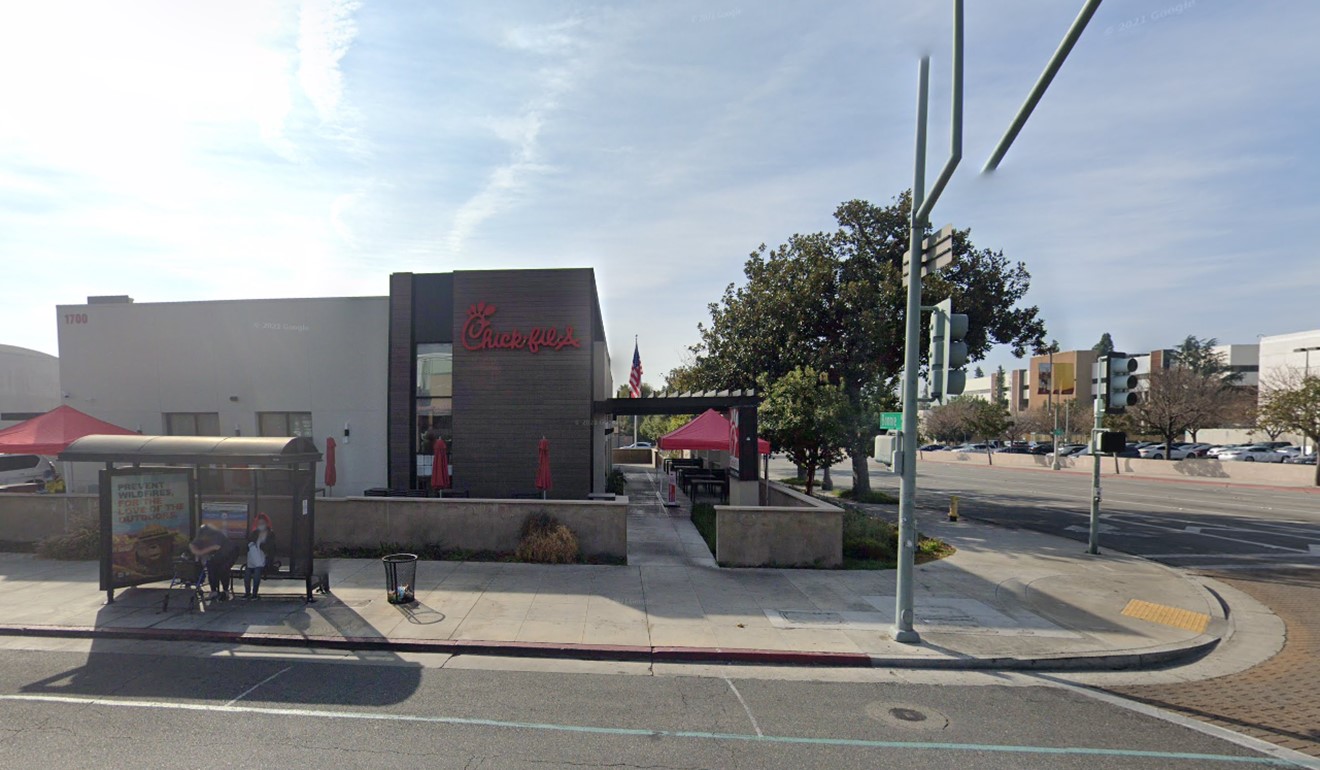 |
|
| (2021)* - Contemporary view of the southeast corner of East Colorado Blvd and Bonnie Ave, now home to a Chick-fil-A drive-thru, once the site of a Van de Kamp's Bakery. |
Then and Now
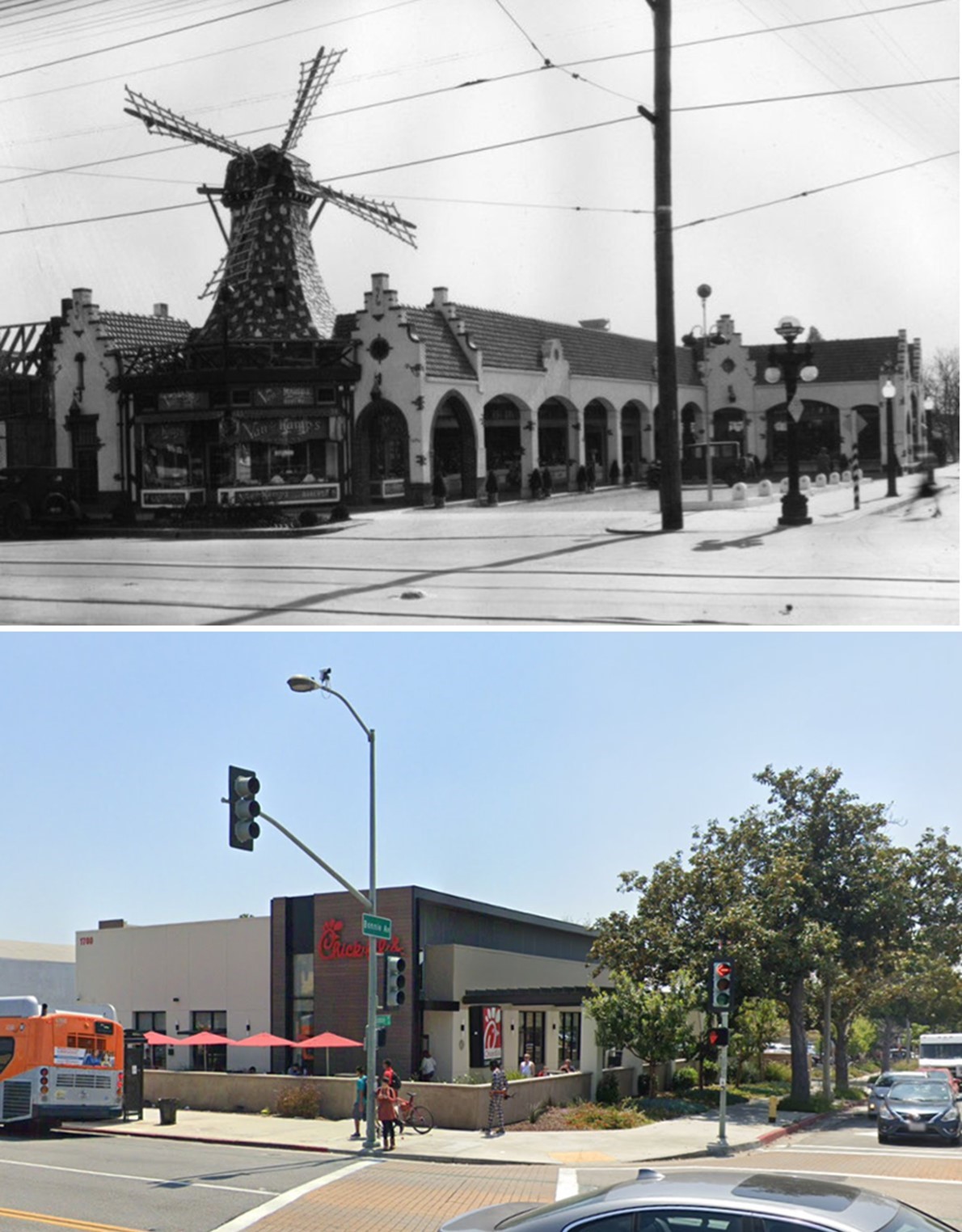 |
|
| (1930s vs 2019)* - View of Van de Kamp’s Bakery at the southeast corner of East Colorado Blvd and Bonnie Ave, now the site of a Chick-fil-A drive-thru. Photo comparison by Jack Feldman. |
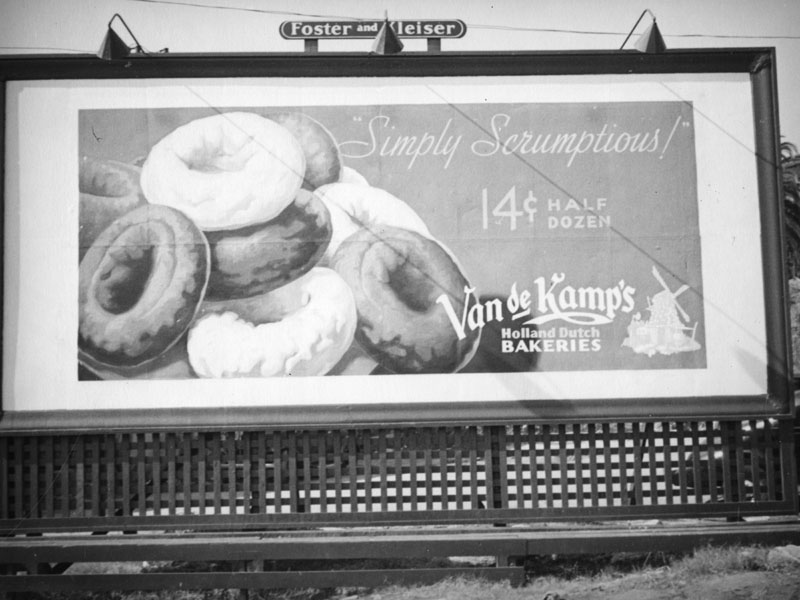 |
|
| (1937)* - A Foster and Kleiser billboard advertising doughnuts sold at Van de Kamp's Bakeries. Photo by Herman J. Schultheis |
Historical Notes The bakery was sold by the Van de Kamp family and acquired by General Baking Co. in 1956. The company was sold to private investors in 1979, and closed in bankruptcy in 1990. The Van de Kamp's brand is now owned by Ralphs supermarket chain and used for their line of private-label baked goods. |
* * * * * |
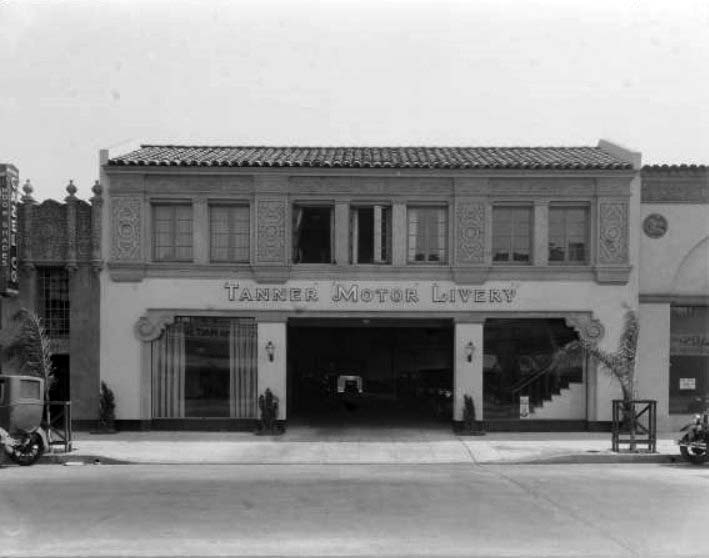 |
|
| (1930)* - Street view of the Tanner Motor Livery at 144 West Colorado. The building has two stories, and a front door wide enough for Automobiles to drive through. Automobiles on display are visible through this door. |
.jpg) |
|
| (1936)* - Ten black and white taxis owned by Tanner Motor Livery at 144 West Colorado, parked at approximately 139 West Colorado. The automobiles are parked in front of Woods & Jones Printers, Campbell Seed Store, the Bronx Diner, and Nipedal Studio Designers. |
Historical Notes Today, the 144 West Colorado building is occupied (from L to R) by Urban Outfitters, The Body Shop, and Su le Table. |
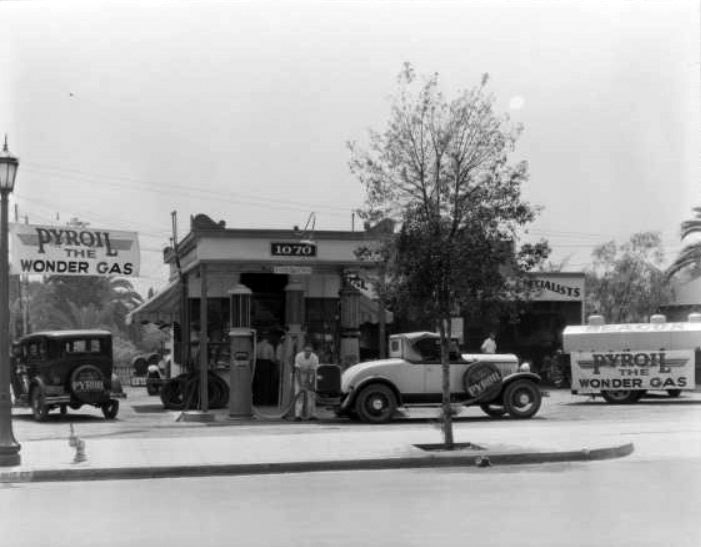 |
|
| (1932)* - Street view of the Pyroil Service Station at 1070 East Walnut. An automobile with a spare wheel cover advertising for Pyroil is being refueled at one of the three pumps in front of the building. Signs and banners advertise for "Pyroil the wonder gas". |
Historical Notes The Pyroil brand is a trademarked name for a line of automotive chemicals offered today by the Ashland Oil Company. But in 1932, it was also a brand of gasoline that was being heavily promoted. Click HERE to see more Early Gas Stations. The roadster looks like a 29 Chrysler Series 75. 1070 E. Walnut in Pasadena is still there and today is an automobile repair shop. |
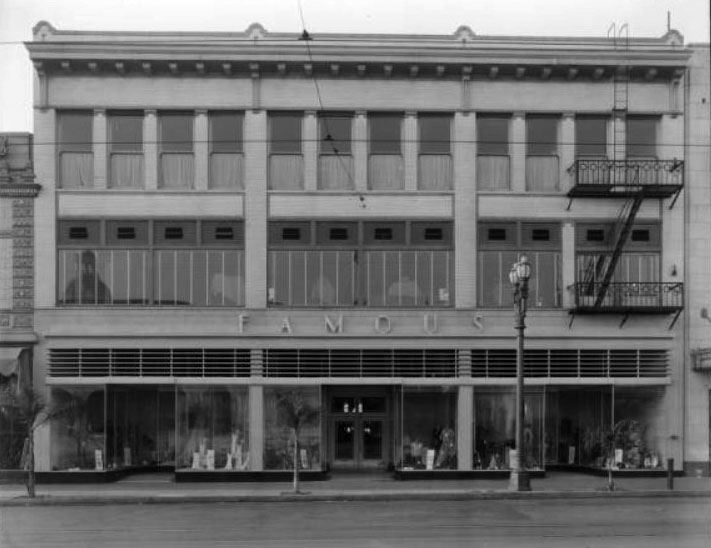 |
|
| (1933)* - Street view of the Famous Department Store at 268 East Colorado. The large windows show displays of men's and women's clothing. A metal fire escape is attached to the two upper levels. |
Historical Notes Prior to ‘The Famous Department Store’ there was Jordan’s Department Store, located in the same building at 268 East Colorado. |
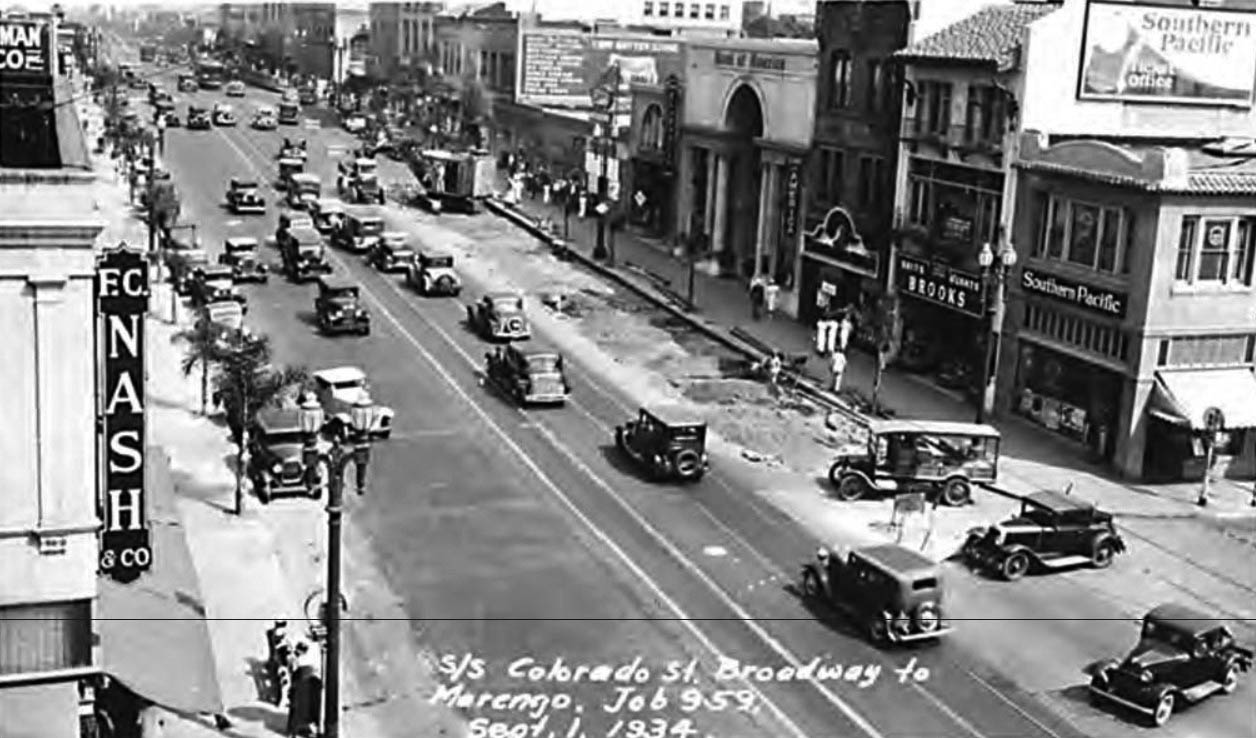 |
|
| (1934)*- View of the south side of Colorado Street, Broadway to Marengo. Broadway is now called Arroyo Parkway. |
Arcade Building
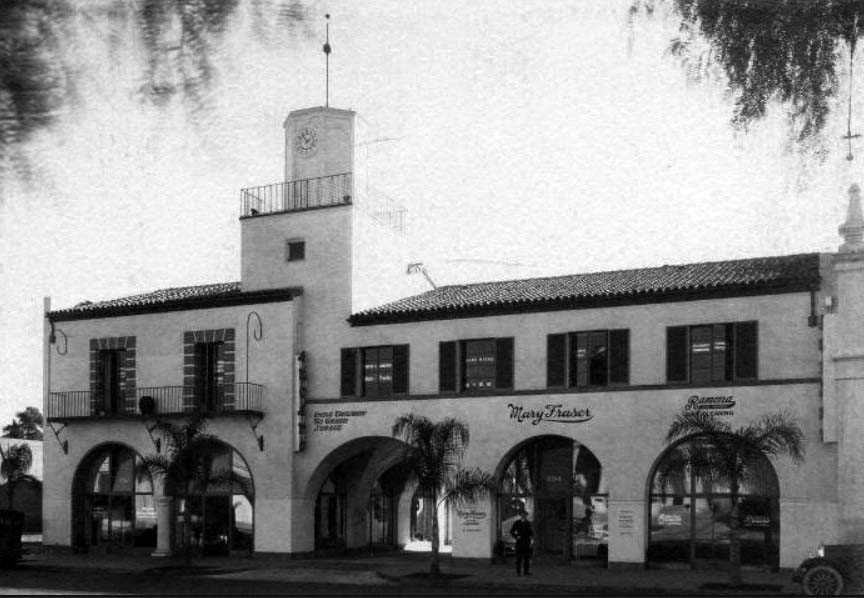 |
|
| (1930s)*- View of the Arcade Building located on East Colorado Street between El Molino and Oak Knoll Avenues. |
Historical Notes The Arcade Building was one of the many new developments growing up on East Colorado, far from the traditional core downtown. It employed a new design that accommodated shoppers and their automobiles; the driveways to the heavily advertised parking lot was dubbed "Luxury Lane." It was, as the Pasadena Star News reported, "another page in the city's development." The Arcade Building's design was inspired by a similar structure in Budapest. Opening in 1927, the building was home to 27 stores and offices, including a wax flower shop, a tearoom, a candy shop, a jewelry store, and "moth proofers de luxe." The businesses were advertised as among the finest in the world, and several retailers had international branches. |
Then and Now
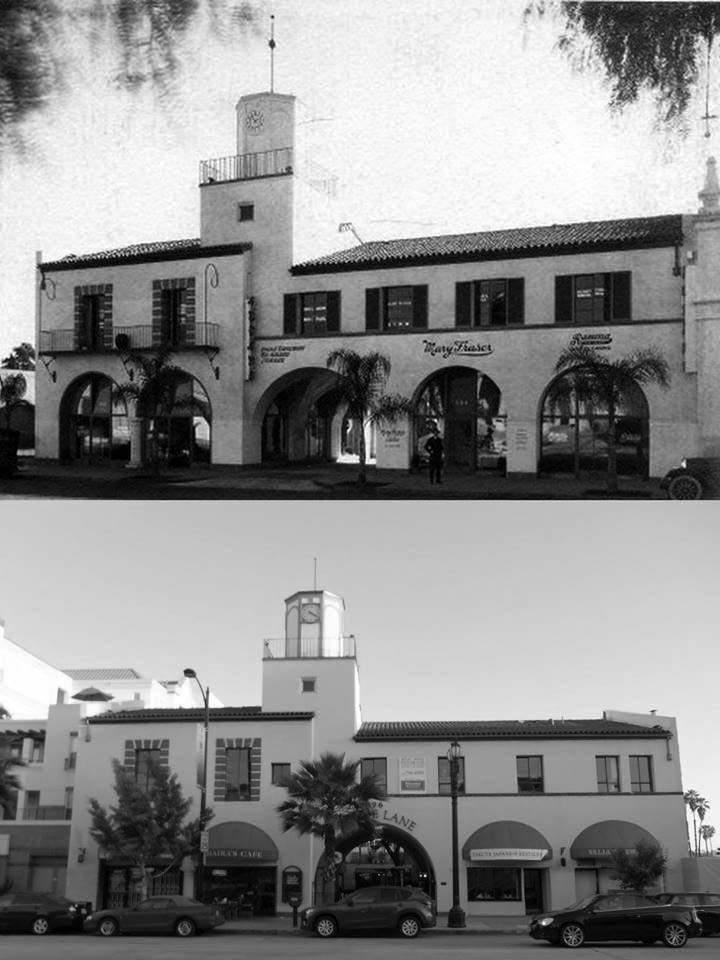 |
|
| (1930s vs. 2018)* - View showing the Arcade Building located at 696 E. Colorado Blvd, Pasadena |
First Church of Christ, Scientist
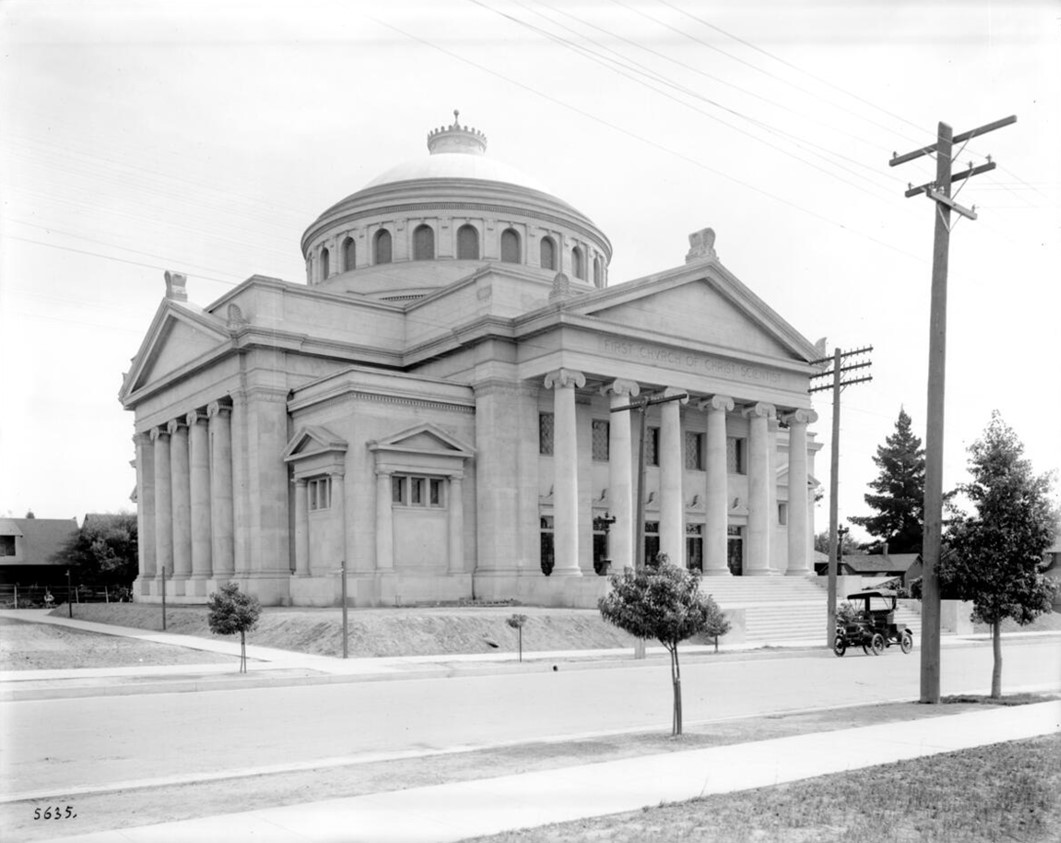 |
|
| (ca. 1910)* - Pasadena’s Christian Science Church, located at 80 S. Oakland Avenue. |
Historical Notes It is officially known as First Church of Christ, Scientist, Pasadena. The church is a branch of The First Church of Christ, Scientist in Boston, Massachusetts, which was founded by Mary Baker Eddy in 1879. |
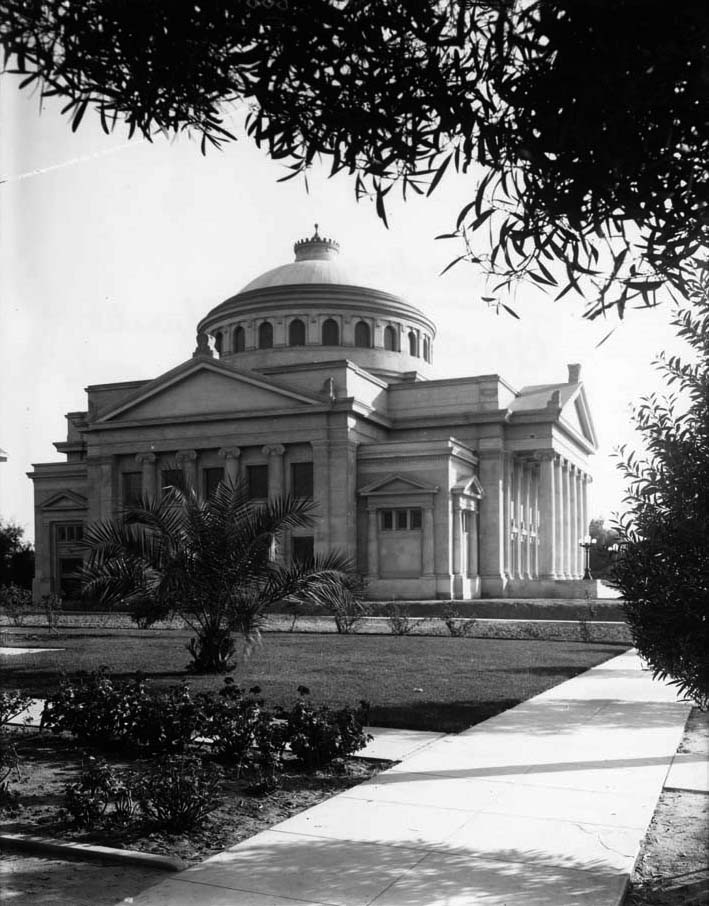 |
|
| (1909)^## – Side view of the First Church of Christ, Scientist Pasadena with Classical Revival style stone-brick, marble columns and dome. |
Historical Notes The First Church of Christ, Scientist Pasadena was built beginning in 1909. The Classical Revival church building was designed by architects Marston & Van Pelt. At the time of its construction it was the largest building in Pasadena. It was designed to be completely fireproof and was topped by one of the earliest examples of a reinforced concrete dome. ##+ |
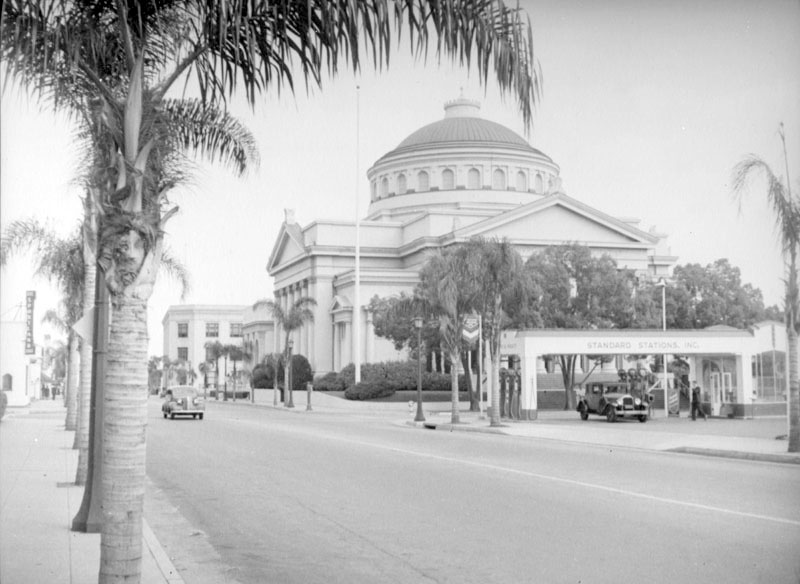 |
|
| (ca. 1939)* - Partial view of the First Church of Christ, Scientist, located at 80 Oakland Avenue in Pasadena. A Standard Stations, Inc. gas station is visible at middle right. |
Historical Notes The building recently underwent an 18-month restoration and seismic upgrade and is a contributing building in the Pasadena Playhouse Historic District. Click HERE for contemporary view. |
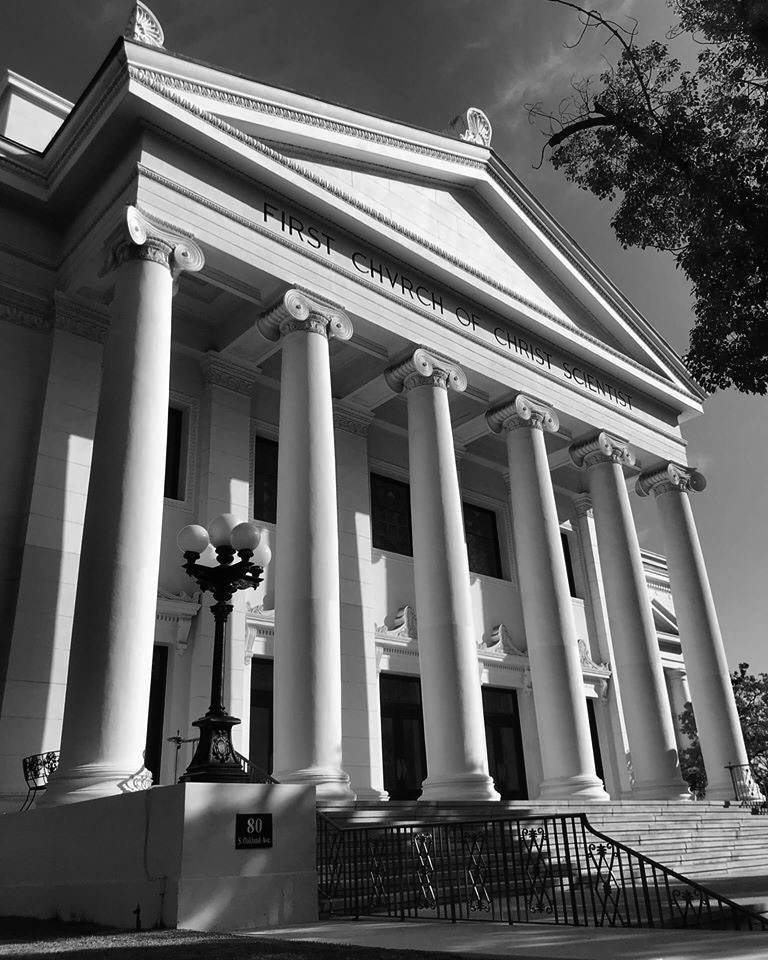 |
|
| (2020)^ - The old Classical Revival First Church of Christ Scientist located at 80 S. Oakland Ave in Pasadena. Photo courtesy of Valentino Herrera |
Pasadena Playhouse
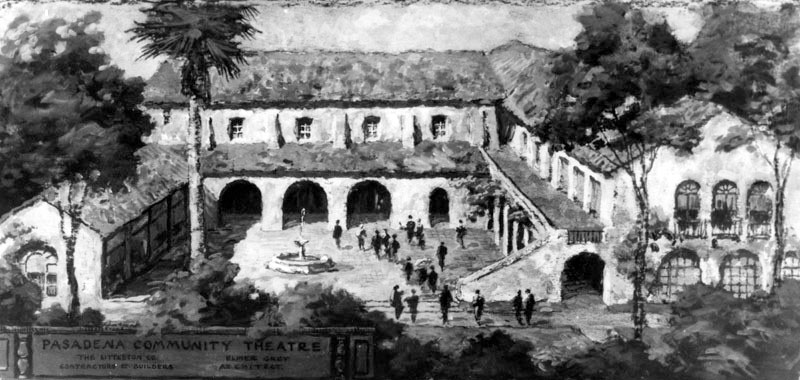 |
|
| (1920s)* - Architectural rendering of the Pasadena Playhouse with courtyard and fountain surrounded by buildings on 3 sides. Label reads: Pasadena Community Theatre |
Historical Notes Founded in 1917 by Gilmor Brown, the Pasadena Playhouse was designed by architect Elmer Grey and the cornerstone laid May 31, 1924. In 1928 the College of Theatre Arts was incorporated with the Pasadena Playhouse Association as a non-profit institution.* |
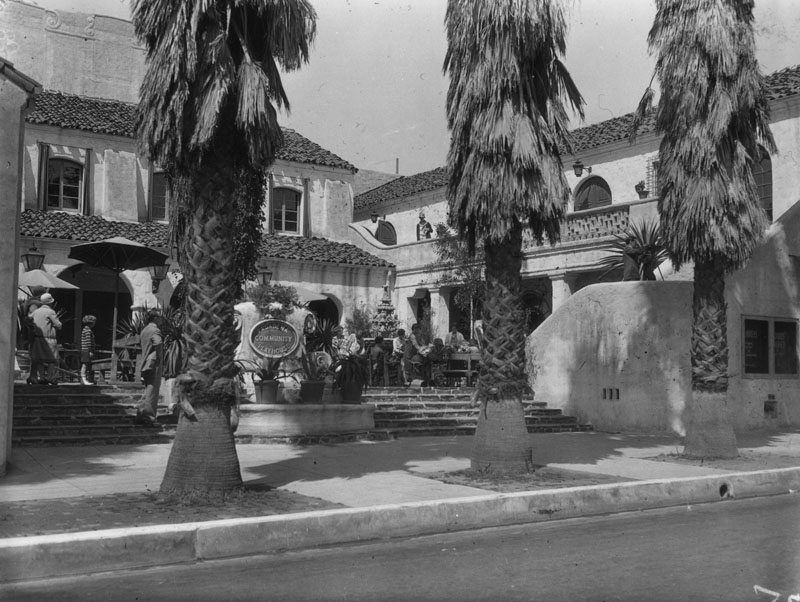 |
|
| (1930s)* - Exterior view of the entry and court of the Pasadena Playhouse, located at 39 S. El Molino Avenue. It was designed by architect Elmer Grey in Spanish Colonial Revival style and built in 1924-1925. |
Historical Notes A school of theatre arts was established in the late 1920s that became an accredited college by 1937, eventually training such notable talents as Raymond Burr, Victor Mature, Ernest Borgnine, Eleanor Parker, Charles Bronson, Mako, Jamie Farr, Gene Hackman, Dustin Hoffman, Sally Struthers and others.* |
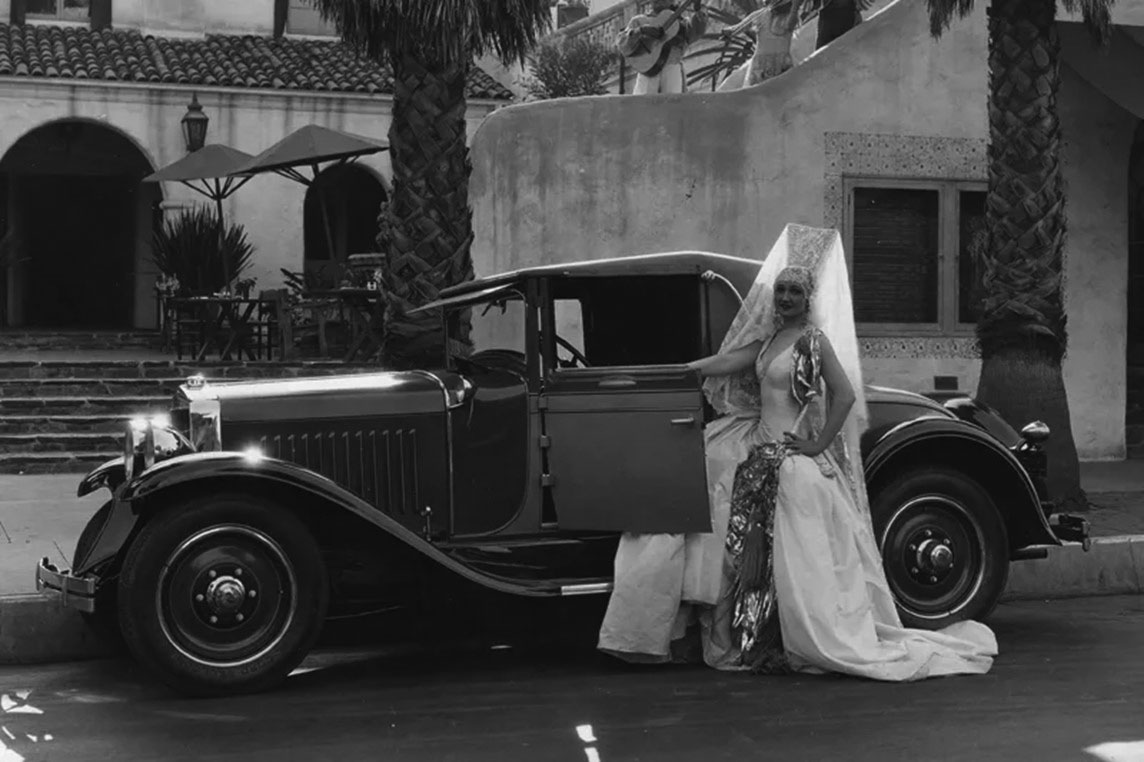 |
|
| (1930s)^ – A woman in costume poses by car in front of the Pasadena Playhouse. |
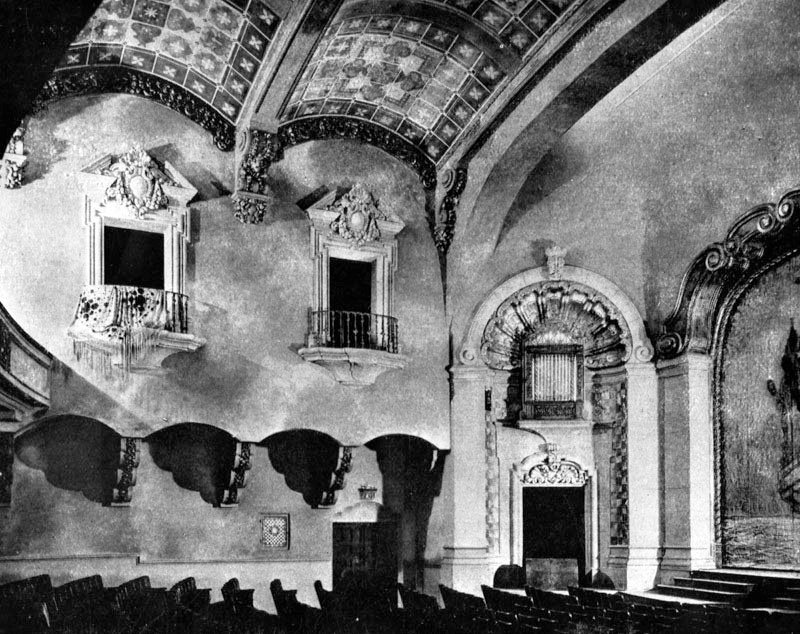 |
|
| (1925)* - The auditorium of the Playhouse, looking over the seats at the side wall where two balcony box seats can be seen. On the extreme left is the balcony itself, and on the extreme right the stage curtain. |
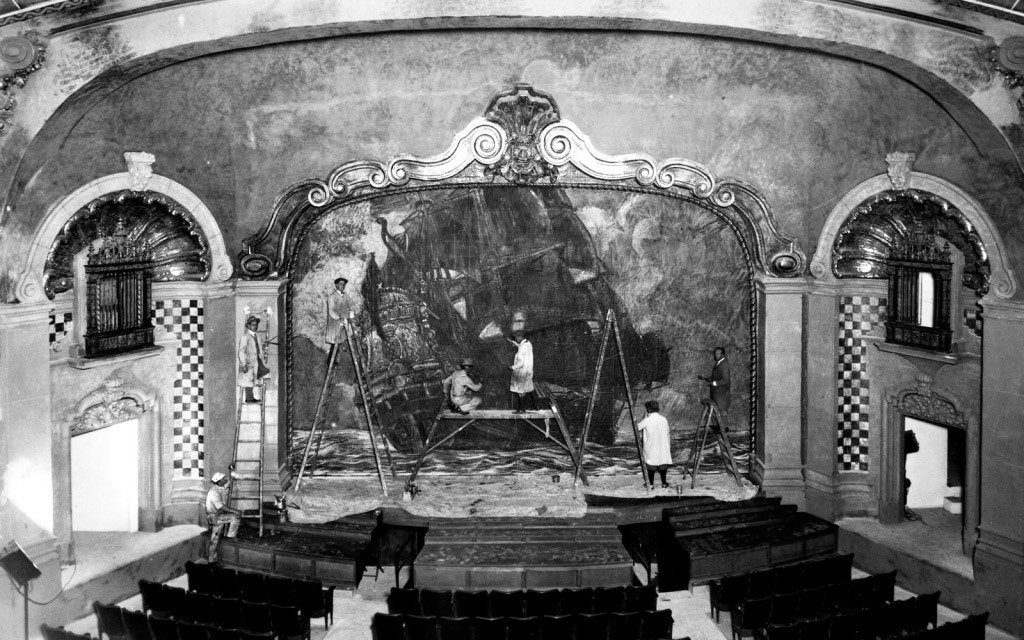 |
|
| (1925)* - Vintage image of the original Spanish galleon-adorned stage curtain being painted. (Photo courtesy of Pasadena Playhouse Archives) |
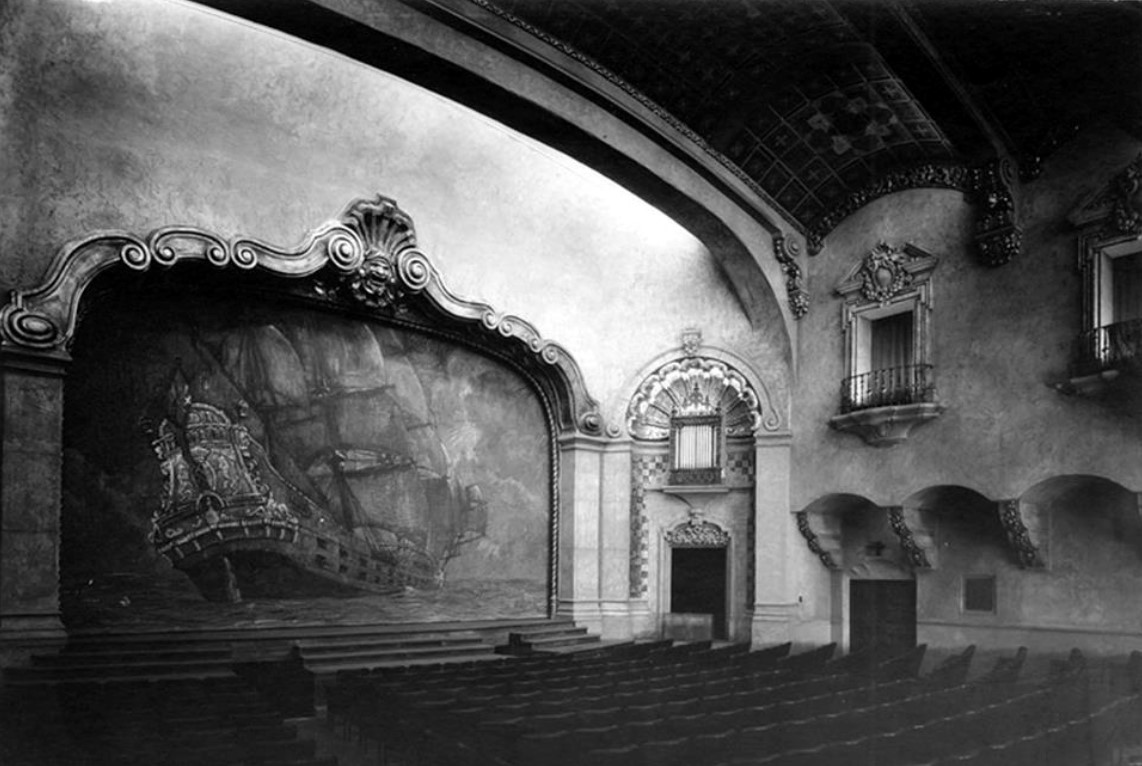 |
|
| (1930)^ - Interior view of the Pasadena Playhouse Auditorium. Back then it was known as the Pasadena Community Theatre. |
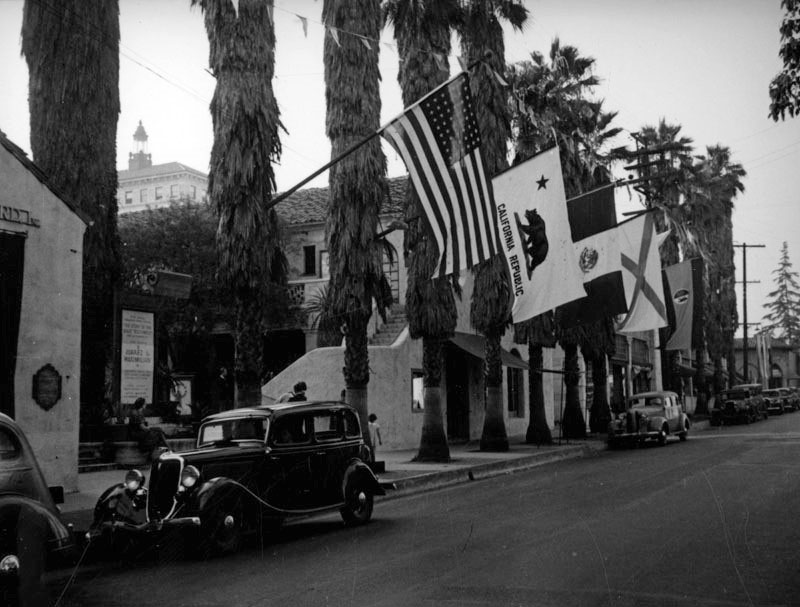 |
|
| (ca. 1937)* – View showing the entrance and courtyard of the Pasadena Playhouse, as seen from S. El Molino Avenue, with flags hanging from palm trees. |
Historical Notes The Playhouse was recognized by the Legislature as the State Theatre of California in 1937 after the laudable achievement of having performed the entire Shakespeare canon on a single stage for the first time in the United States. |
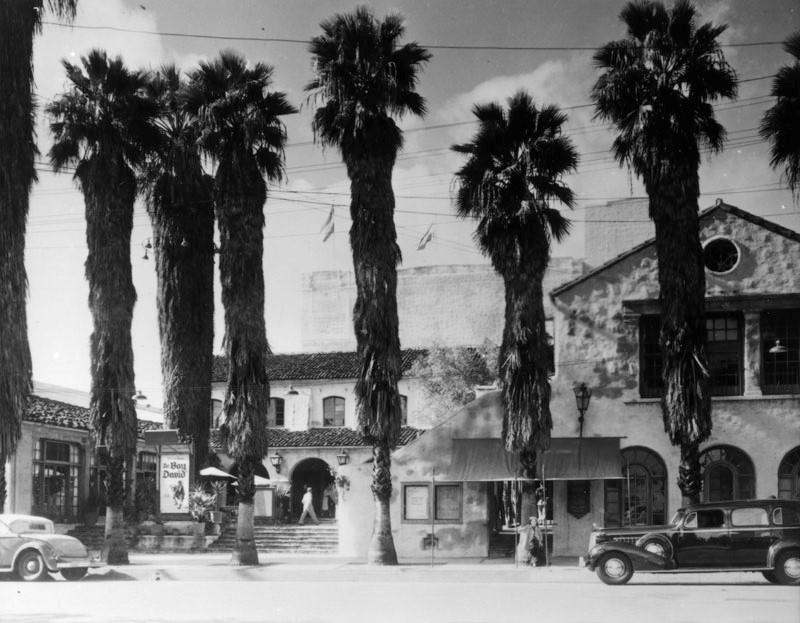 |
|
| (1939)* - Pasadena Playhouse as seen from the across the street. Large palm trees almost dwarf the theater. |
Historical Notes The Pasadena Playhouse drew the attention of the nation, bringing Southern California world premieres by authors such as Eugene O'Neill, William Saroyan, Noël Coward, F. Scott Fitzgerald and Tennessee Williams, as well as many English language premieres of significant Continental dramas.* |
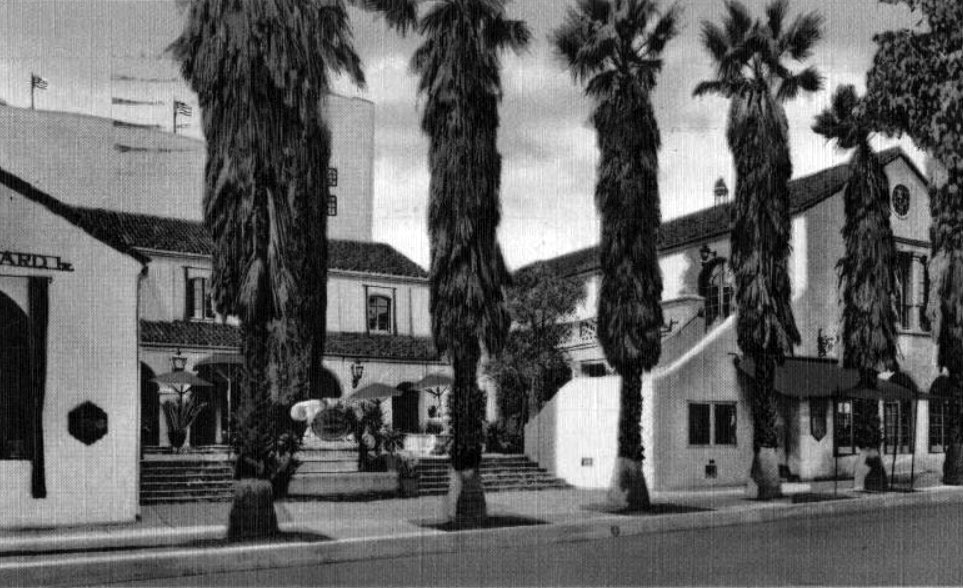 |
|
| (1944)*- Postcard view showing the front entrance and courtyard of the Pasadena Playouse. |
Historical Notes The Pasadena Playhouse was designated California Historical Landmark No. 887 (Click HERE to see more California Historical Landmarks in LA County). |
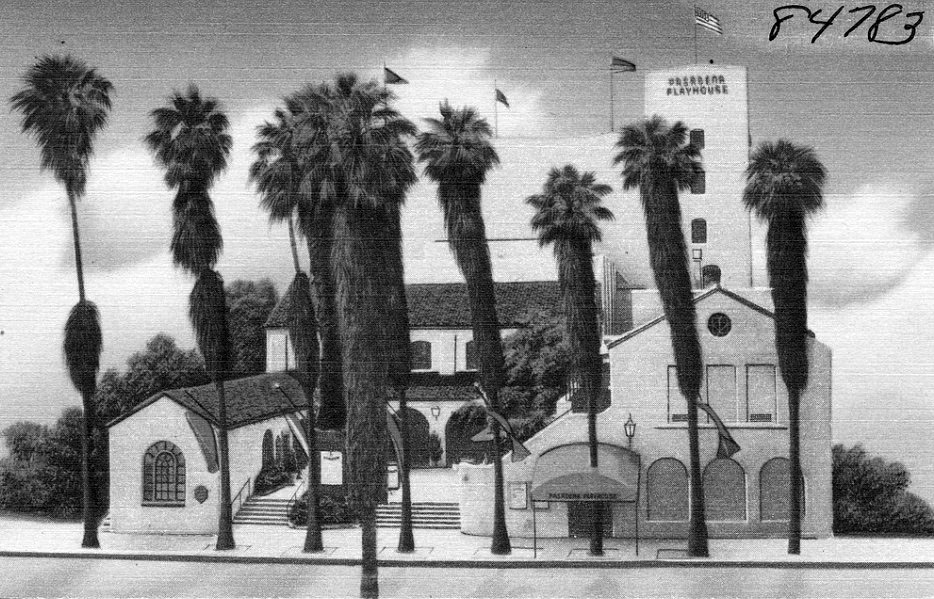 |
|
| (1940s)^ – Postcard view showing the Pasadena Playhouse fronted by a line of mature palm trees. |
Historical Notes A Spanish Colonial Revival building with Mission elements, the Playhouse is centered around a courtyard enclosed on three sides. Paved in flagstone and surrounded by arcades, the central courtyard is raised above street level. The composition of the building is asymmetrical and informal, almost residential in scale. The stucco walls are textured and irregular to resemble adobe and masonry construction. |
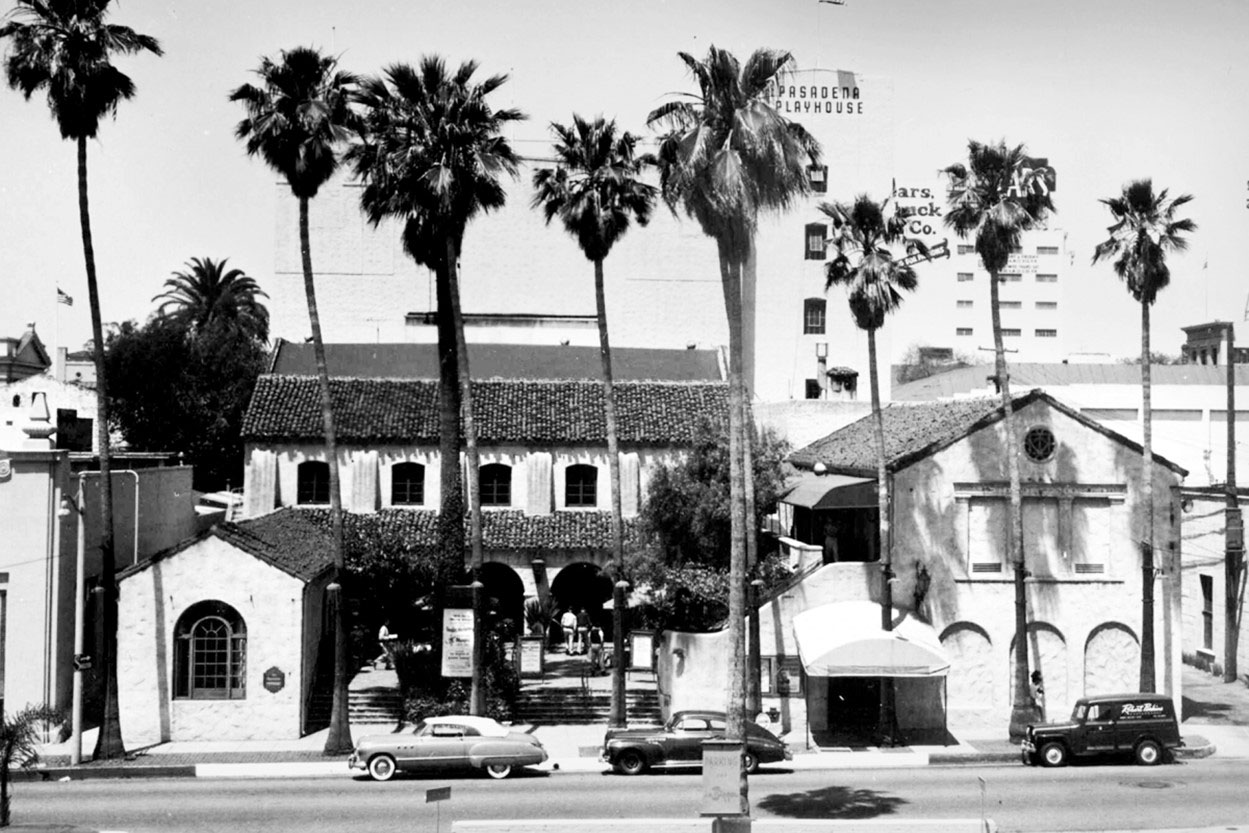 |
|
| (ca. 1951)^ – View looking west over parking lot and S. El Molino Ave showing the Pasadena Playhouse. (Photo courtesy of Pasadena Playhouse Archives) |
Historical Notes The adjacent six-story concrete school Fannie E. Morrison Annex building was designed by J. Cyril Bennett in 1936 to house the School of Theatre Arts, an accredited college. |
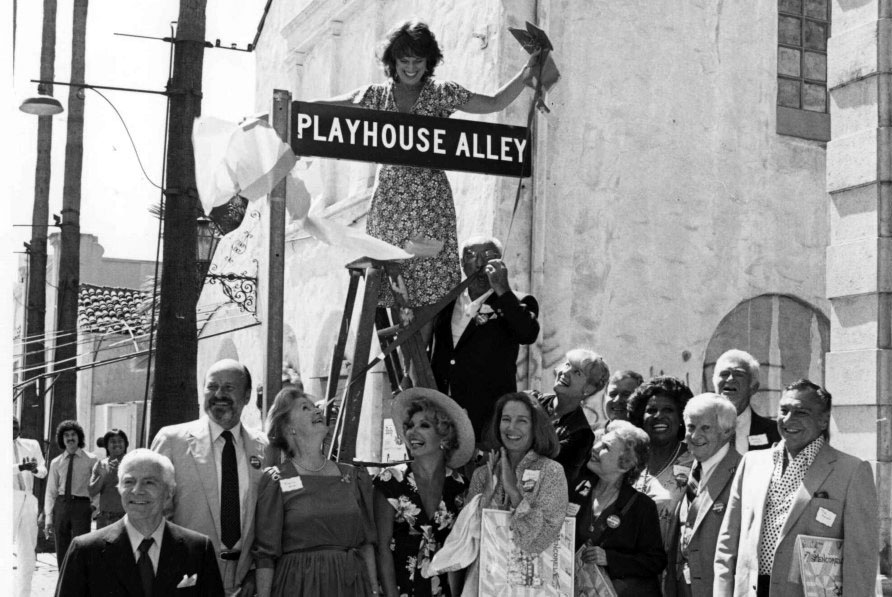 |
|
| (1982)^ – View showing dedication of the Pasadena Playhouse (Playhouse Alley) with Ruth Buzzi seen on ladder. (Photo courtesy of Pasadena Playhouse Archives) |
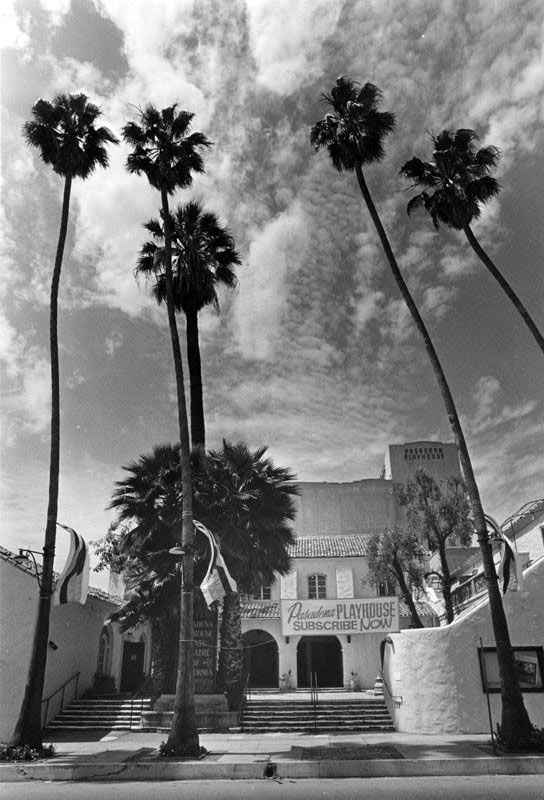 |
|
| (1987)* – Front view of the Pasadena Playhouse with trimmed palm trees near the curb. Sign in front of the playhouse reads: Pasadena Playhouse - Subscribe NOW. LA Times caption reads: Hoping to attract a new Playhouse audience, developer David Houk, who controls the theater under an agreement with the City of Pasadena, hired producers Susan Dietz and Steve Rothman, both of whom have established records. Photo Dated: May 1, 1987. |
Historical Notes Due to changes in Actors' Equity Association laws, and the opening of drama departments in many schools and universities across the country, the School of Theatre Arts shut down in 1969. Later that year, after the death of founding director Gilmor Brown, the theatre itself went bankrupt. After six years, the city bought the building in 1975 and later transferred it to real estate developer David Houk. After 17 years of lying dormant, he relaunched the theatre in 1986 as a place to develop shows that would tour other California venues. While the Pasadena Playhouse reopened for use as a community theatre, the acting school remained closed. Over the next twenty years, the theatre staged classic drama, new musicals and plays, and integrated itself as an educational facility, slowly regaining a prominent place in the national theatre scene to become a major operation of over 8 million dollars a year by 2008.* |
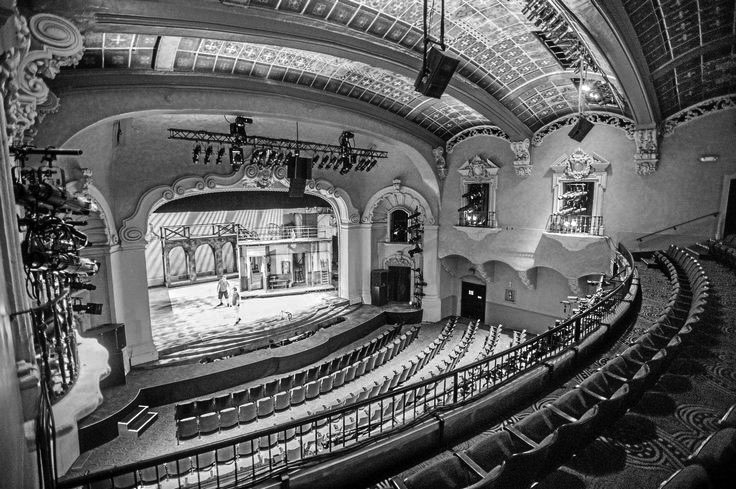 |
|
| (2014)^ - Pasadena Playhouse after renovation, including new seats and carpets. Photo by Watchara Phomicinda |
Historical Notes In Sept. 2014, the historic theatre received a makeover with new carpet and seats as it geared up to look good for its 100th birthday in 2017. |
Then and Now
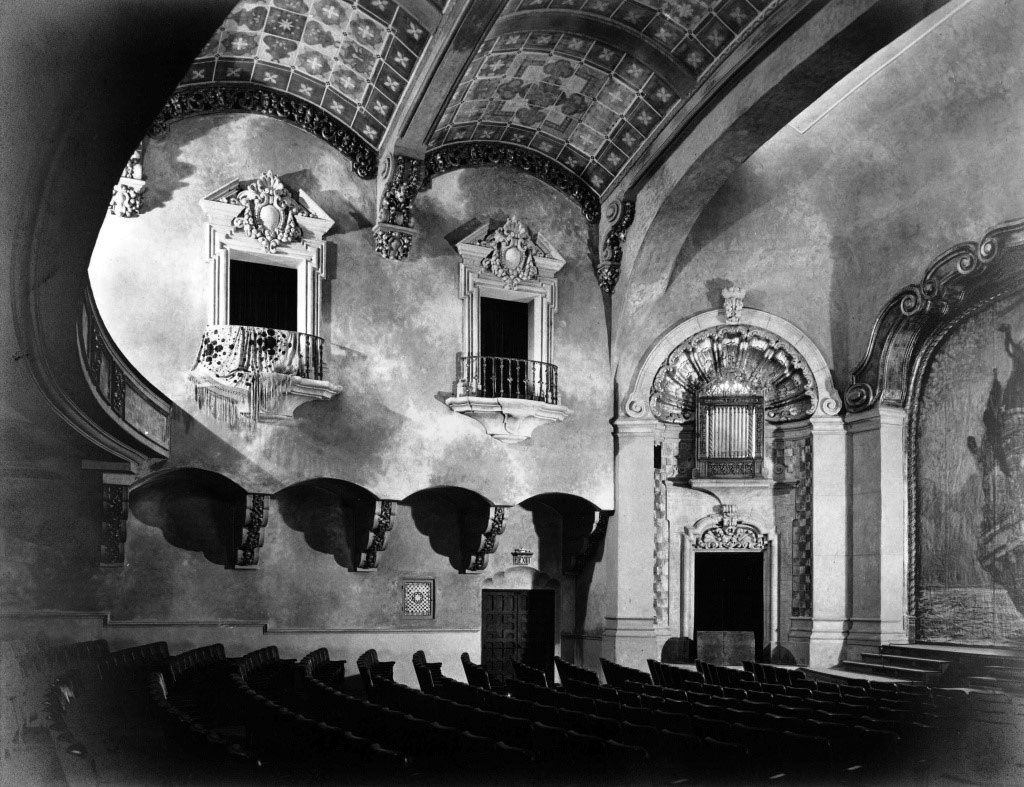 |
|
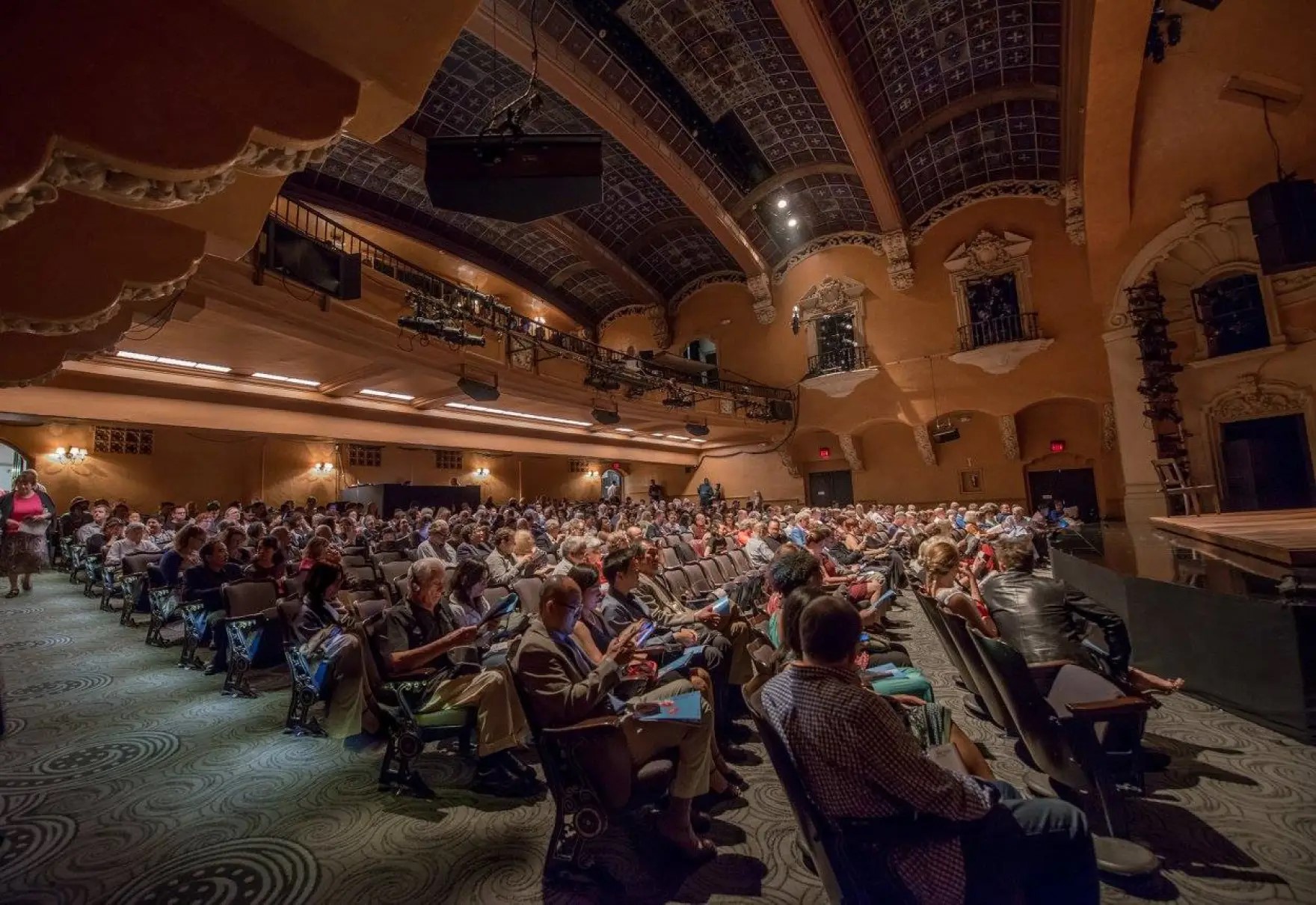 |
|
| (1925 vs. 2017)* - Pasadena Playhouse (originally Pasadena Community Playhouse) celebrated its 100 year anniversary in 2017. |
Historical Notes Opened in 1925 as the Pasadena Community Playhouse. The Playhouse quickly became a hub of the theatre community west of the Mississippi River. |
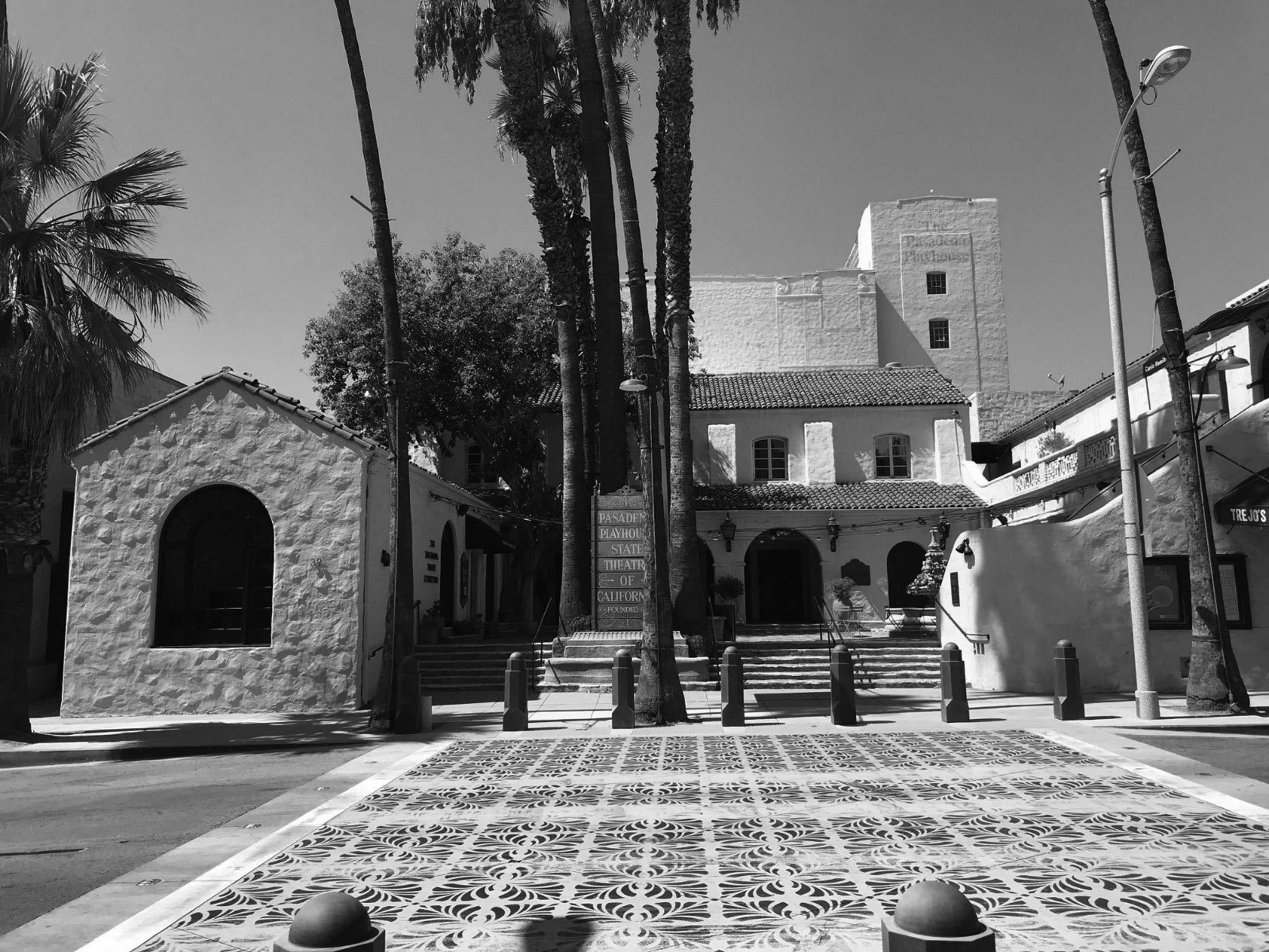 |
|
| (2019)^ - The Pasadena Playhouse, built in 1925, shares mission-style architecture with many other Pasadena buildings from that decade. Photo courtesy of Valentino Herrera |
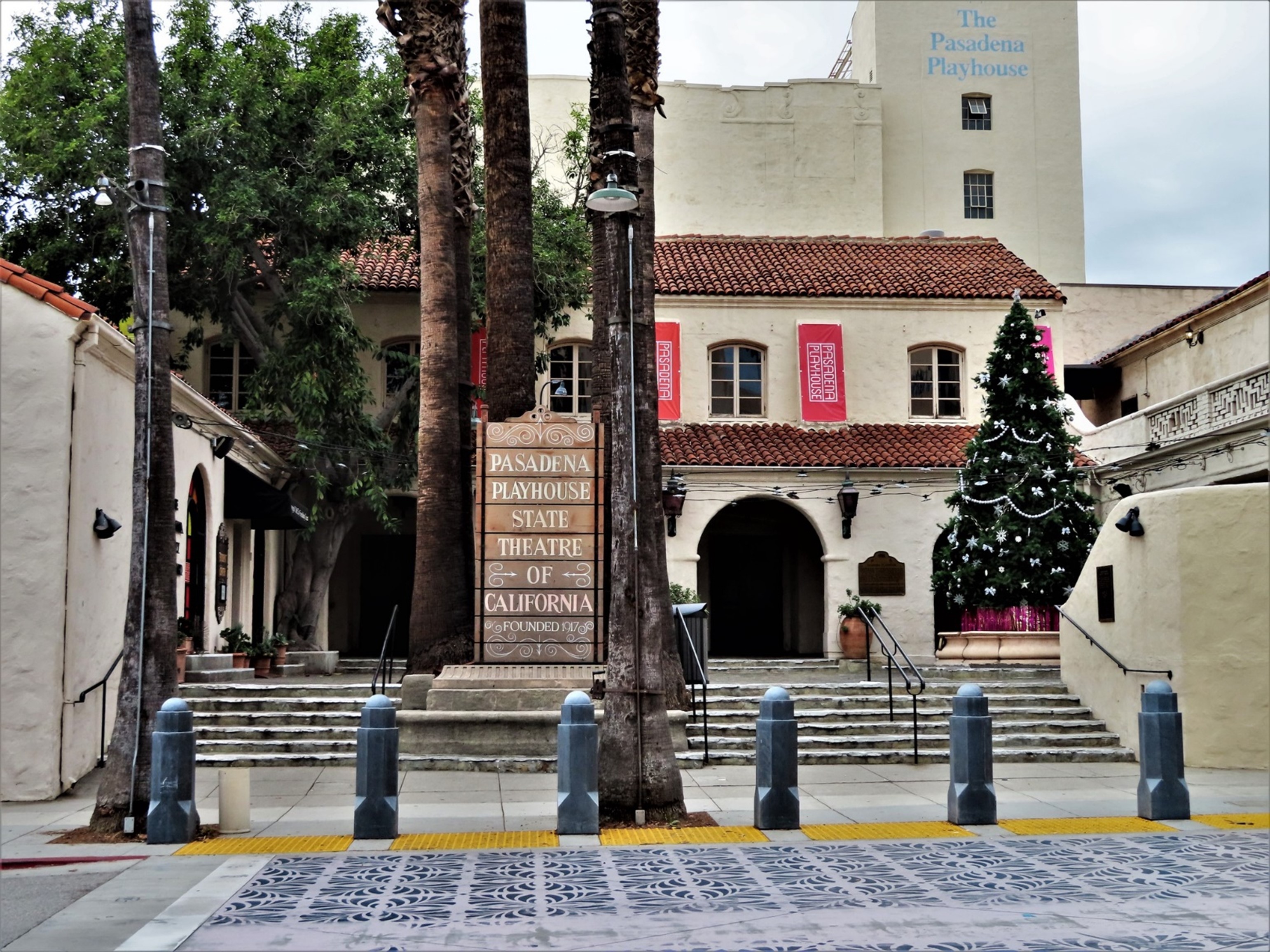 |
|
| (2021)^ - Contemporary view of the Pasadena Playhouse – The State Theatre of California. Photo by Howard Gray |
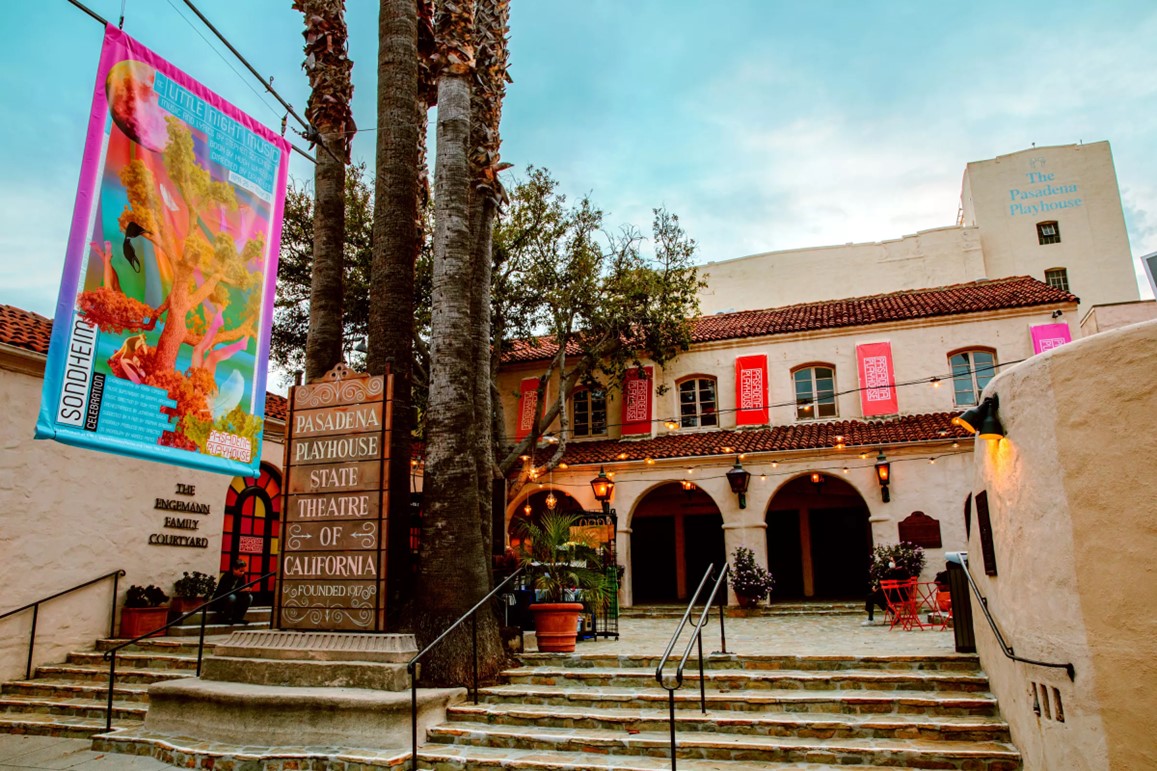 |
|
| (2023)* - Pasadena Playhouse, the State Theatre of California, recipient of the 2023 Regional Theatre Tony Award. Photo by Jeff Lorch |
Historical Notes Pasadena Playhouse received the 2023 Regional Theatre Tony Award, becoming only the second Los Angeles institution to earn the honor.* |
Then and Now
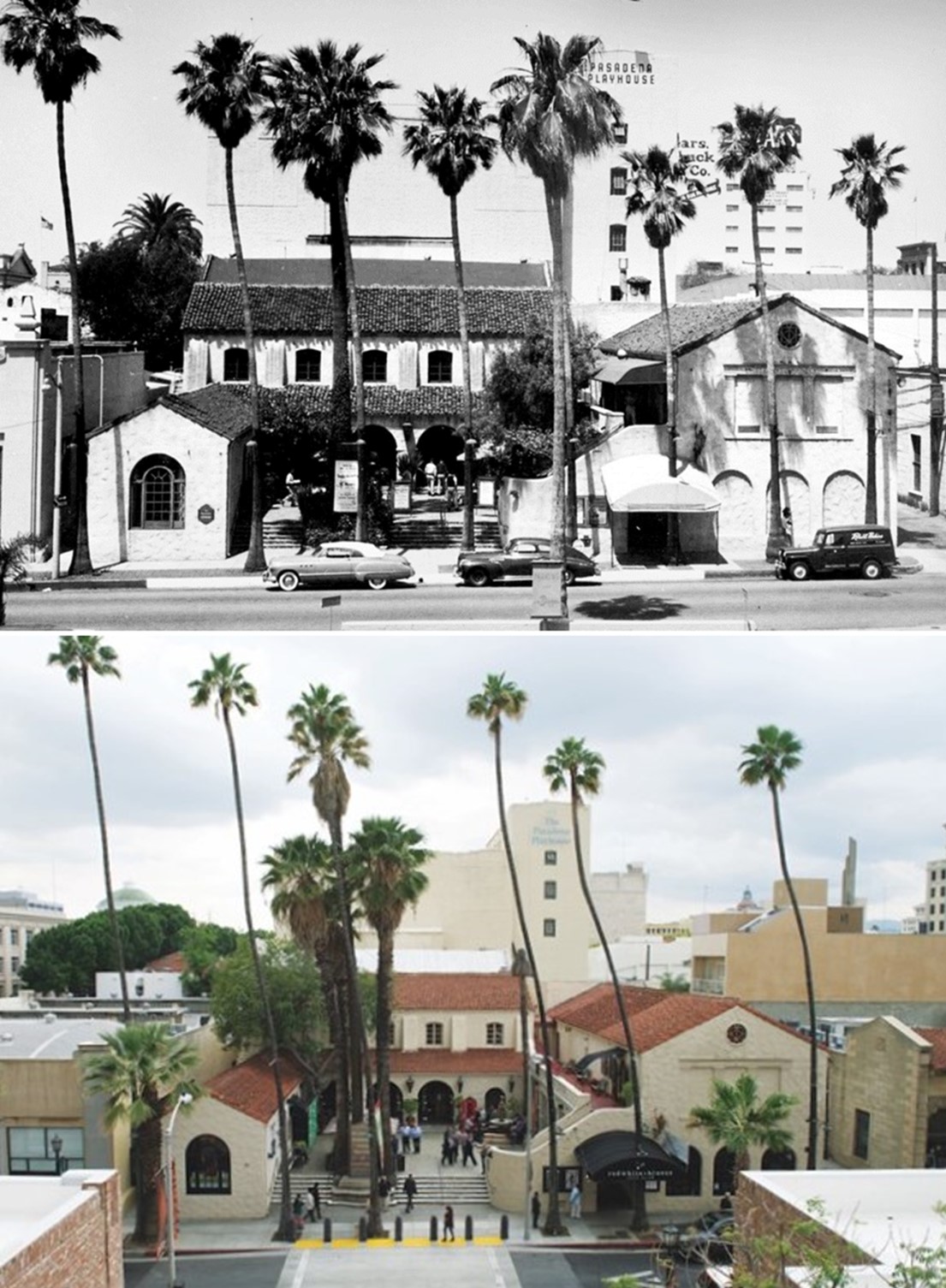 |
|
| (1951 vs 2022)* - Pasadena Playhouse |
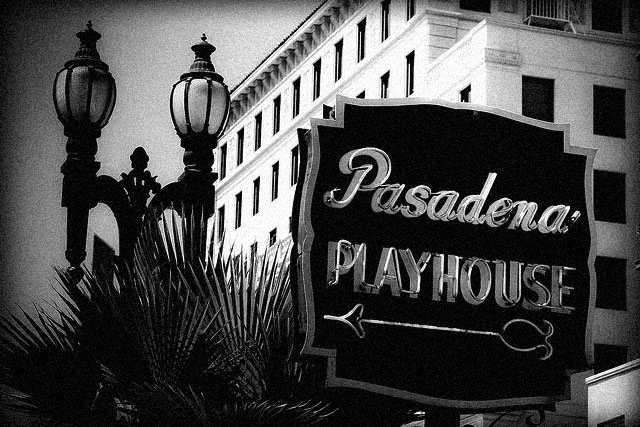 |
|
| The historic Pasadena Playhouse is located at 39 S. El Molino Avenue in the heart of Pasadena. The above sign is on Colorado Boulevard just north of the theatre. |
* * * * * |
Clune's Pasadena Theater (later Fox Pasadena Theater)
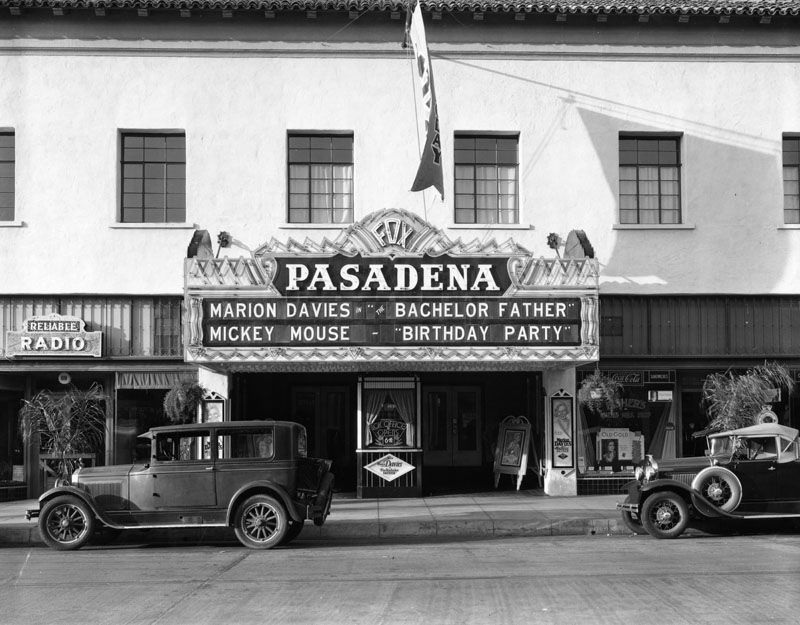 |
|
| (1931)* - Close-up view of the Pasadena Theater box office and marquee located at 61 W. Colorado Blvd. Early model cars are parked on the street. Double Feature: "Bachelor Father" with Marion Davies and "Birthday Party" with Mickey Mouse. |
Historical Notes The theatre opened as Clune's Pasadena Theatre in 1911, a project of pioneer showman Billy Clune. His best known theatre was Clune's Broadway, still around as the Cameo Theatre. Clune was also a film producer with his own studio, now a part of Raleigh Studios. Clune's Pasadena once had a rooftop sign with over 2,000 lamps. In addition to the theatre, the building had ground floor stores and a space housing the Pasadena Athletic Club. The venue was later operated by Fox West Coast and known then as the Fox Pasadena. Fox closed the theater in 1953.*## |
.jpg) |
|
| (1911)*## - Interior view of the Clune's Pasadena Theater opening night, March 1, 1911. Every seat in the house is filled with patron eager to experience Pasadena’s newest film and vaudeville theater. |
Historical Notes The opening night show was all live acts including singer Lilly Dorn, a saxophone sextet, and storyteller Frank M. Clark. The Clune's Pasadena Theater, located near Colorado Street and Delacey Avenue, later became the Fox Pasadena Theater and was in operation until the 1950s.*^^* |
* * * * * |
Colorado Street Bridge
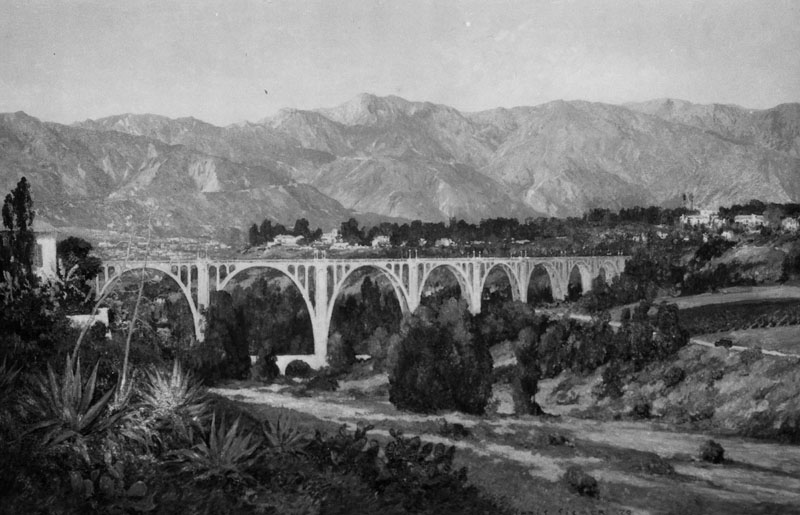 |
|
| (ca. 1930)* - Panoramic View of the Colorado St. Bridge with the San Gabriel Mountains in the background. This is a photograph of a Chris Siemer painting created for a display by the L.A. Chamber of Commerce. |
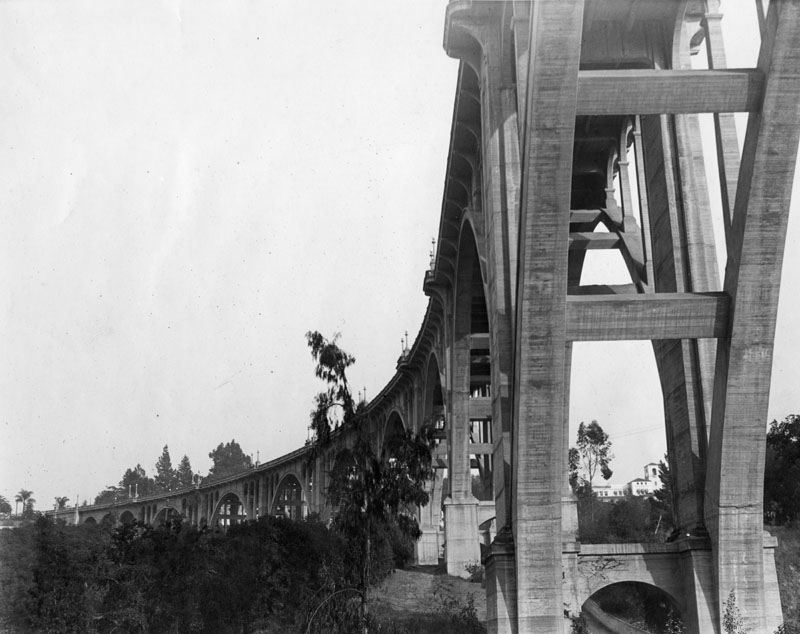 |
|
| (ca. 1930)* - Scenic view of the Colorado Street Bridge showing the length of the bridge as it curves across the ravine. Part of the Vista Del Arroyo Hotel can be seen through the arches. |
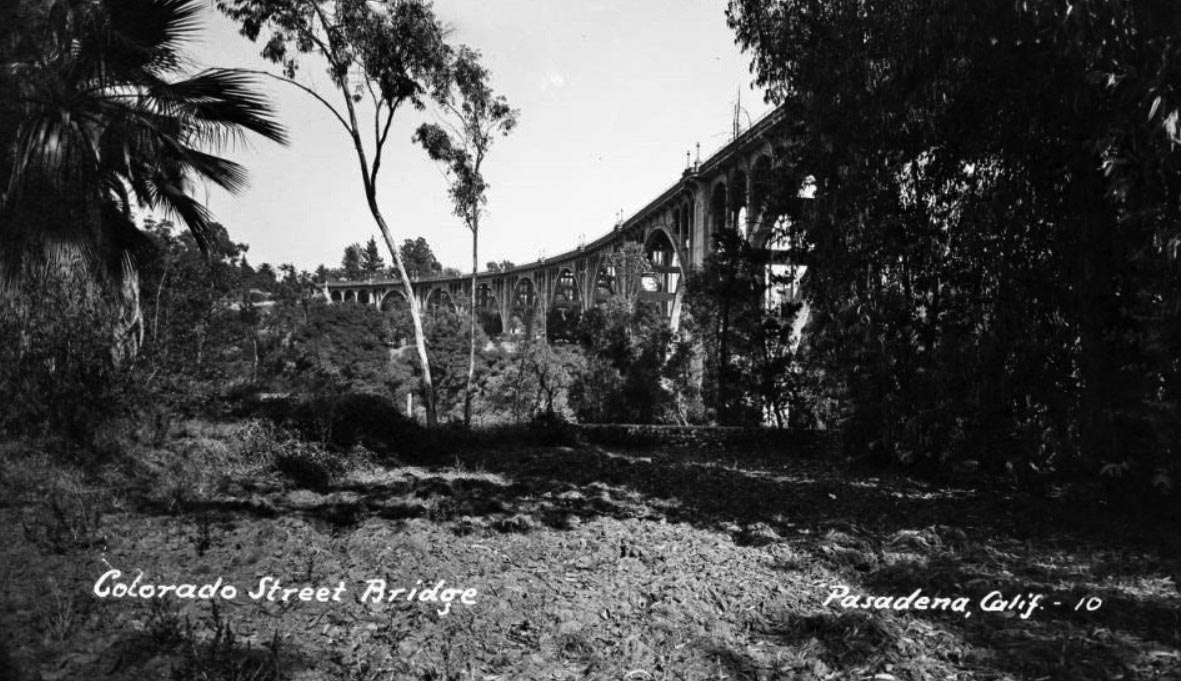 |
|
| (1946)#* – Postcard view showing trees and foliage in the Arroyo Seco canyon, and the Colorado Street Bridge spanning across it. |
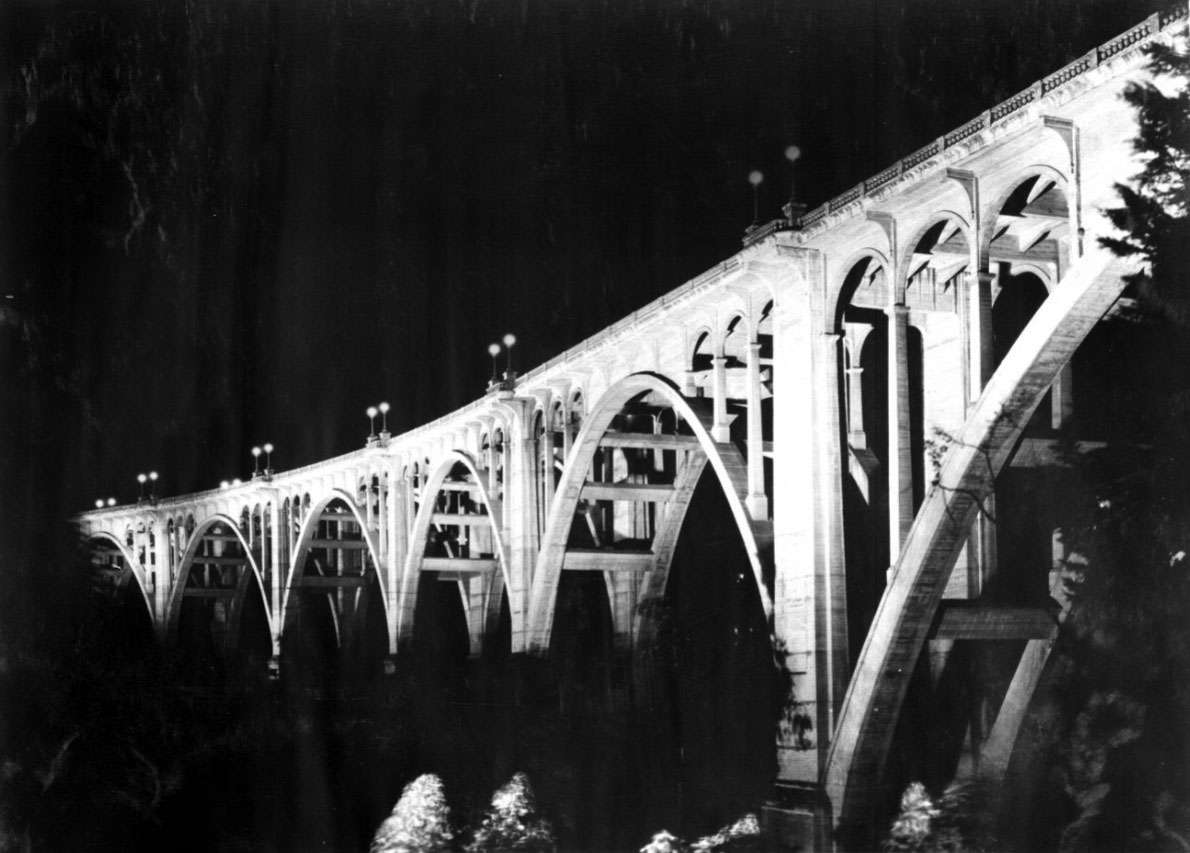 |
|
| (1930)^x^ – Night view showing the Colorado Street Bridge illuminated by 1000-watt floodlights. |
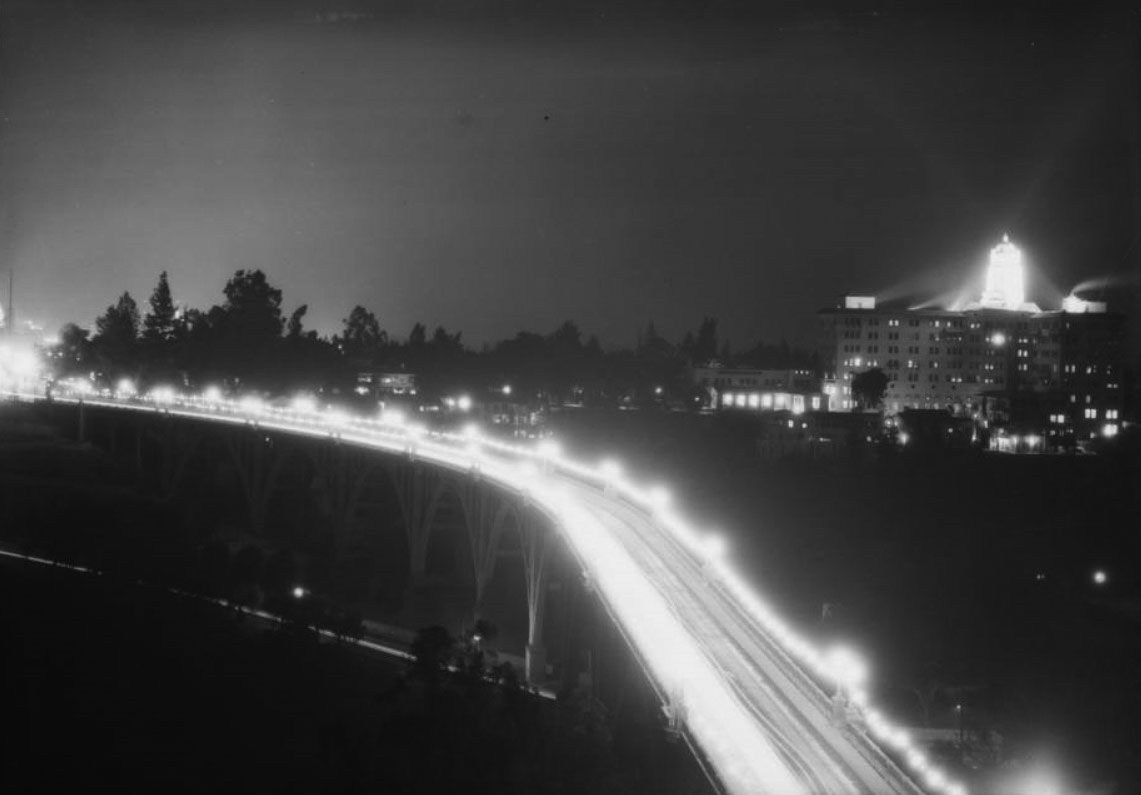 |
|
| (ca. 1930)^ – Night view showing the Colorado Street Bridge and the Hotel Vista del Arroyo, both lit up during the holidays. |
Vista Del Arroyo Hotel
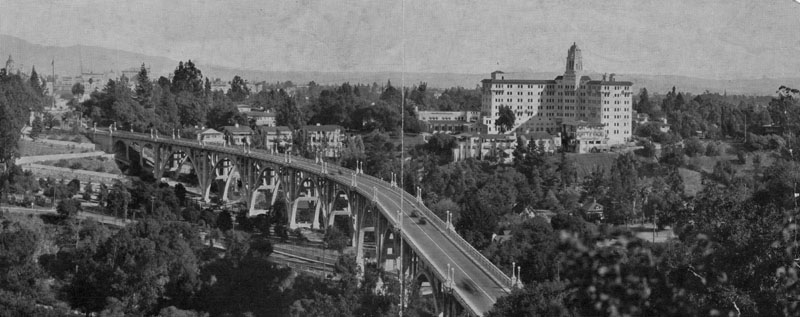 |
|
| (ca. 1931)* - View of the Colorado Street Bridge, looking southeast with the Vista Del Arroyo Hotel to the right. |
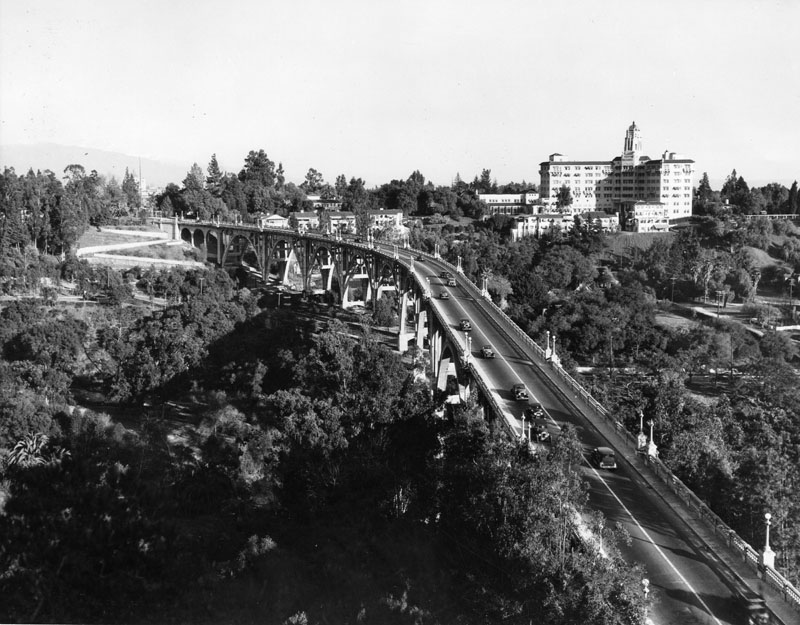 |
|
| (ca. 1931)* - View of the Colorado Street Bridge, looking southeast. The new additon to the Vista Del Arroyo Hotel is seen on the right. |
Historical Notes In 1926, the Vista Del Arroyo Hotel and resort was sold to H.O. Comstock. Comstock hired architect George H. Wiemeyer to redesign the hotel and added a grand six-story addition that consisted of a central bell tower and flanking wings set at an angle. The new Vista opened in 1931 with iridescent color, entertainment, and social gaiety. In 1936, Linnard repurchased the property and hired landscape architect Verner S. Anderson to improve the hotel's grounds by designing formal gardens and adding fountains, tennis courts, and a swimming pool. |
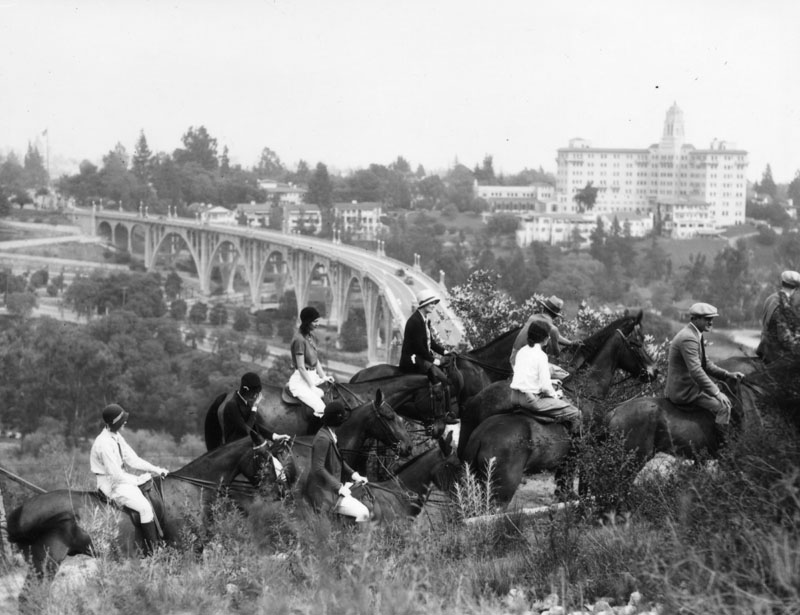 |
|
| (Early 1930s)* - Photo of horseback riders in the Arroyo Seco, overlooking the Colorado Street Bridge. The Vista Del Arroyo Hotel is on the right. |
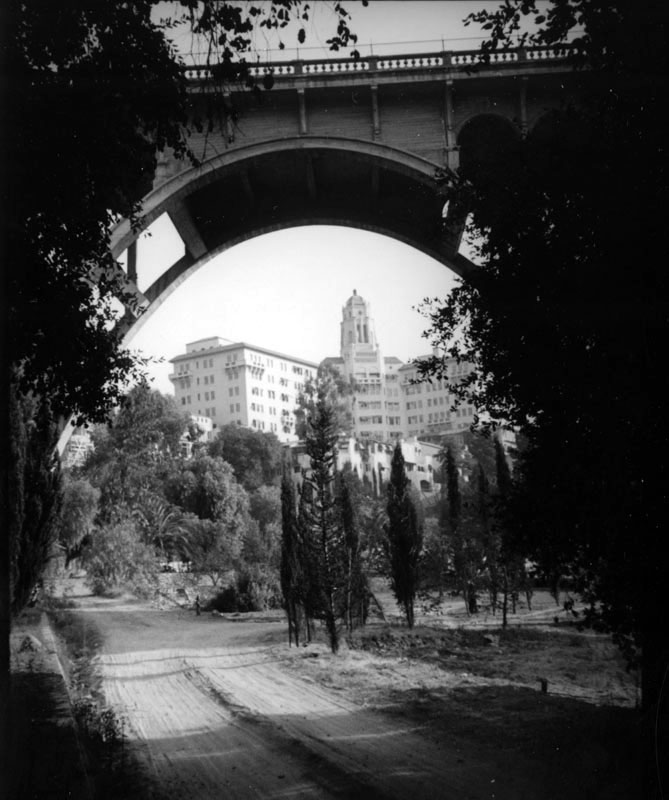 |
|
| (ca. 1937)* - This view of the Vista del Arroyo Hotel in Pasadena shot through the Colorado Street bridge captures a dirt path lined with Cypress trees leading through the lush arroyo. |
Historical Notes Marston and Van Pelt designed the Vista del Arroyo Hotel in 1920 and in 1930 George Wiemeyer added the tower. Myron Hunt designed some of the bungalows. * |
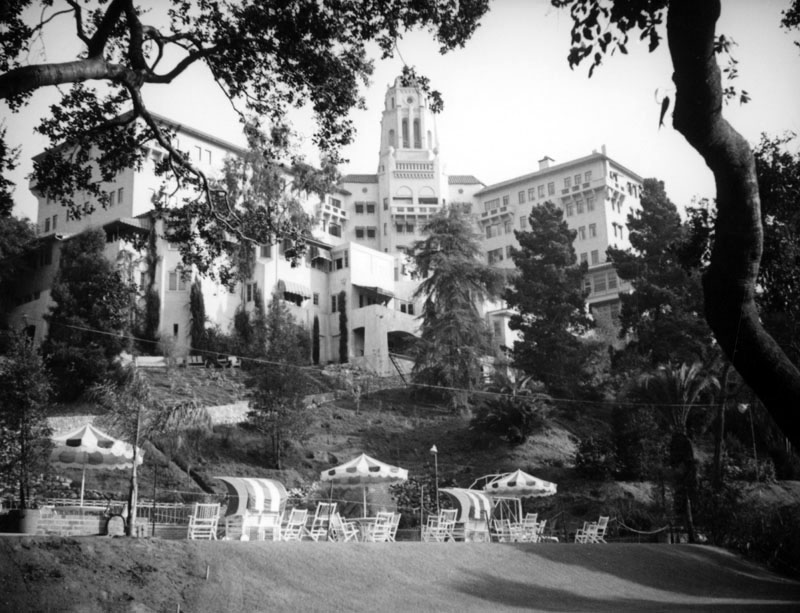 |
|
| (ca. 1937)* - View of the Vista del Arroyo Hotel taken from the arroyo includes the pool area, some of the lower buildings not commonly seen, as well as a long walkway joining the pool to the hotel. |
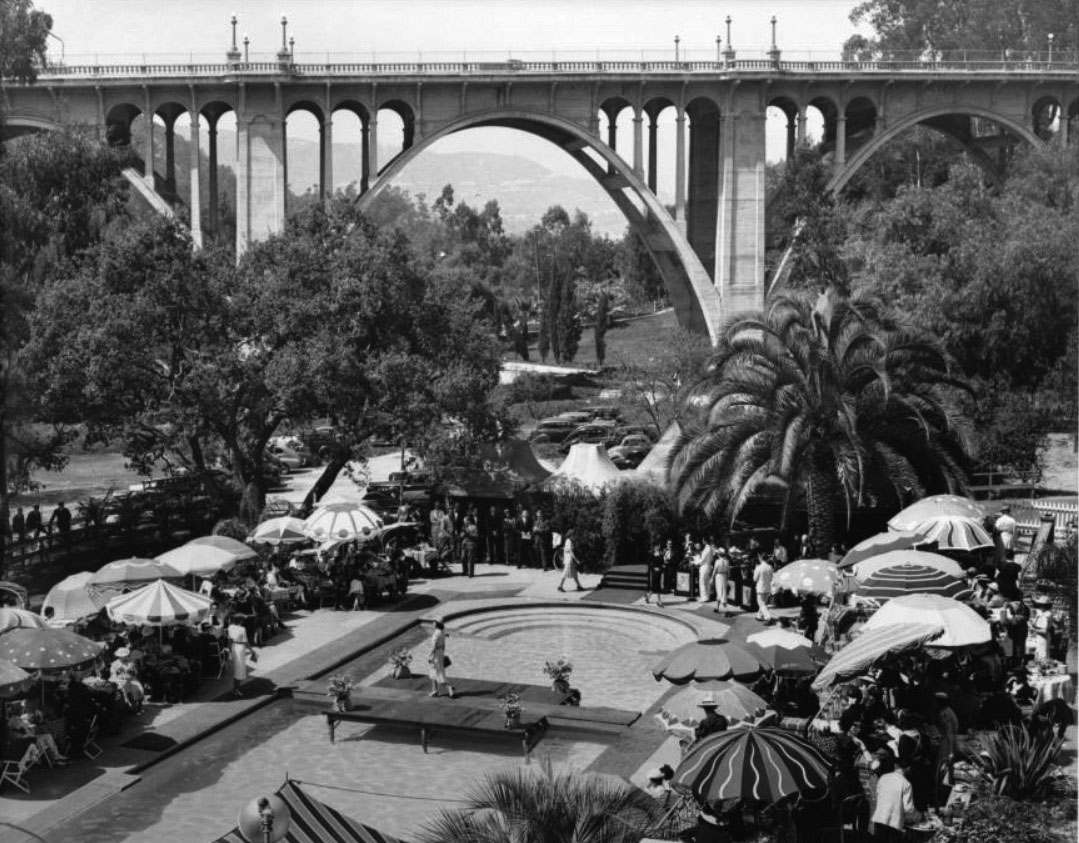 |
|
| (ca. 1940)^ – View looking across the swimming pool area of the Hotel Vista del Arroyo where it appears a fashion show is taking place. The Colorado Street Bridge is seen in the background. |
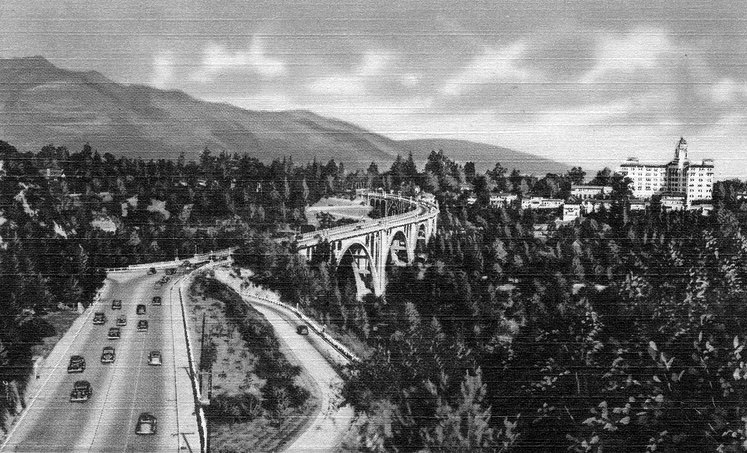 |
|
| (ca. 1940)++* – Postcard view showing the Colorado Street Bridge and the Vista del Arroyo Hotel. |
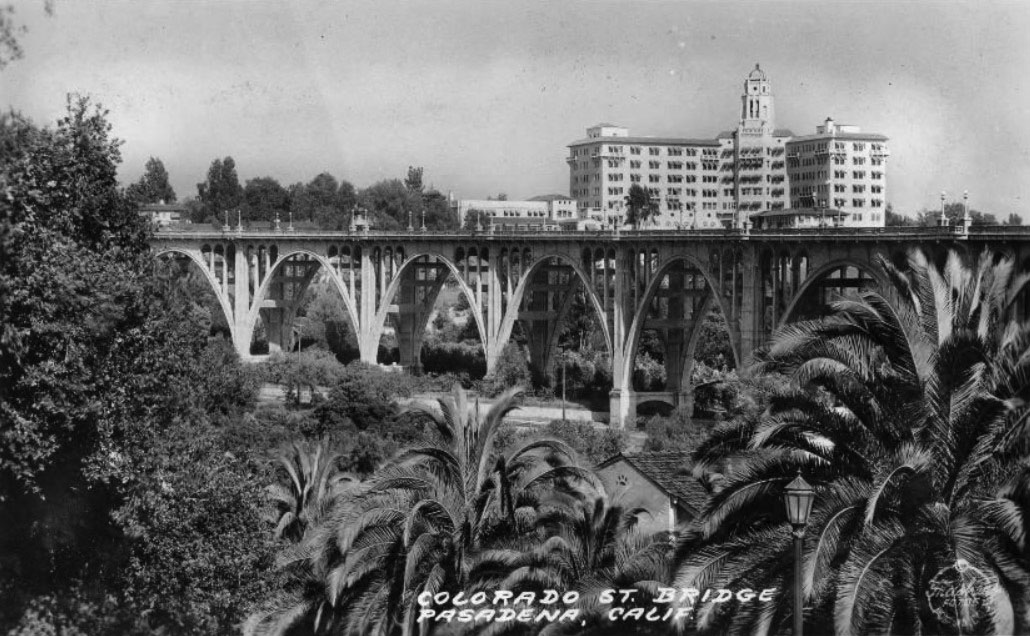 |
|
| (1940)^++ – Postcard view showing the Colorado Street Bridge and Vista del Arroyo Hotel with palm trees in the foreground. |
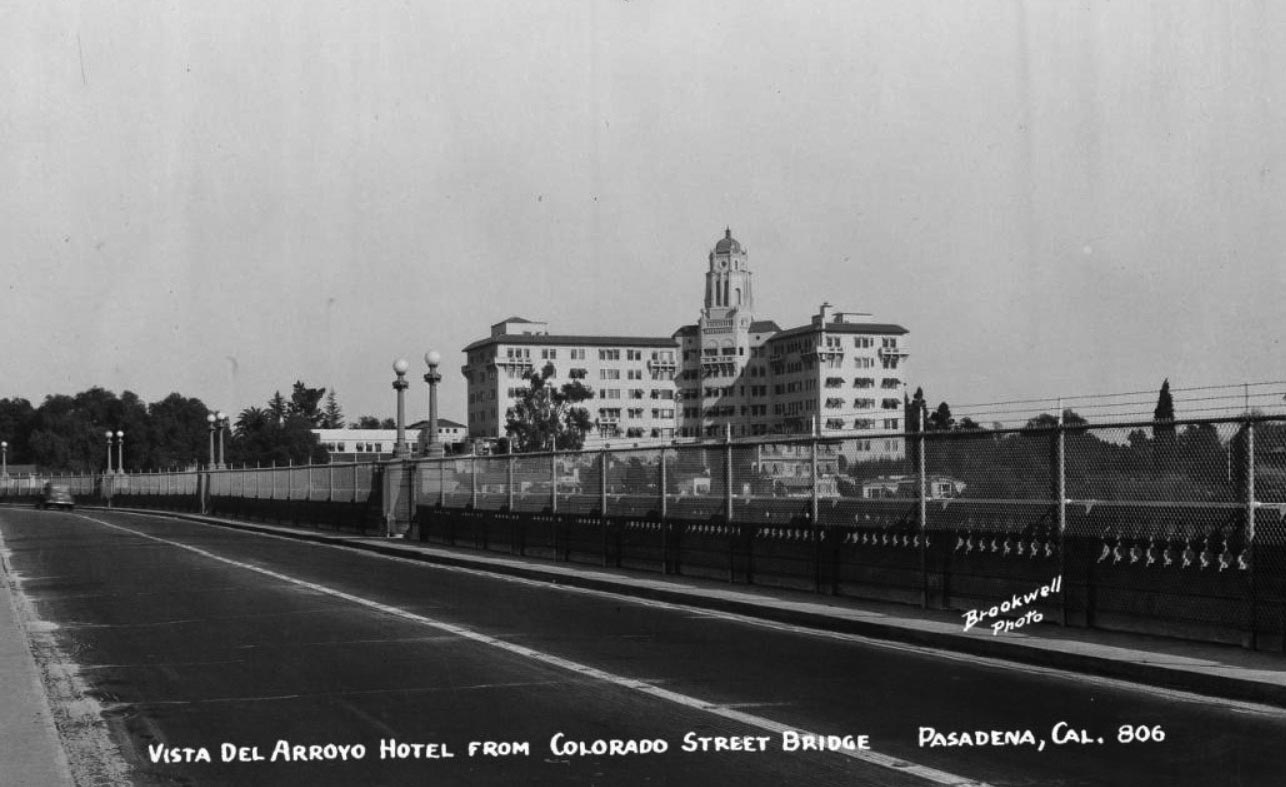 |
|
| (ca. 1943)#* – Postcard view showing the Vista del Arroyo Hotel as seen from the Colorado Street Bridge. The hotel was converted to a hospital in 1943, near the time of this photo. |
Historical Notes In 1943 the U.S. War Department acquired the hotel complex and converted it into the McCormack Army Hospital and offices for the U.S. Army. In 1949, the hospital was deactivated and the old hotel, under the care of the U.S. General Services Administration (GSA), housed a variety of Federal agencies from 1951 to 1974. In 1981 the Vista del Arroyo was placed in the National Register of Historic Places and GSA began design work to restore the building as the southern seat of the Ninth Circuit Court of Appeals. In 1995, the building was renamed to honor Judge Richard H. Chambers, whose concept it was to bring a Federal courthouse to Pasadena.*^ |
Click HERE to see more early views of the Colorado Street Bridge. |
* * * * * |
South Pasadena Middle School
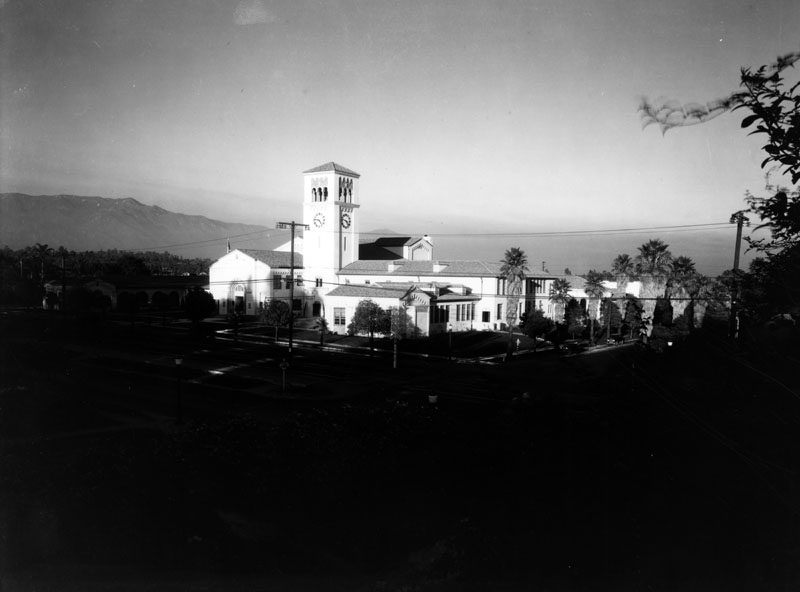 |
|
| (ca. 1932)* - Exterior view of South Pasadena Middle School, formerly known as a junior high. The attractive campus, located on the corner of Fair Oaks Boulevard and Oak Street (both are slightly visible in the foreground), includes a number of Italian style buildings. The San Gabriel Mountains are visible in the background. |
Historical Notes In 1924, bonds were passed to make money available to purchase the site for a junior high school. The town then waited for the population to grow which would necessitate construction. In 1927, $555,000 was budgeted for erection and equipping of the junior high school. In mid-January, 1928 the ground was broken for the Junior high and on September 10, 1928 the school officially opened.^# |
.jpg) |
|
| (ca. 1932)* - Closer view of the South Pasadena Middle School campus with clock tower at right. |
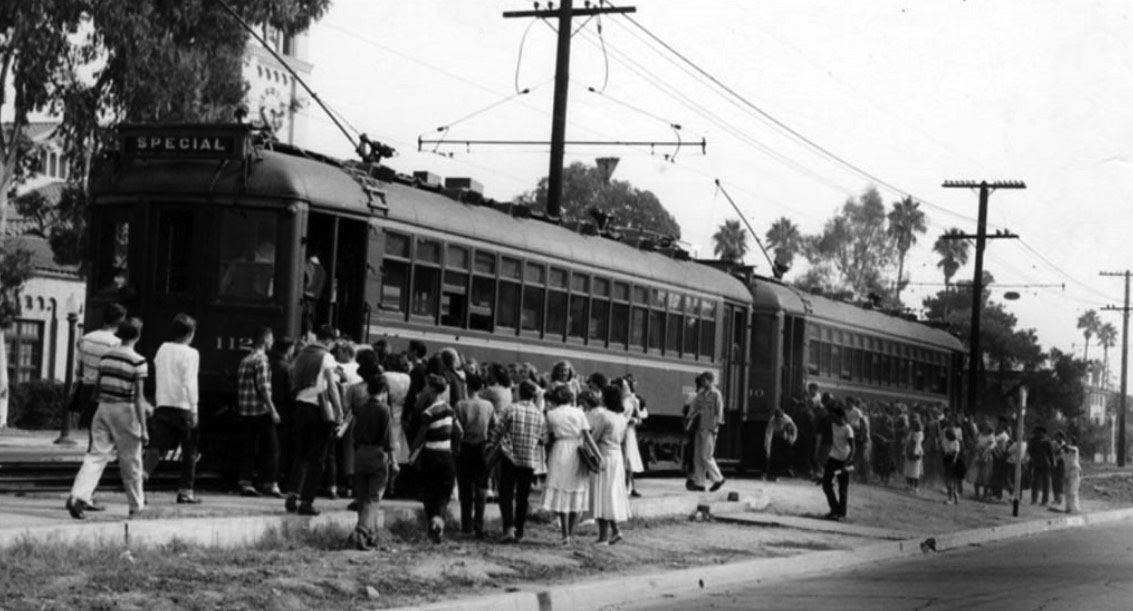 |
|
| (ca. 1945)^.^ – Students board the PE Red Car at Fair Oaks above Oneonta Junction. The South Pasadena Junior High clock tower can be seen in the background. |
Oneonta Park Junction (South Pasadena)
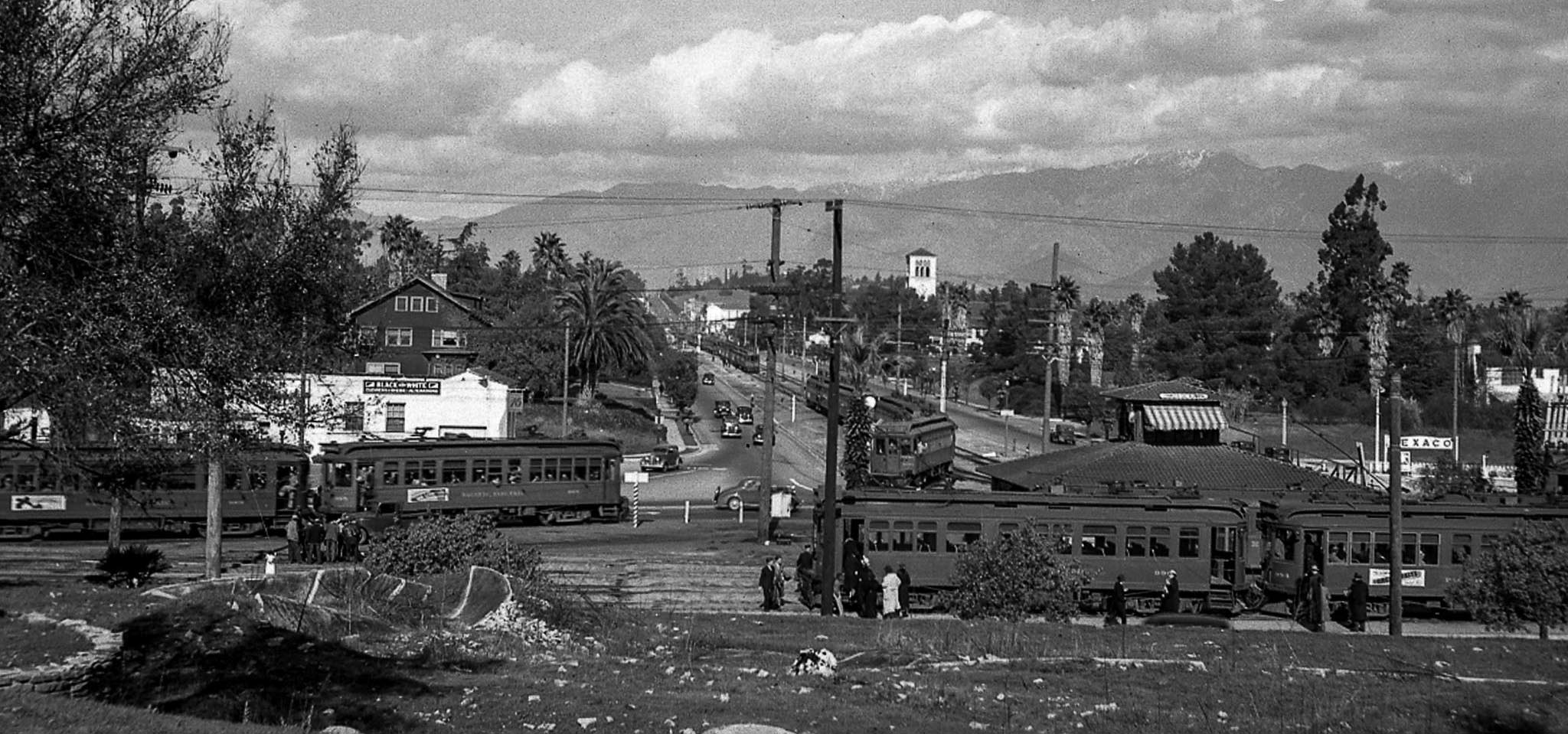 |
|
| (1937)+++ - Panoramic view looking north showing Pacific Electric streetcars gathered at the Oneonta control tower at Huntington Drive and Fair Oaks Avenue. A second story control tower was being built during this 1937 scene. The clock tower of South Pasadena Middle School at Fair Oaks Boulevard and Oak Street can be seen in the background. |
Historical Notes The Oneonta Park Station was constructed in 1906 and had a small counter where tickets, daily newspapers and soft drinks could be purchased before boarding the Red Cars. A tower located within the station housed an interlocking system which controlled all the switches at the Junction, including Southern Pacific Railway crossing at Huntington Drive and Marengo Avenue. From the tower, the controller had a view in all directions. The Oneonta Park Station was demolished when operations were discontinued in late 1951. ^ |
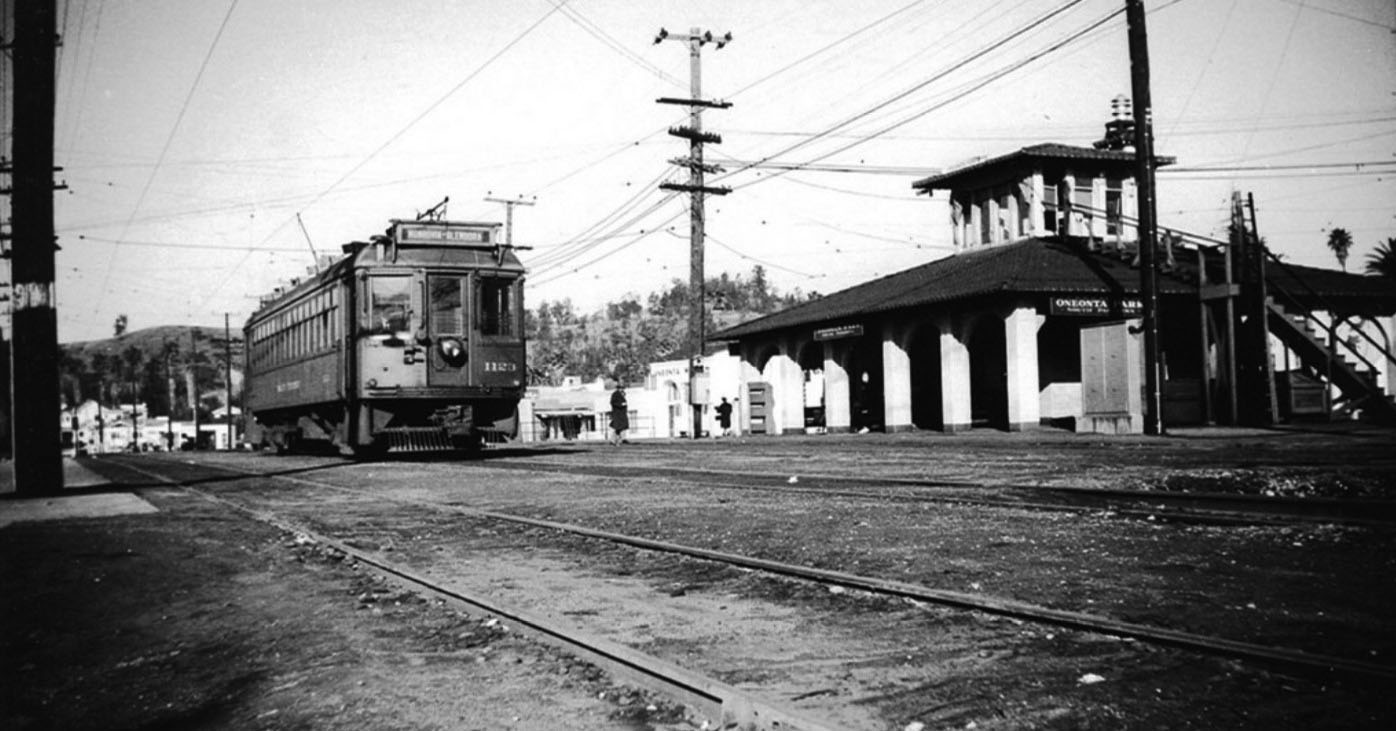 |
|
| (1951)##^^– View showing one of the last Pacific Electric streetcars at Oneonta Park Junction. The station would be demolished in late 1951 when the PE Red Car operations discontinued. |
Historical Notes The largest electric railway system in the world at that time, the Pacific Electric Railway and the Big Red Cars reached the end of the line when virtually all operations ceased by late 1951, ending nearly 50 years of service to more than 50 cities. Closing the chapter on the Pacific Electric Railway, most of the nearly 1,300 miles of rail along with the trolley wire were removed throughout 1952.^ Click HERE to see more early views of Oneonta Park Junction (1910 +). |
M-M Foods
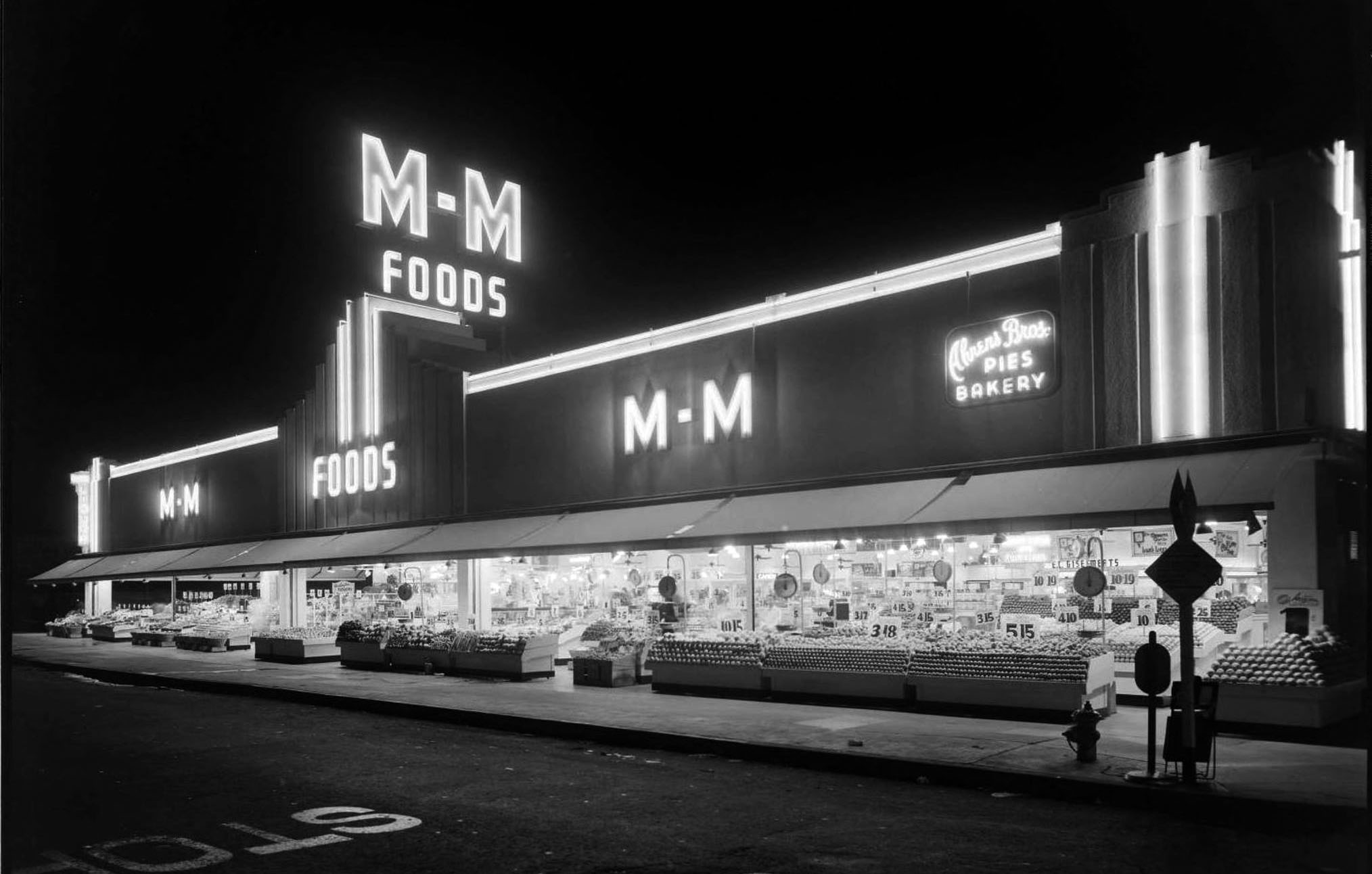 |
|
| (1939)^.^ – View showing M-M Foods located on the SE corner of Huntington Drive and Fremont Ave in South Pasadena. Photo by G. Haven Bishop, Huntington Library. |
Historical Notes M-M Foods Market later became El Rancho Market, now its a Big Lots. Click HERE for contemporary view. |
Rose Bowl (1930s and 1940s)
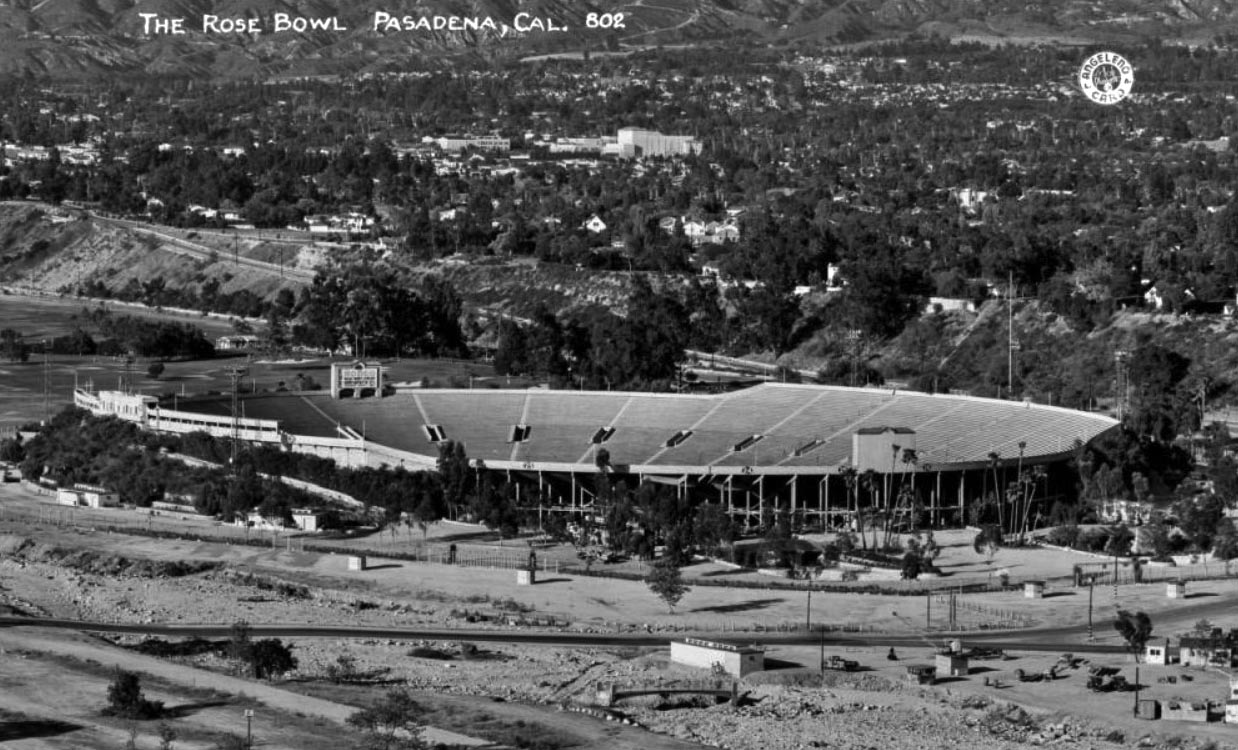 |
|
| (1930s)#* - Postcard view looking north showing the Rose Bowl stadium in the Arroyo Seco canyon area. The cities of Pasadena and Altadena are in the distance, with the San Gabriel Mountains in the background. Sign visible over scoreboard reads, "Rodeo Wild West Circus here Sat. Oct. 15th, 2.00." |
Historical Notes The southern stands were completed in 1928. |
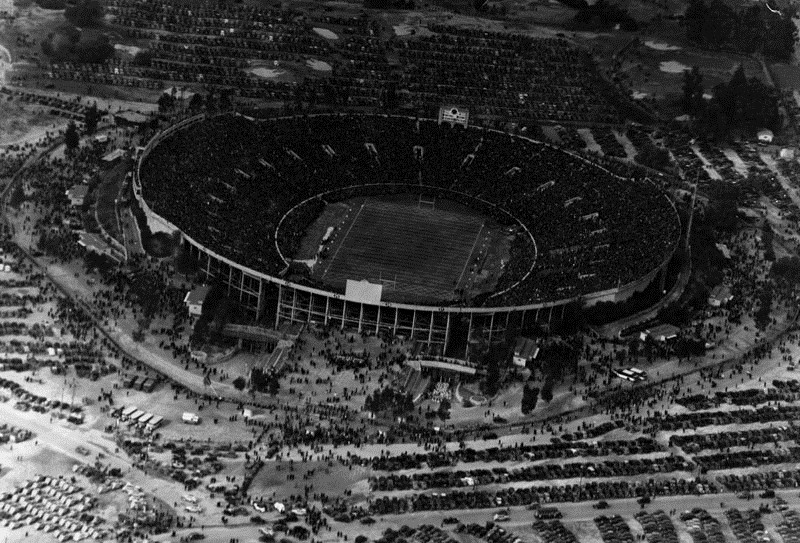 |
|
| (1937)* - Rose Bowl football is the classic of all "bowl" games. Here is how grid fans from all corners of--from New York to Seattle to Miami to Los Angeles--appear from above when this annual Pasadena classic is staged. This Kopec Air photo, taken from the Goodyear airship Volunteer, piloted by Art T. Sewell, shows the capacity crowd which witnessed Washington's demise when they met Pittsburgh. Pittsburgh Panthers 21 - Washingtion Huskies 0. Photo dated: January 2, 1937. |
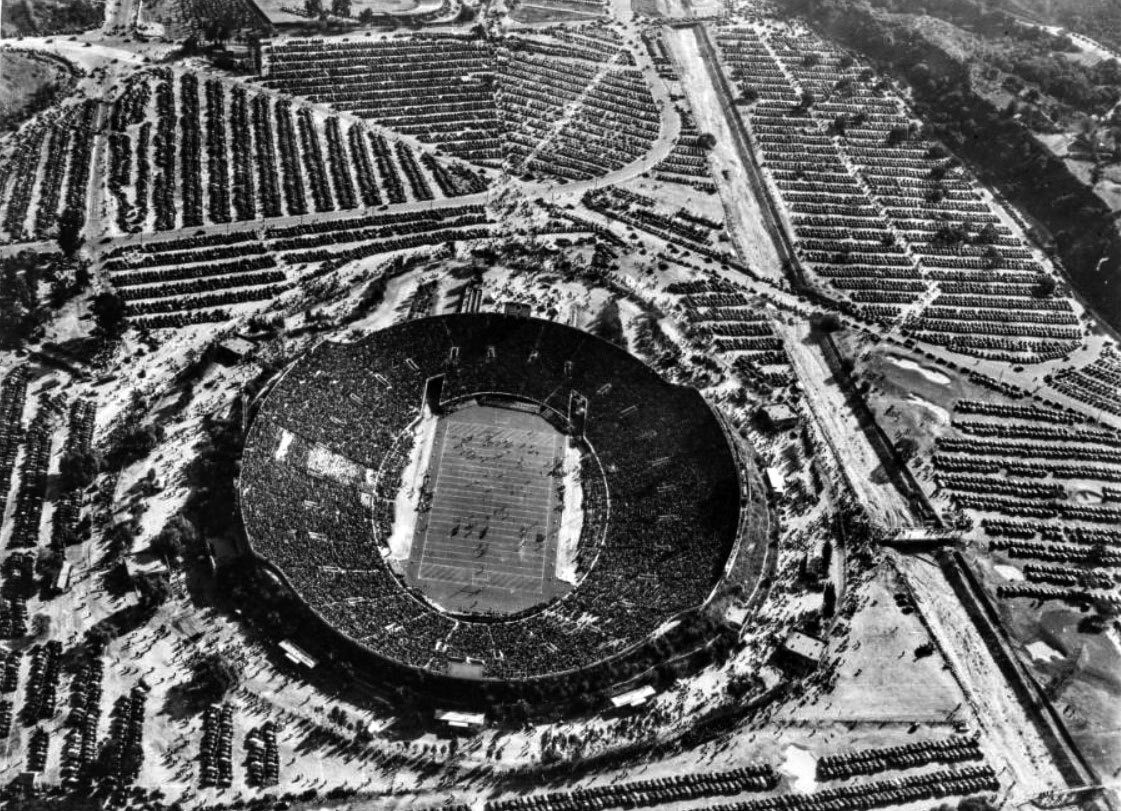 |
|
| (ca. 1939)#* - Aerial view, looking south, of the Rose Bowl in the Arroyo Seco canyon area of Pasadena showing the stadium and parking lot filled to capacity. The Arroyo Seco storm channel is seen at right. |
Historical Notes The Arroyo Seco Storm Channel was built during the late 1930s. |
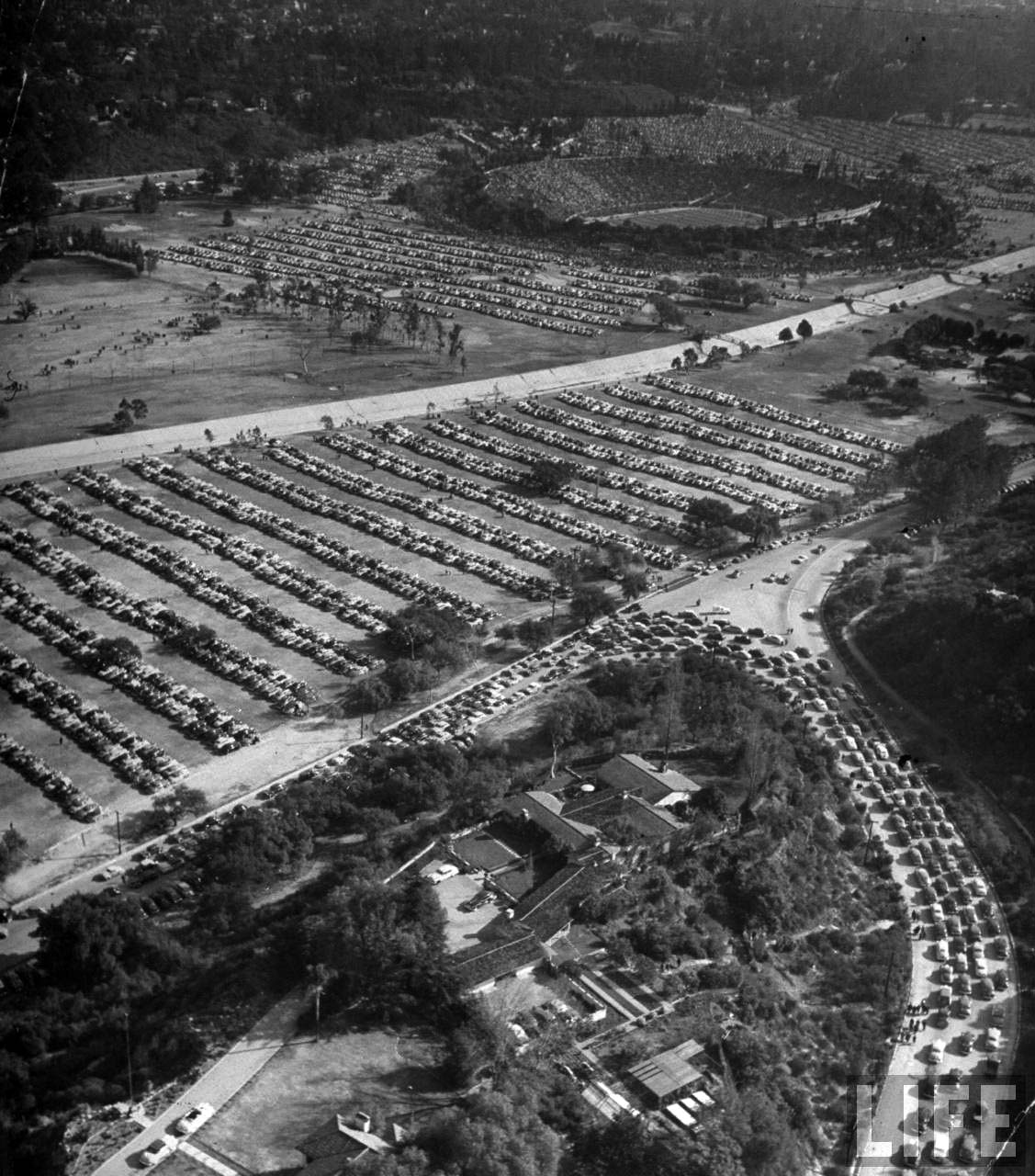 |
|
| (1949)^*# – Aerial view looking down toward the Rose Bowl as fans arrive and parking lots fill up. |
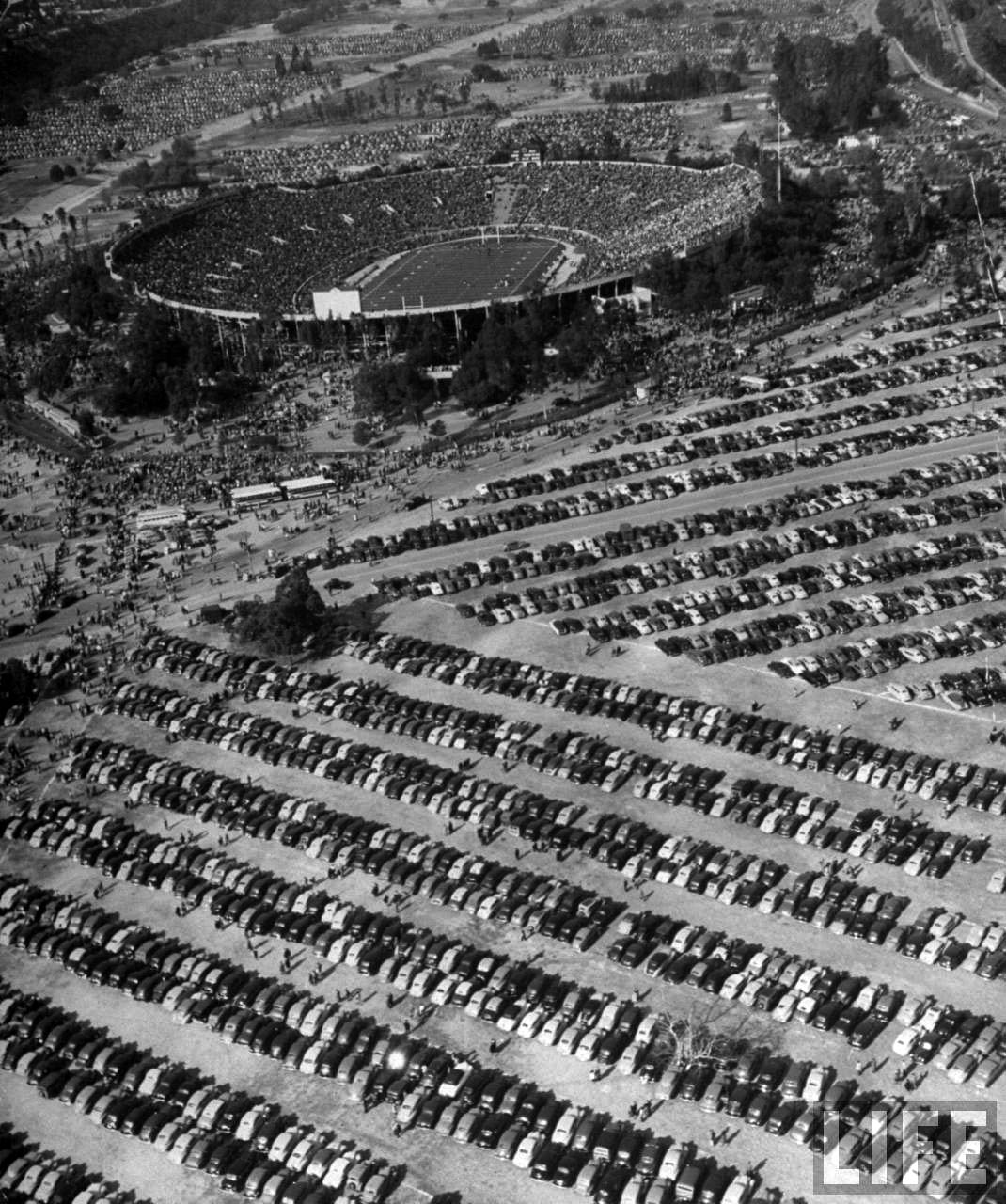 |
|
| (1949)^*# – Closer view showing a full house at the Rose Bowl and parking lot packed with cars as far as the eye can see. |
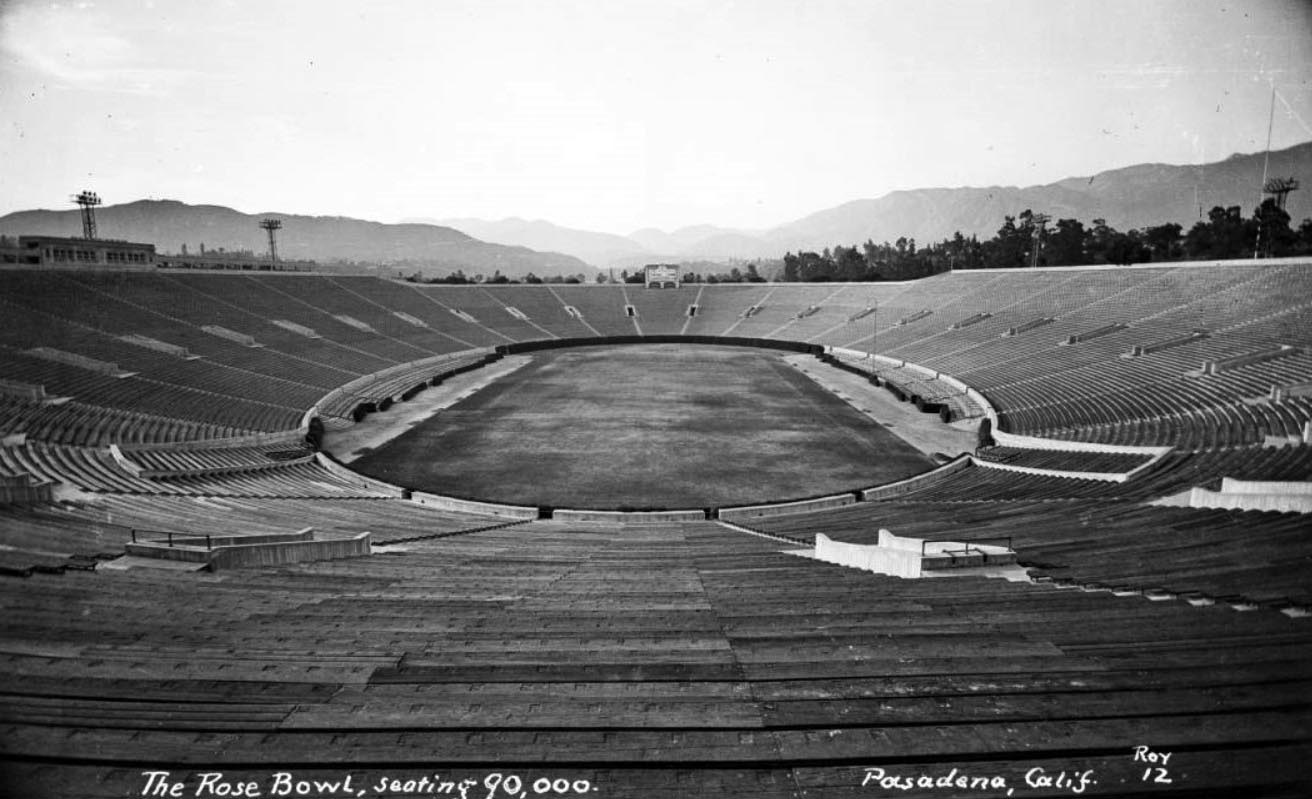 |
|
| (ca. 1940s)#* - View of the Rose Bowl stadium in Pasadena, showing the empty bleachers with seating for 90,000. |
Historical Notes By 1950 the Rose Bowl Stadium saw its fourth expansion when its capacity increased to 100,983. The Rose Bowl Game became the first bowl game to have 100,000 spectators in attendance.*^ |
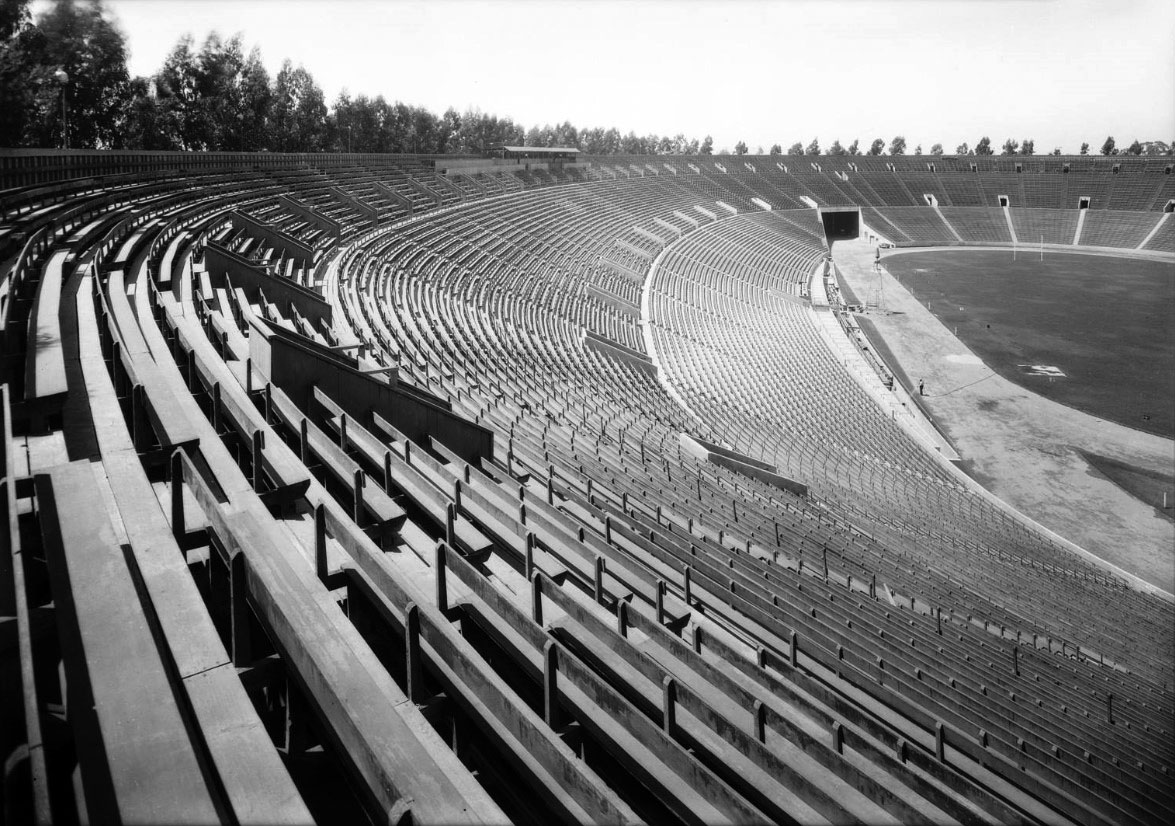 |
|
| (1950 +)^ – Rose Bowl capacity 100,000. |
* * * * * |
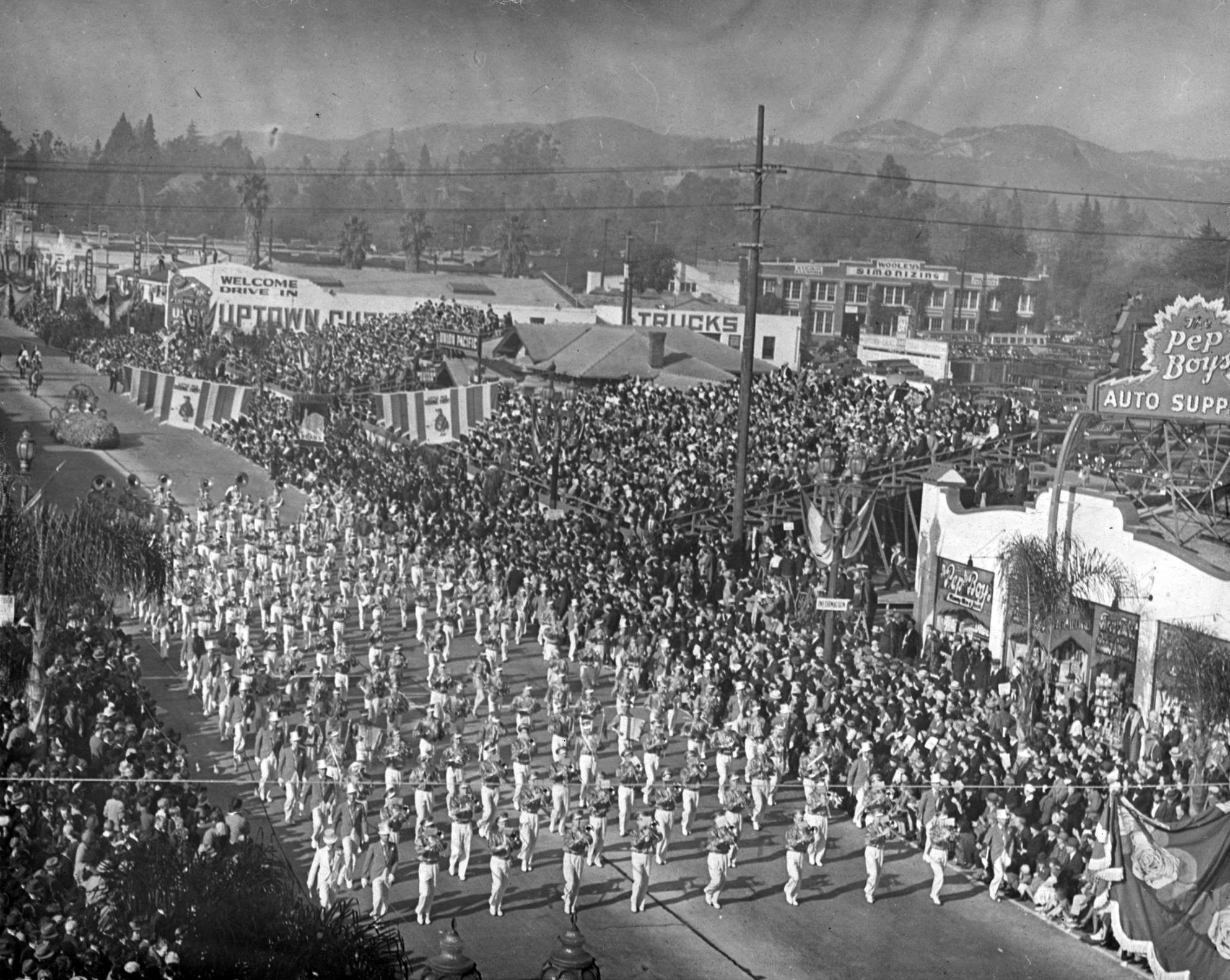 |
|
| (1937)*^* – View showing the Pasadena Junior College’s Tournament Band marching in the 1937 Tournament of Roses Parade. |
 |
|
| (1938)* - Crowds watch an Altadena float that features a castle and Santa Claus with his reindeer at the Rose Parade held January 1, 1938. This float won first place in its city size category. Some businesses that can be seen on the north side of Colorado Boulevard between Hudson and Lake include: Pasadena Luggage Shop and, behind the light pole on the far right, Cake Box Products (839 East Colorado Boulevard). |
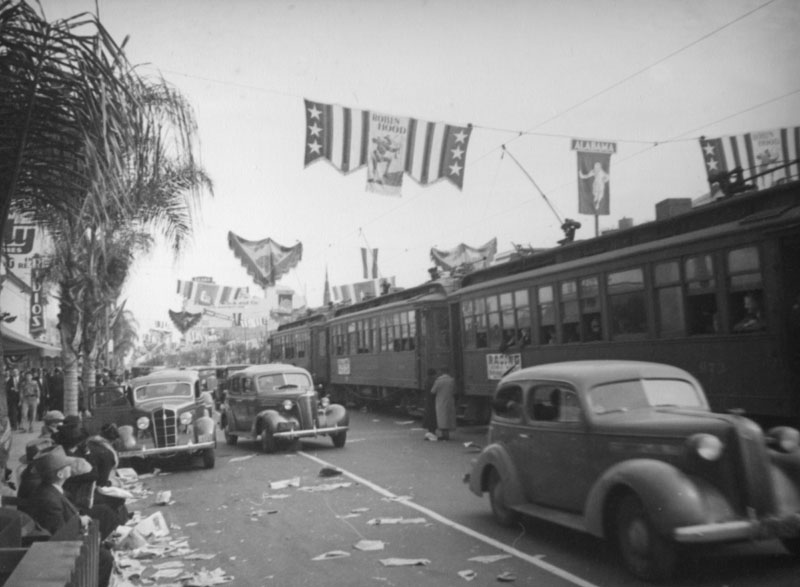 |
|
| (1938)* - A streetcar competes with automobile traffic and litter after the Rose Parade held January 1, 1938. The Banners across the street are connected to the streetcar lines, and although one banner is for Robin Hood, the central one is for Alabama, one of the two state teams playing in the Rose Bowl later that day. The Thrifty Drug Store visible on the far left was located at 355 East Colorado Boulevard. |
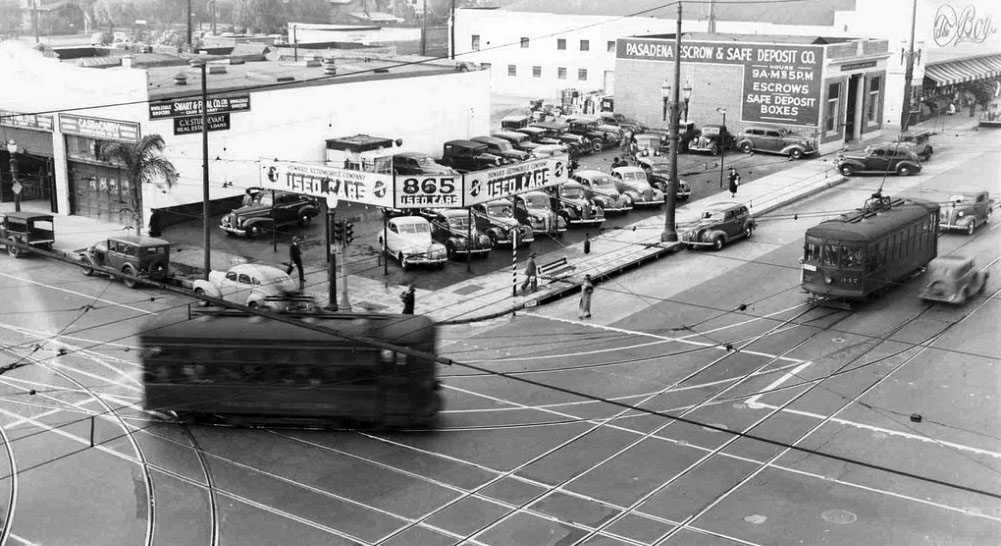 |
|
| (1938)**# – View showing two streetcars heading in opposite directions at the intersection of Colorado and Lake. A used car lot can be seen on the southwest corner. |
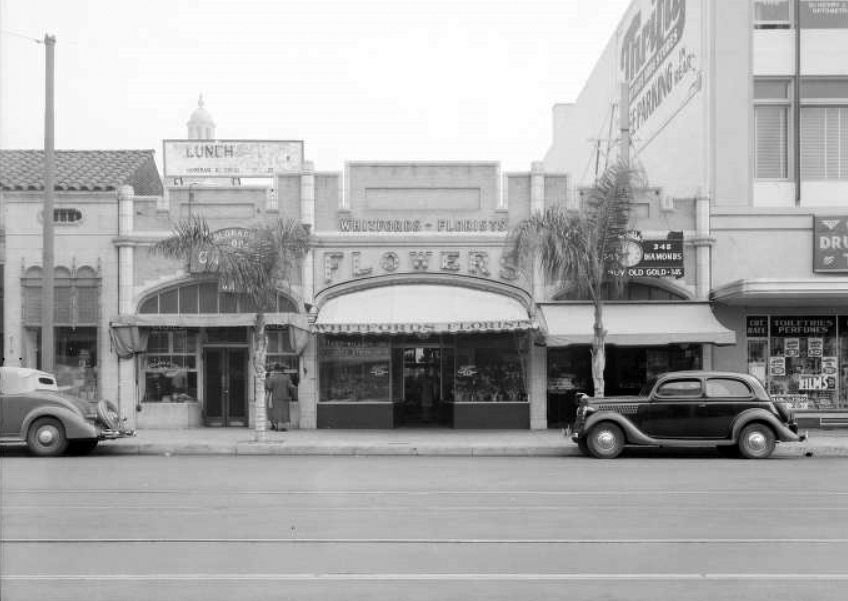 |
|
| (1936)#* - Street view of the building at 341-345 East Colorado. Some of the businesses in this space are the Colorado Inn Cafe, Whitfords Florists, and a jewelers. Two women stand outside of the cafe and a man stands in the doorway of the florist. Two automobiles are parked on the street in front of the buildings. |
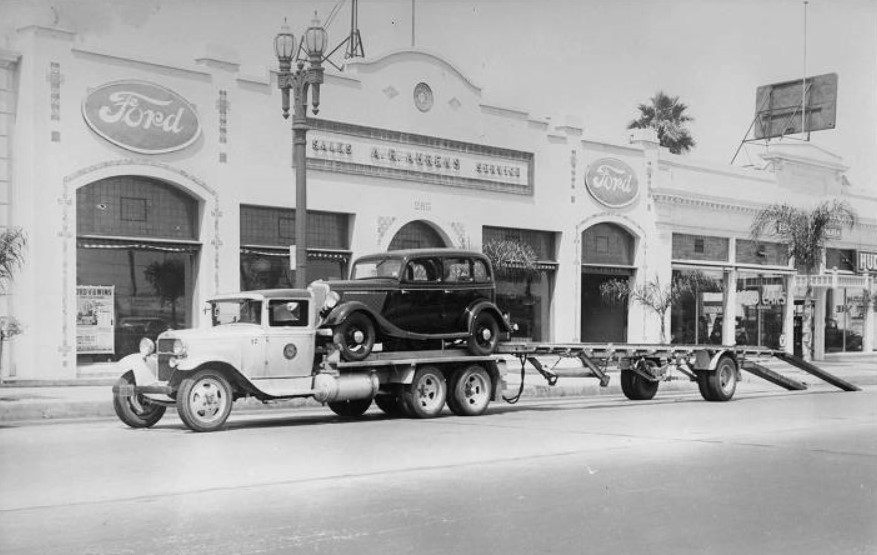 |
|
| (1936)** – View of an auto on a trailer truck in front of A. R. Ahrens Ford Sales and Service on W. Colorado Street. |
Historical Notes A. R. Ahrens Ford Sales and Service was located at 285 W. Colorado, near the Old Town area in Pasadena. The auto on the trailer is a 1935 Ford V-8 Fordor sedan.** |
 |
|
| (1937)* - The intersection of Colorado Blvd. and Fair Oaks Avenue in Pasadena on October 3, 1937. View is toward the east. |
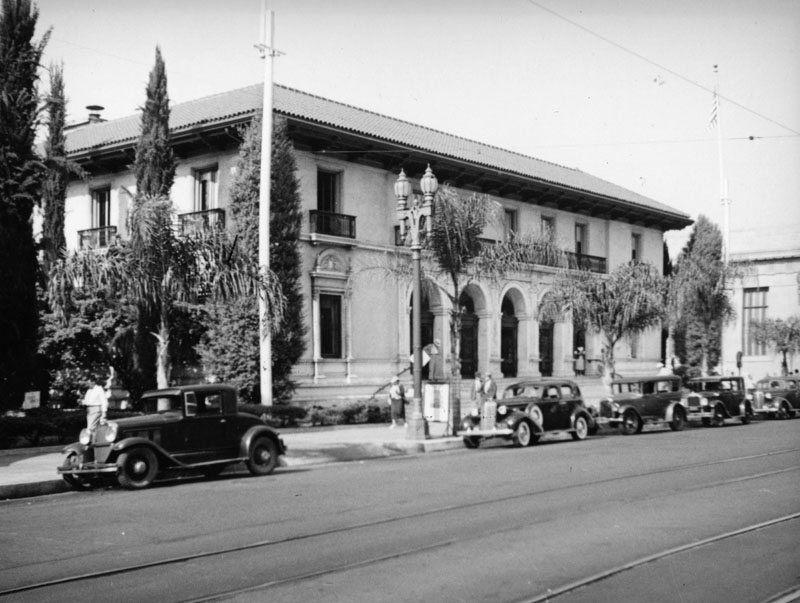 |
|
| (ca. 1937)* - Looking northeast towards the post office in Pasadena, located at 281 E Colorado Boulevard. Two sets of streetcar tracks are visible on the boulevard. |
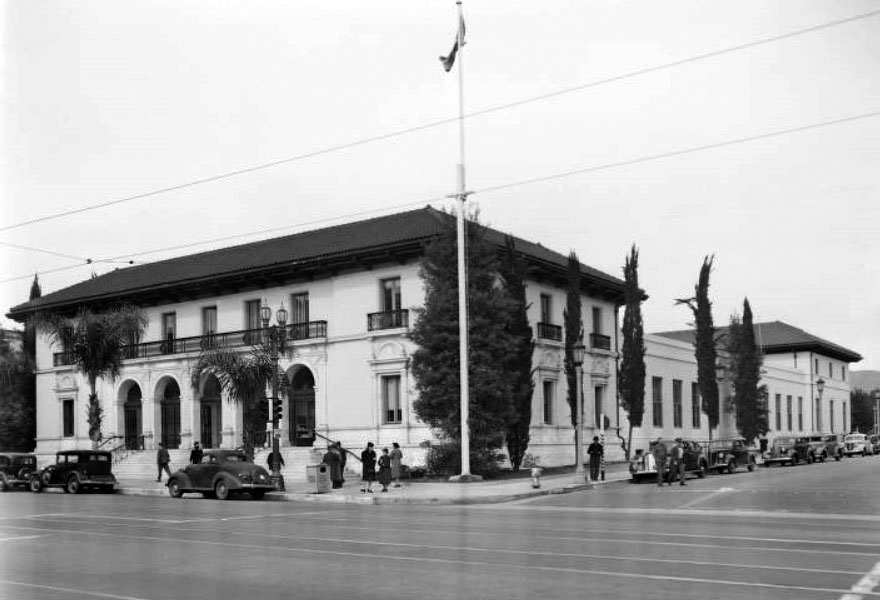 |
|
| (1939)#* - View looking toward the northwest corner of E. Colorado and Garfield Avenue showing a tall flagpole standing in front of the Post Office. Pedestrians are seen walking by the building with automobiles parked along the street. |
Historical Notes In early 2012, the post office building was renamed "First Lieutenant Oliver Goodall Post Office Building," in honor of an Altadena resident and Tuskegee Airman. Goodall lived in Altadena from 1961 until his death in November 2010. Goodall entered the service at Tuskegee in February 1943. In October 1944, he graduated as a multi-engine pilot and was assigned to the 477th Bomber Group at Godman Field, Kentucky, in January 1945, where he attained his First Pilots rating in six months. Goodall was among 60 African American U.S. Army Air Corps officers arrested for trying to peacefully integrate an all-white officers’ club, which came to be known as the Freeman Field Mutiny. The ‘mutiny’ was an important step toward full integration of all U.S. armed forces worldwide in June 1949, serving as a model for later Civil Rights efforts to integrate public facilities.* |
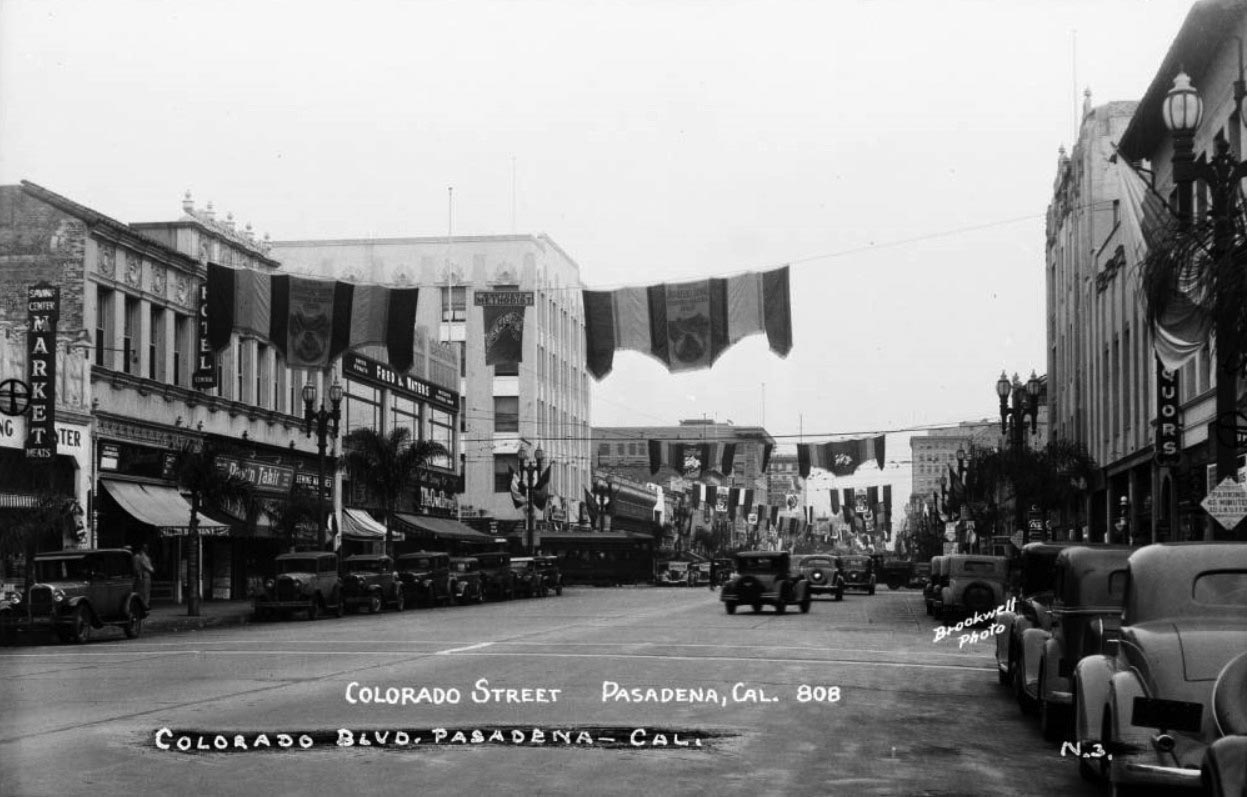 |
|
| (ca. 1936)#*– Postcard view of Colorado Street (now Colorado Boulevard), in Pasadena, showing buildings, storefronts and automobiles. A streetcar is coming onto the street from a cross street, at left. Some of the businesses seen are "The Belmont" "Central Hotel" "Owl Drug Co." a barber pole, market, and liquor store. A sign for "Route 66" is on pole at right. Flags and banners hang over the street - one says "Southern Methodist University."* |
Historical Notes In the 1936 Rose Bowl, Stanford played Southern Methodist University and beat them 7 – 0. The only Rose Bowl team from Texas in the game’s first 92 editions, SMU suffered its first loss of the season in front of the game’s first ever sellout crowd of 84,784 while Stanford avenged consecutive Rose Bowl losses the previous two years. |
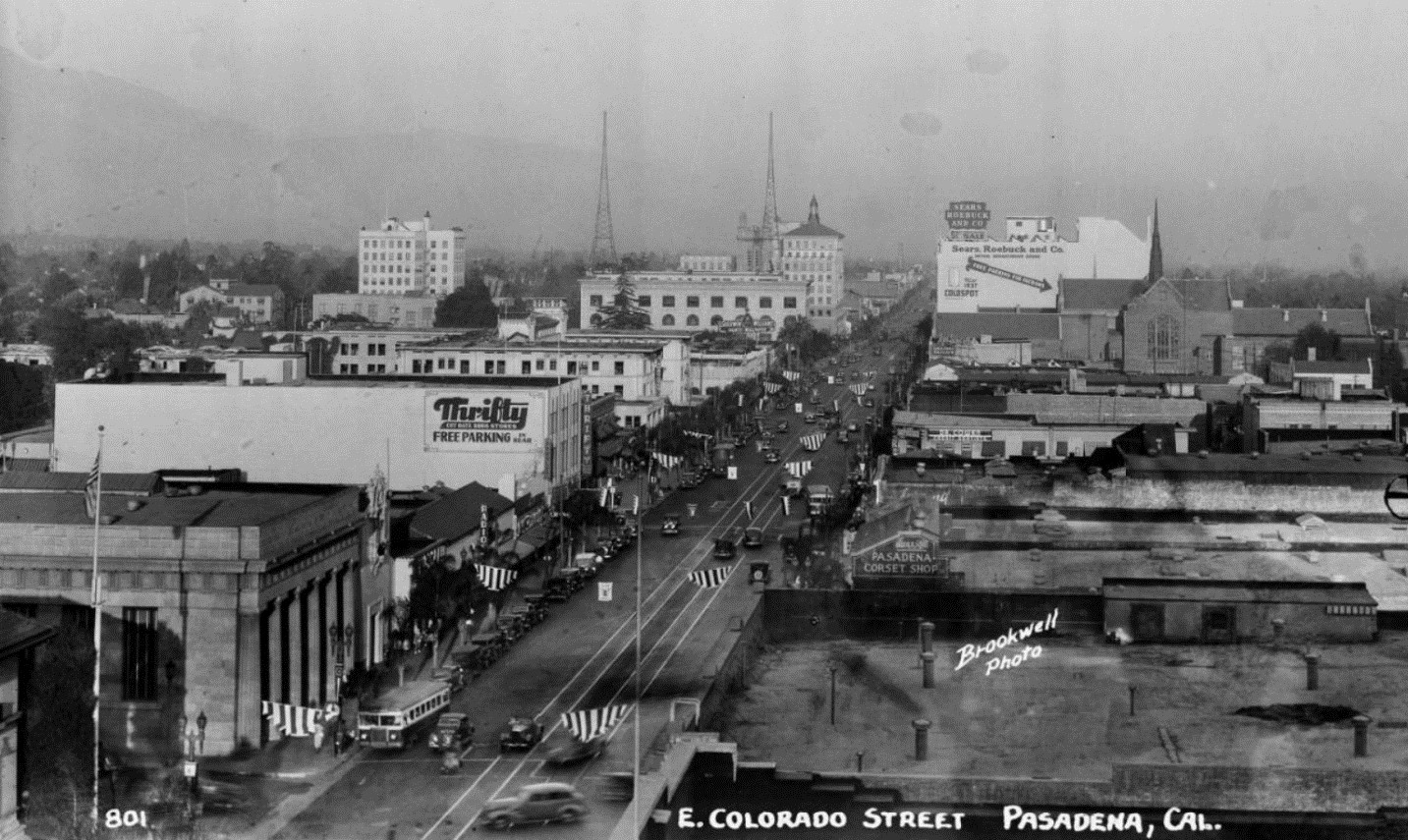 |
|
| (ca. 1939)#* - Bird's-eye-view of Colorado Street (now Colorado Boulevard), in Pasadena, showing buildings, buses and automobiles. Some of the businesses seen are "Thrifty" "Sears, Roebuck and Co." "Pasadena Corset Shop." The Pasadena Star-News Building, with the two radio towers on its roof, can be seen in the distance. In the foreground (lower-left) is the First National Bank building located at 301 East Colorado St. |
Historical Notes Colorado Street was renamed "Boulevard" in 1958. |
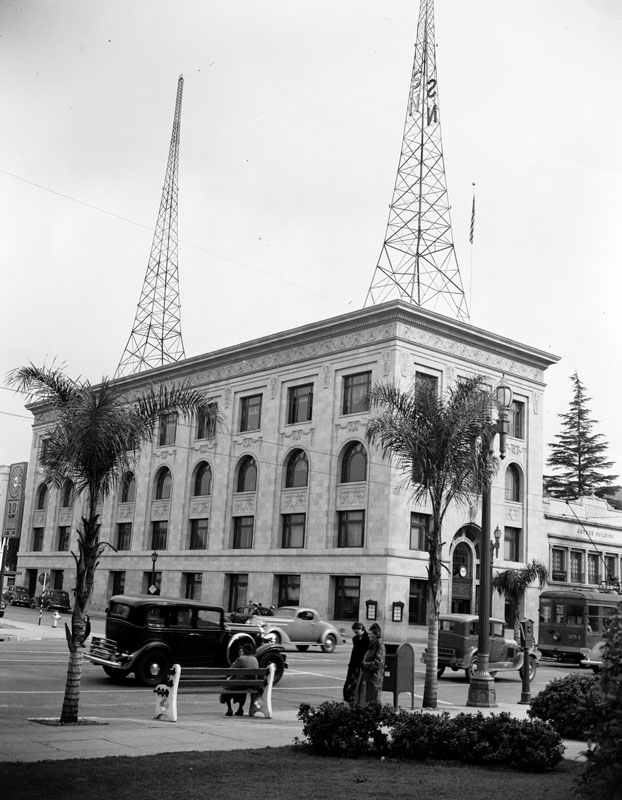 |
|
| (1938)* - Exterior view of the Pasadena Star News newspaper office and radio station on Colorado Street and Oakland Ave. Radio towers are visible on the roof of the four-story building. |
Historical Notes First published in 1884, the Pasadena Star-News moved into the building in 1925 and stayed until the 1990s. Click HERE to see more views of this beautiful Beaux-Arts style building which still stands today. |
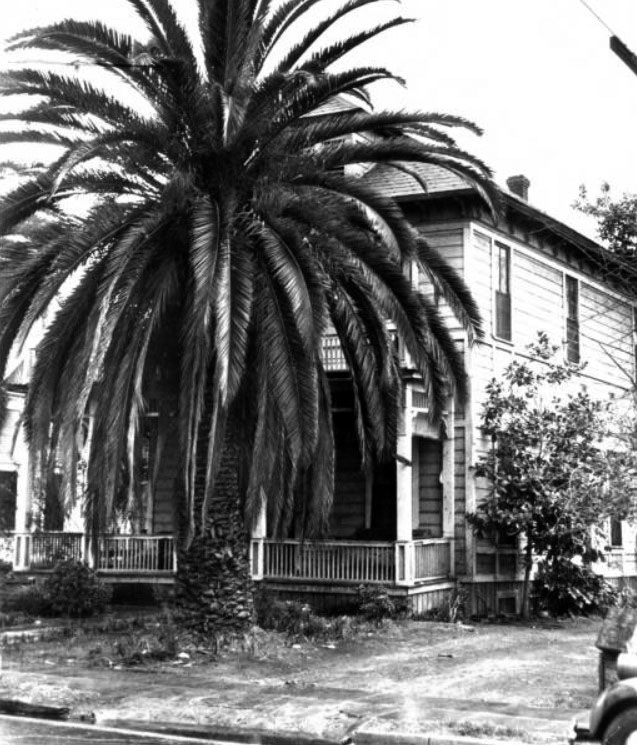 |
|
| (1938)*^* – View showing the first library building on Dayton Street (originally located on the corner of Colorado and Raymond). |
Historical Notes The building was originally built in 1884 at the corner of Colorado and Raymond. In 1886 the building was moved to Dayton Street. The second floor was used for meetings of the Independent Order of Good Templars and the Ancient Order of United Workmen.*^* |
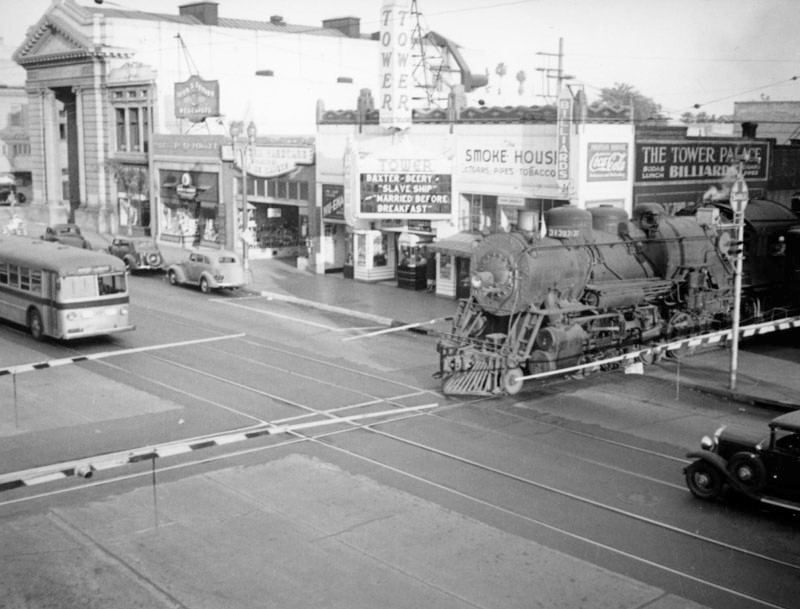 |
|
| (ca. 1938)* – View of a train passing by the Tower Theatre in Pasadena, located at 114 E. Colorado Blvd. |
Historical Notes The Tower Theatre opened in 1930 and was designed by architect B.G. Horton, who also designed the Barney’s Beanery building across the street and the elegant MacArthur Building at 24 N. Marengo Avenue. Next door was a tobacco shop and a pool hall—The Tower Palace, and beyond that, the Sante Fe railroad line, which used to rattle the theater like a Southern California temblor. #^^ |
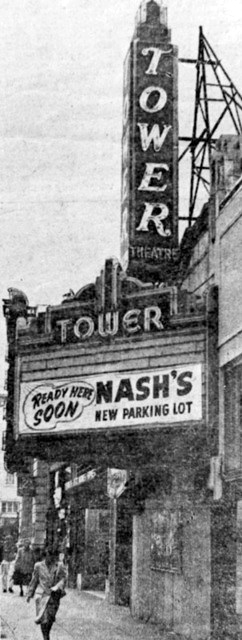 |
(ca. 1952)**^^ - The Tower Theatre opened in 1930 and it closed 22 years later, in 1952. A parking lot occupies the spot where the Tower Theater once stood—between railroad tracks and the Anderson Typewriter Company.
|
Historical Notes Hardly a spectacular movie palace, the Tower Theatre nevertheless attracted the youth of Pasadena. “We used to go there on Saturday mornings for serials—Tom Mix, Hopalong Cassidy, and Bob Steele,” recalled former Pasadena city councilman Chuck McKenney in a 2000 interview with the Pasadena Star-News. #^^ |
* * * * * |
California Institute of Technology (Caltech)
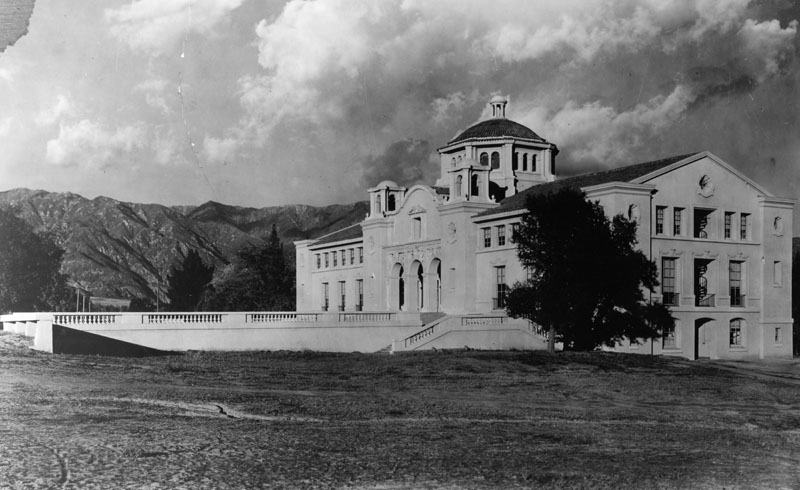 |
|
| (ca. 1912)* - Throop Hall first opened its doors to the public on February 5, 1910. Known then as Pasadena Hall, it was the first building on the new campus of Throop Polytechnic Institute. |
Historical Notes Caltech began as a vocational school founded in Pasadena in 1891 by local businessman and politician Amos G. Throop. The school was known successively as Throop University, Throop Polytechnic Institute (and Manual Training School), and Throop College of Technology, before acquiring its current name in 1920. The vocational school was disbanded and the preparatory program was split off to form an independent Polytechnic School in 1907. In 1910, Throop moved to its current site. Arther Fleming donated the land for the permanent campus site. Theodore Roosevelt delivered an address at Throop Institute on March 21, 1911, and he declared: “I want to see institutions like Throop turn out perhaps ninety-nine of every hundred students as men who are to do given pieces of industrial work better than any one else can do them; I want to see those men do the kind of work that is now being done on the Panama Canal and on the great irrigation projects in the interior of this country—and the one-hundredth man I want to see with the kind of cultural scientific training that will make him and his fellows the matrix out of which you can occasionally develop a man like your great astronomer, George Ellery Hale.” *^ |
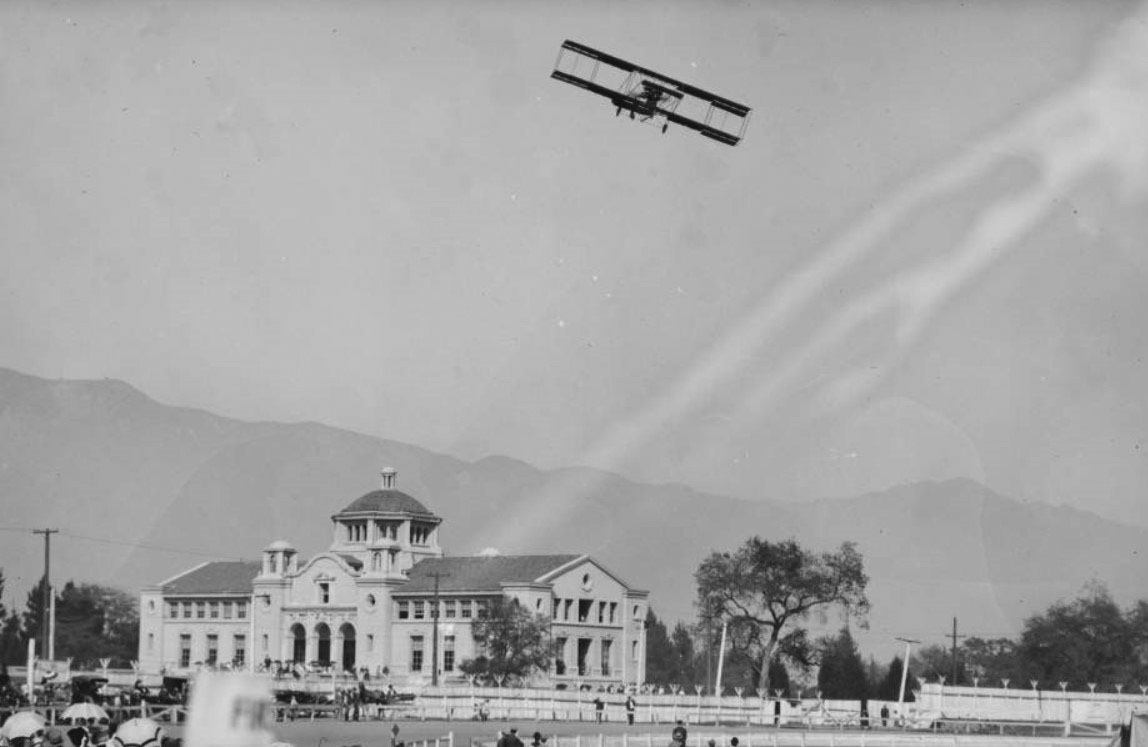 |
|
| (1914)*^* - View looking north from Tournament Park showing a biplane soaring above Throop Hall. |
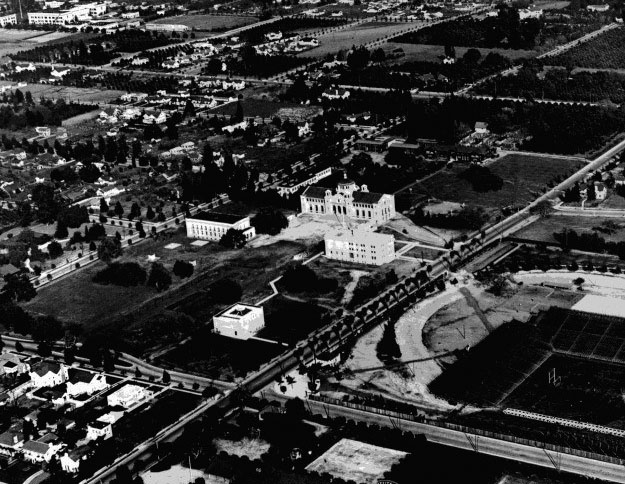 |
|
| (1922)^.^ – Aerial view of the Caltech Campus showing Throop Hall, completed in 1910; Gates Chemical Lab. built in 1917; Bridge Physics Lab. and Culbertson Hall completed in 1922. |
Historical Notes Although founded as a preparatory and vocational school by Amos G. Throop in 1891, the college attracted influential scientists such as George Ellery Hale, Arthur Amos Noyes, and Robert Andrews Millikan in the early 20th century. The vocational and preparatory schools were disbanded and spun off in 1910, and the college assumed its present name in 1921.*^ |
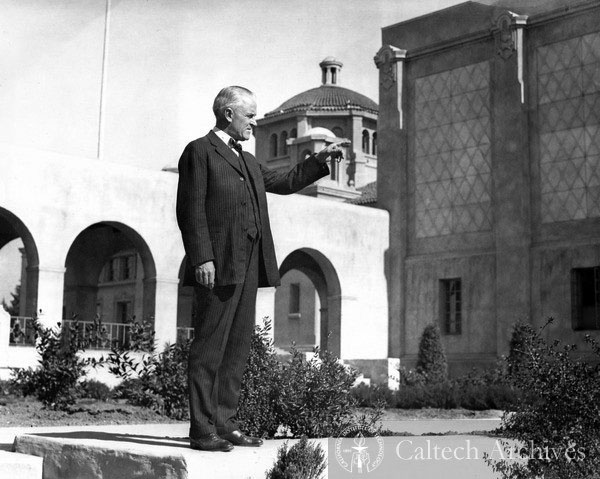 |
|
| (ca. 1920s)^.^ – View showing Robert Millikan on the Caltech campus with Throop Hall in the background. He is pointing to the High-Voltage Lab (now Sloan). |
Historical Notes Robert Millikan was the 1st President of California Institute of Technology and in office between 1920 and 1946. In 1914 Millikan worked on the experimental verification of the equation introduced by Albert Einstein in 1905 to describe the photoelectric effect. He used this same research to obtain an accurate value of Planck’s constant. In 1921 Millikan left the University of Chicago to become director of the Norman Bridge Laboratory of Physics at the California Institute of Technology (Caltech) in Pasadena, California. There he undertook a major study of the radiation that the physicist Victor Hess had detected coming from outer space. Millikan proved that this radiation is indeed of extraterrestrial origin, and he named it "cosmic rays." As chairman of the Executive Council of Caltech (the school's governing body at the time) from 1921 until his retirement in 1945, Millikan helped to turn the school into one of the leading research institutions in the United States. He also served on the board of trustees for Science Service, now known as Society for Science & the Public, from 1921 to 1953. Robert Millikan was honored with the Nobel Prize for Physics in 1923 for the measurement of the elementary electric charge and for his work on the photoelectric effect.* |
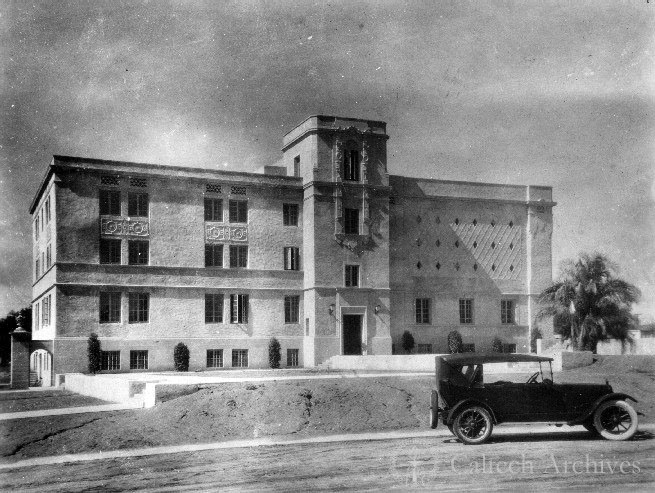 |
|
| (ca. 1922)^.^ – An early model car is parked in front of the Hi Volts Lab (now Sloan Laboratory). |
Historical Notes Since 1923, Caltech faculty and alumni have garnered 32 Nobel Prizes and five Crafoord Prizes. |
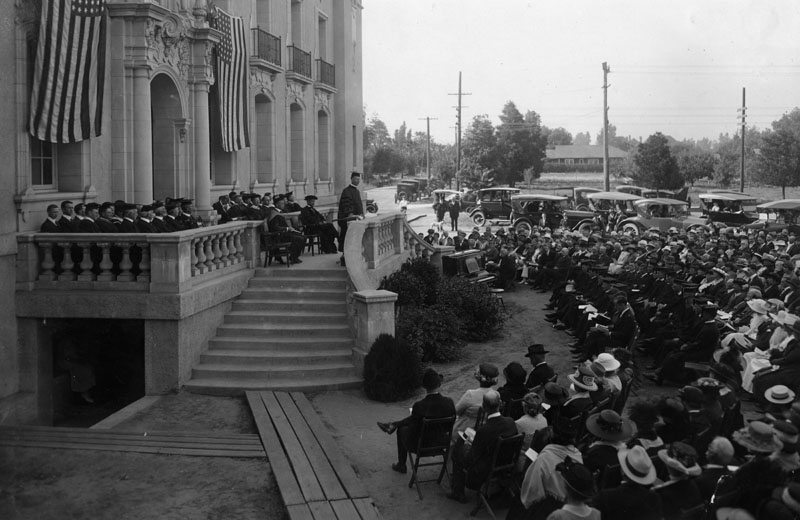 |
|
| (ca. 1930)* - Graduation ceremonies held at the California Institute of Technology, in Pasadena. Graduating students are sitting in the front (middle), surrounded by family and friends. |
|
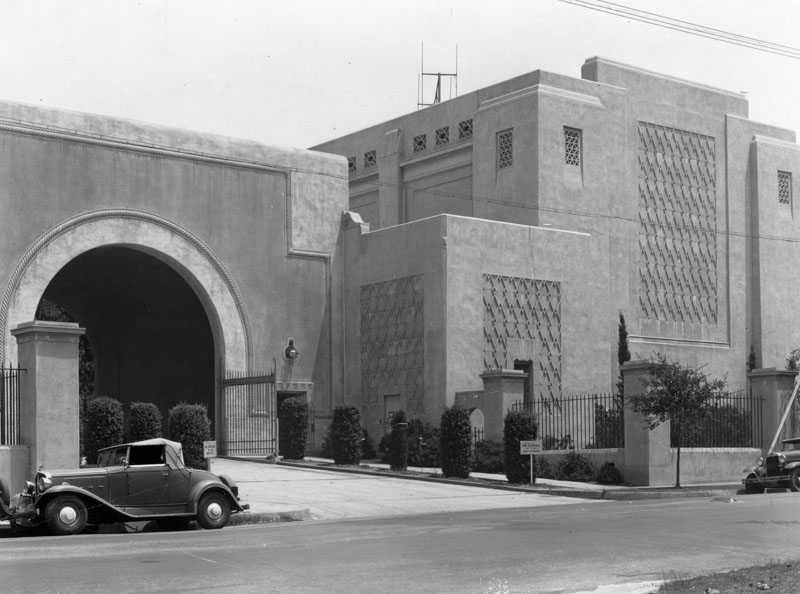 |
|
| (1930s)* - The large building on the right is the Optical Shop in which a 200-inch disc of pyrex glass was ground and polished preparatory to being installed in the Observatory on Palomar Mountain in San Diego County. |
Historical Notes At a time when scientific research in the United States was still in its infancy, George Ellery Hale, a solar astronomer from the University of Chicago, founded the Mount Wilson Observatory in 1904. He joined Throop's board of trustees in 1907, and soon began developing it and the whole of Pasadena into a major scientific and cultural destination.*^ |
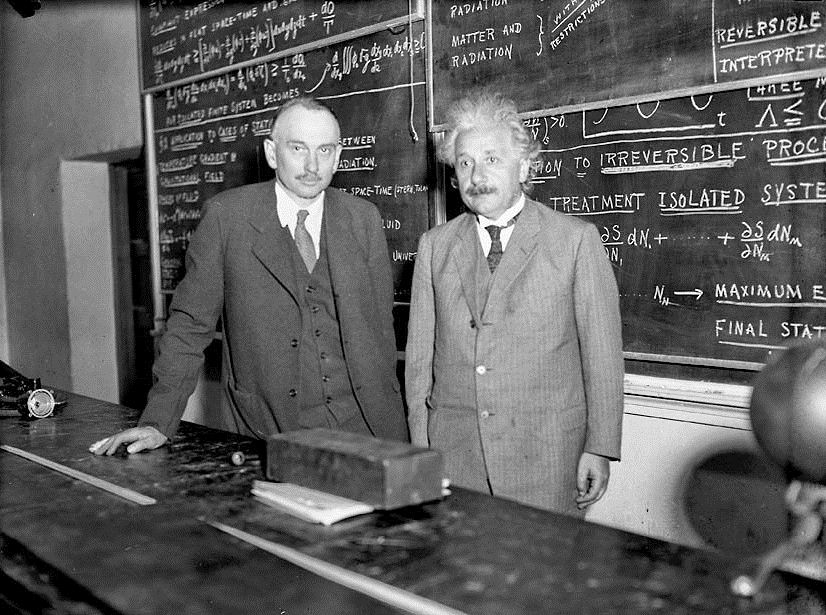 |
|
| (1932)^*^ - Richard Tolman of Cal Tech stands next to Albert Einstein in 1932. Einstein came for a visit because he was interested in Cal Tech's work. |
Historical Notes Albert Einstein arrived on the Caltech campus for the first time in 1931 to polish up his Theory of General Relativity, and he returned to Caltech subsequently as a visiting professor in 1932 and 1933. Since 2000, the Einstein Papers Project has been located at Caltech. The project was established in 1986 to assemble, preserve, translate, and publish papers selected from the literary estate of Albert Einstein and from other collections.*^ |
Robinson Laboratory
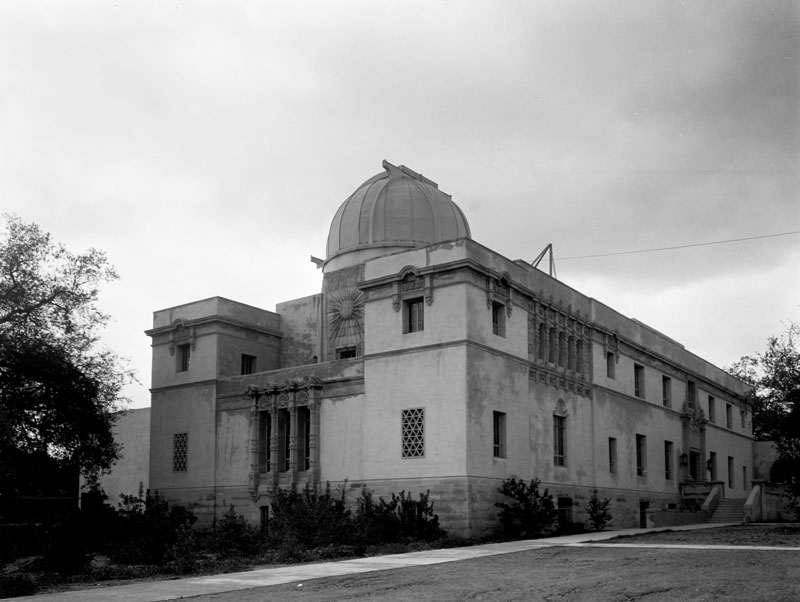 |
|
| (1939)* - Exterior view of the Astro-Physics Laboratory (aka Robinson Laboratory) at the California Institute of Technology in Pasadena. |
Historical Notes Built in 1932, the awe-inspiring observatory was designed in an eclectic Californian Churrigueresque style, with nods to Art Deco, designed by famed architects Mayers Murray & Phillip. The laboratory, along with the rest of Caltech's exuberant campus, is one of the most exquisite and unique executions of Churrigueresque architecture in all of California. Famed astronomer Fritz Zwicky discovered the existence of Dark Matter while working in the basement of the Robinson Lab in 1933. The laboratory housed Caltech's astronomers and astrophysicists for nearly eighty years. Among countless achievements made here, Caltech co-founder and renowned astrophysicist George Ellery Hale led the construction of the 200-inch telescope on Mount Palomar. In 2008, Caltech began transforming the building into the new Ronald and Maxine Linde Center for Global Environmental Science, devoted to developing solutions to the world's complex environmental problems. The rehabilitation and restoration earned the project a Conservancy Preservation Award in 2012.* |
* * * * * |
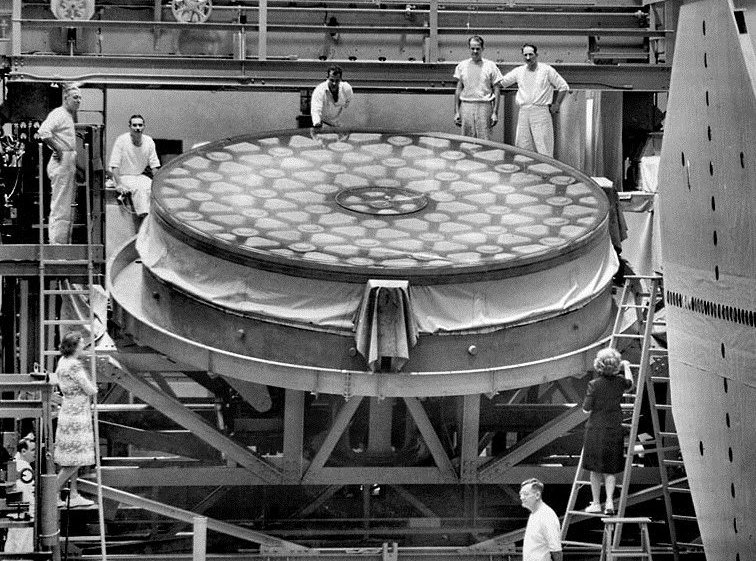 |
|
| (1945)^^* - Workers at the California Institute of Technology Optical Shop pose with the mirror of a 200-inch Palomar Observatory telescope |
Historical Notes After the end of World War II, grinding work was resumed on the mirror. Work had been halted in 1942 when engineers, scientists and Caltech laboratories were assigned war-related work. The mirror was transported to Palomar Observatory in 1947. The 200-inch telescope was dedicated in 1948.^^* |
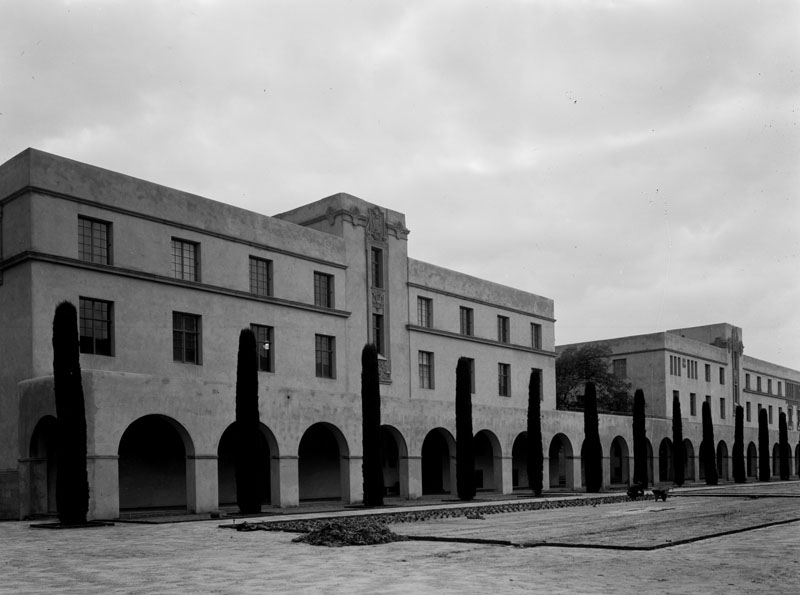 |
|
| (1939)* - Exterior view of Arms Hall (left) and Mudd Hall (right), Geology studies, at the California Institute of Technology in Pasadena on May 5, 1939. They are located on the south side of the quad. |
Historical Notes In 1910, a bill was introduced in the California Legislature calling for the establishment of a publicly funded "California Institute of Technology," with an initial budget of a million dollars, ten times the budget of Throop at the time. The board of trustees offered to turn Throop over to the state, but the presidents of Stanford University and the University of California successfully lobbied to defeat the bill, which allowed Throop to develop as the only scientific research-oriented education institute in southern California, public or private, until the onset of the World War II necessitated the broader development of research-based science education. The promise of Throop attracted physical chemist Arthur Amos Noyes from MIT to develop the institution and assist in establishing it as a center for science and technology.*^ |
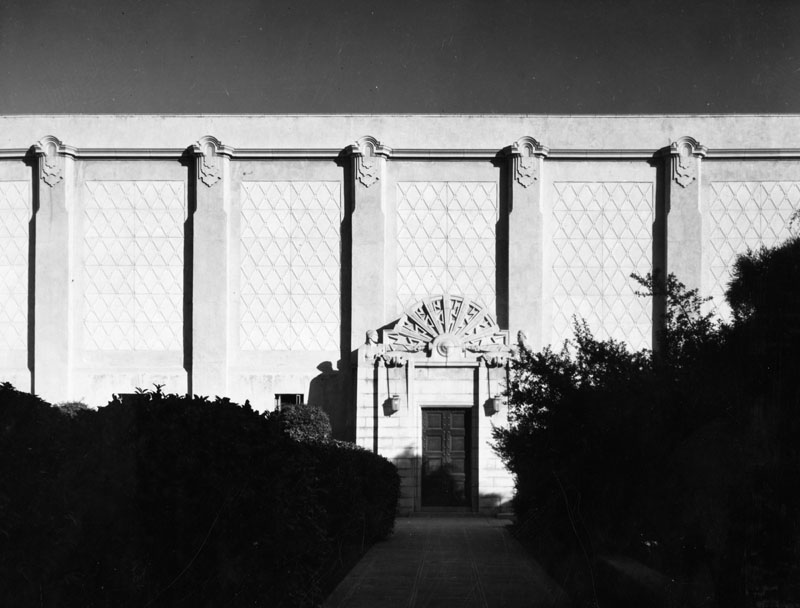 |
|
| (1939)* - Exterior view of High Tension Laboratory at the California Institute of Technology. View shows the architectural designs over the entrance and on the building. View of entrance and facade. Architect: Goodhue and Associates. Date built: c. 1925. |
Historical Notes In the 1950s–1970s, Caltech was the home of Murray Gell-Mann and Richard Feynman, whose work was central to the establishment of the Standard Model of particle physics. Feynman was also widely known outside the physics community as an exceptional teacher and colorful, unconventional character.*^ |
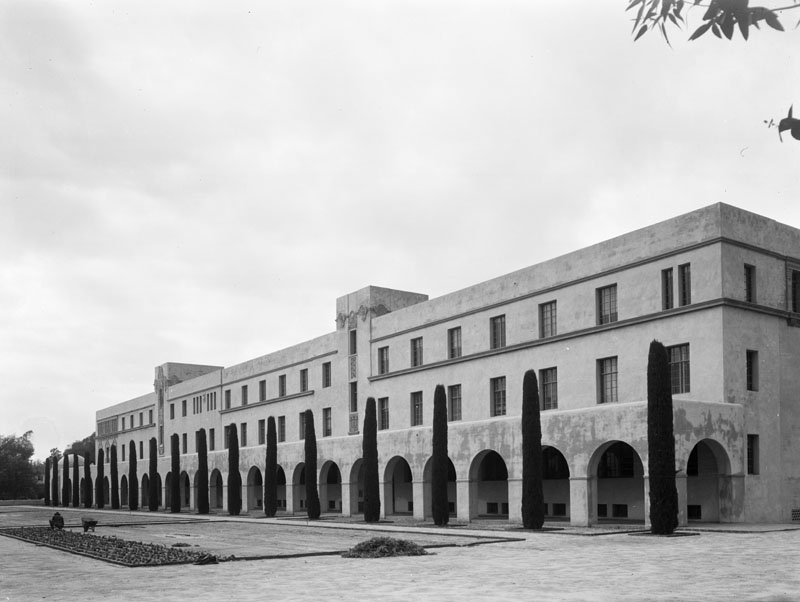 |
|
| (1939)* - Exterior view of the Kerckhoff Biological Laboratory at the California Institute of Technology |
Historical Notes In addition to managing JPL, Caltech also operates the Palomar Observatory in San Diego County, the Owens Valley Radio Observatory in Bishop, California, the Submillimeter Observatory and W. M. Keck Observatory at the Mauna Kea Observatory, the Laser Interferometer Gravitational-Wave Observatory at Livingston, Louisiana and Richland, Washington, and Kerckhoff Marine Laboratory in Corona del Mar, California.*^ |
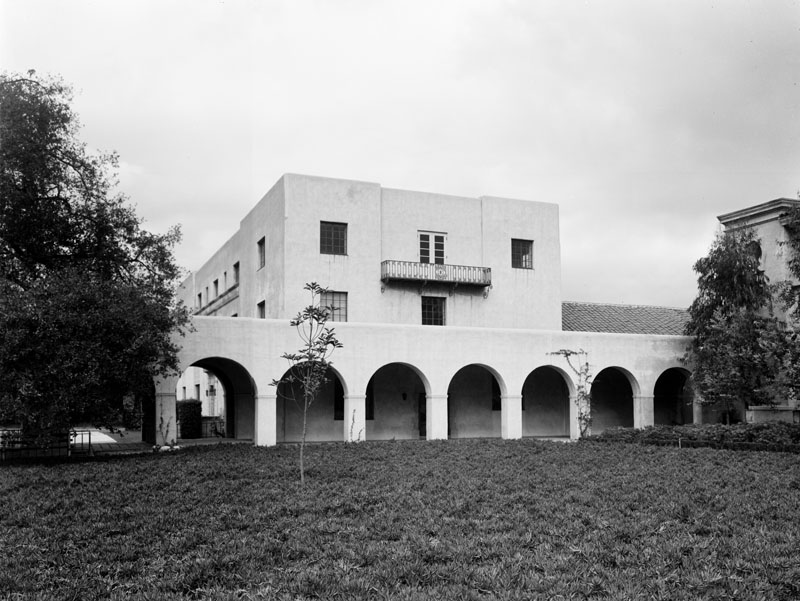 |
|
| (1939)* - Exterior view of Dabney Hall of the Humanities at the California Institute of Technology in Pasadena. |
Historical Notes Caltech opened its doors to female undergraduates during the presidency of Harold Brown in 1970, and they made up 14% of the entering class. The fraction of female undergraduates has been increasing since then. In fall 2008, the freshman class was 42% female, a record for Caltech's undergraduate enrollment.*^ |
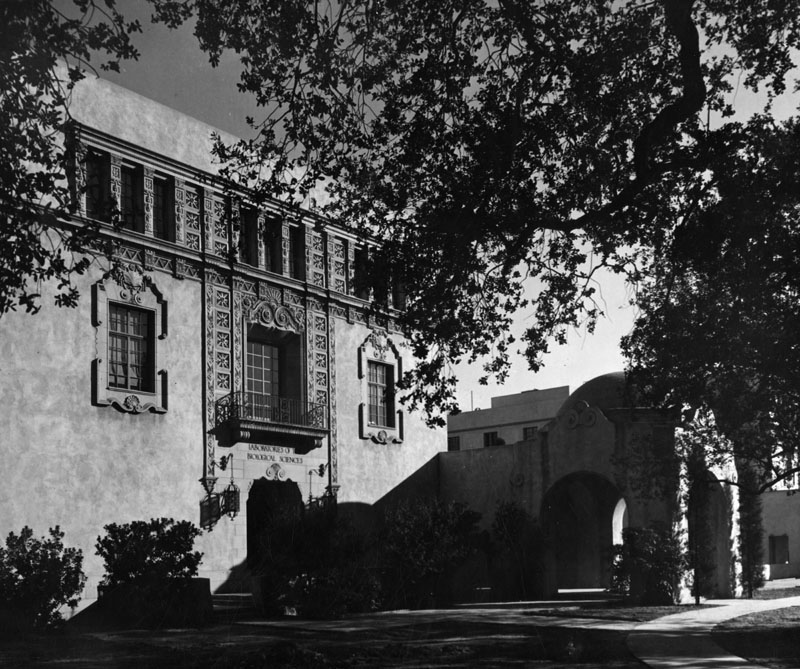 |
|
| (1939)* - Exterior view of the Biological Sciences building and Arcade Pavilion at the California Institute of Technology. View also shows the architectural designs above the entrance and around the windows of the building. West entrance of simplified Beaux Arts style laboratory building executed in poured concrete. Architect: Goodhue and Associates. Date built: ca. 1929. |
Historical Notes Caltech has six academic divisions with strong emphases on science and engineering. Caltech was ranked 1st internationally in 2011 and 2012 by the Times Higher Education World University Rankings. Caltech was ranked as the best university in the world in two categories: Engineering & Technology and Physical Sciences. It was also found to have the highest faculty citation rate in the world.*^ |
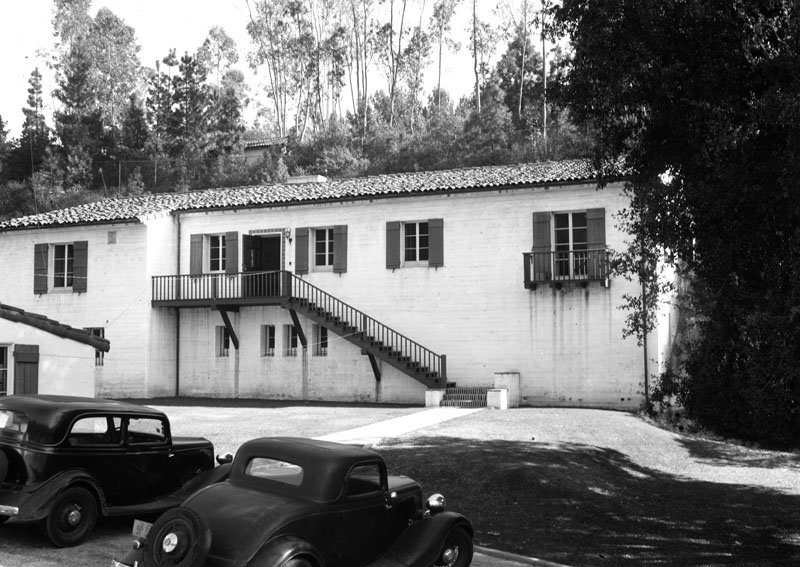 |
|
| (1939)* - Exterior view of the Carnegie Seismological Institution Laboratory in Pasadena on May 4, 1939. |
Historical Notes In 2012, the Center for World University Rankings ranked Caltech fifth in the world and fourth nationally in its CWUR World University Rankings.*^ |
* * * * * |
Pacific-Asia Museum
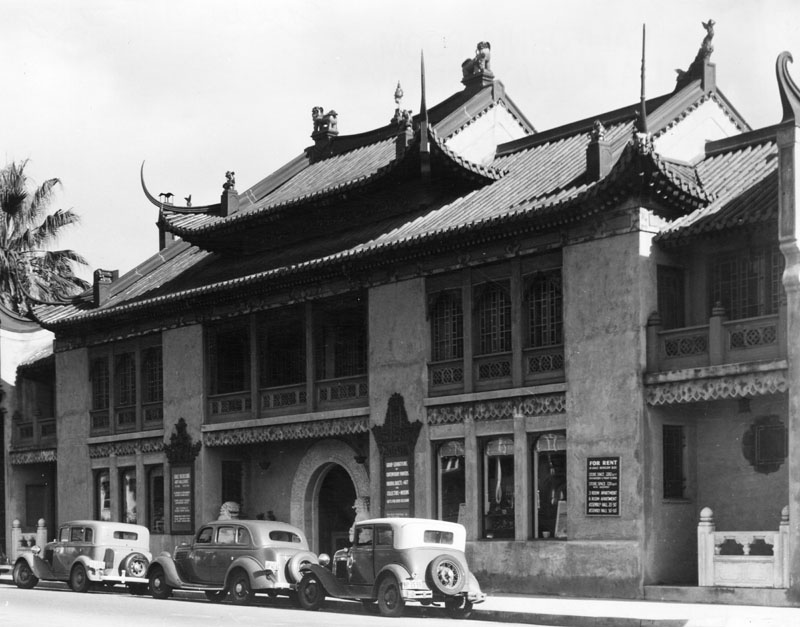 |
|
| (1939)* - Exterior view of the Grace Nicholson Bazaar and Art Gallery, now the Pacific-Asia Museum. Photo is dated July 26, 1939. Mrs. Nicholson was a dealer in Oriental art and books, and this was her shop and home. Later it became the Pasadena Art Institute. This photo shows that she rented apartments, store space and assembly halls in this building. |
Historical Notes Grace Nicholson, a noted collector and authority on American Indian and Asian Art and artifacts, supervised the design of her combination gallery and museum which was completed in 1929. It has been called an outstanding example of 1920s revival architecture and is unique for its use of Chinese ornamentation. Since then it has been designated as a California Historical Landmark, No. 988, located at 46 North Los Robles Ave, Pasadena. Click HERE to see more California Historical Landmarks in LA County.^* |
|
Historical Notes In 1901, Grace Nicholson moved to California, and soon opened a small shop in Pasadena, selling Native American handicrafts such as baskets and weaving. She hired crafters to teach traditional beadwork and other skills; she rented space to local artists. She traveled extensively in the rural western and Southwestern United States, worked with local dealers to build her collection, and corresponded with East Coast collectors to sell the objects. She personally photographed and catalogued her holdings; she also built an extensive photographic record beyond the objects, especially of the Klamath River people, with whom she had frequent dealings. Nicholson acquired artifacts for sale, but also for major museums such as the Smithsonian Institution and the Field Museum in Chicago. She lectured about "the Indian" to churches and civic groups. In recognition of her expertise, Nicholson was elected to the American Anthropological Association in 1904. As a member of the "Anthropological Society," she joined a tour group that visited horticulturist Luther Burbank in 1905, in Santa Rosa, California. In 1909, she was awarded a silver medal at the Alaska-Yukon-Pacific Exposition in Seattle, for a display of baskets and other artifacts. In 1924, she designed a new building for her collections, which (reflective of changing fashions) had begun to focus on Asian art. The architectural firm of Marston, Van Pelt & Maybury worked with Nicholson to realize her vision. Her design, nicknamed the "Treasure House," borrowed elements from buildings she had seen in China. The building was opened as an art gallery and shop in 1925, although the interior garden courtyard was not completed until 1929.*^ |
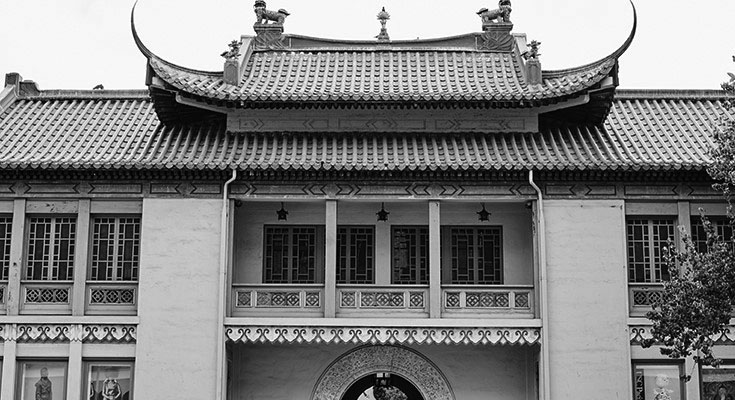 |
|
| (2018)^ – Close-up front view of the USC Pacific-Asia Museum. Photo courtesy of Pasadena Convention & Visitor Bureau |
Historical Notes In 2013, University of Southern California partnered with the museum to form USC Pacific Asia Museum. USC Pacific Asia Museum is the only university museum in the United States dedicated exclusively to the arts and culture of Asia and the Pacific Islands. The museum’s mission is to further intercultural understanding through the arts of Asia and the Pacific Islands. |
* * * * * |
War Memorial Building
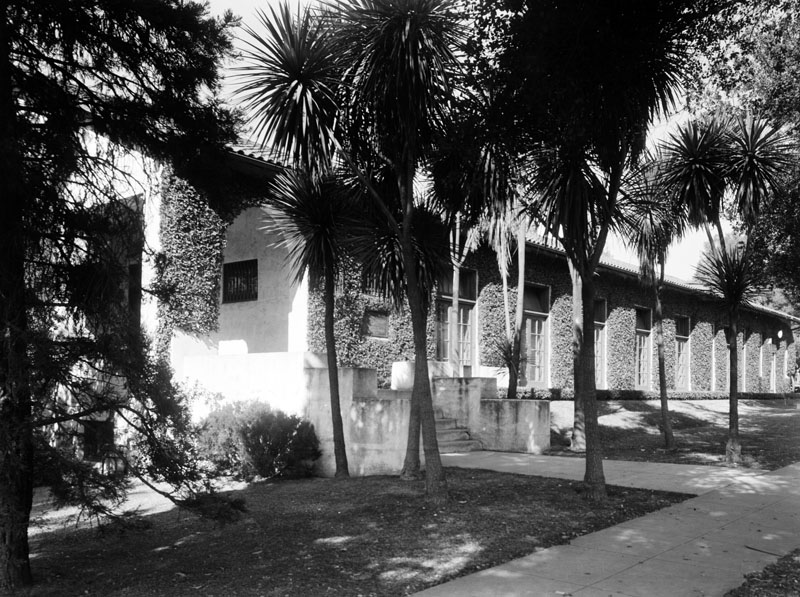 |
|
| (1939)* - Exterior view of War Memorial Building, located at 435 S. Fair Oaks Avenue in South Pasadena. Photo dated: March 3, 1939. |
Historical Notes The War Memorial Building, designed by Norman Foote Marsh, has served as a memorial to veterans and as a meeting place for South Pasadena's American Legion Post No. 140. In 1921, the cornerstone was laid and two years later General John J. Pershing planted a redwood tree on the grounds. The building is #2 on South Pasadena's Register of Cultural Heritage Landmarks.* |
* * * * * |
Millard House (aka "La Miniatura")
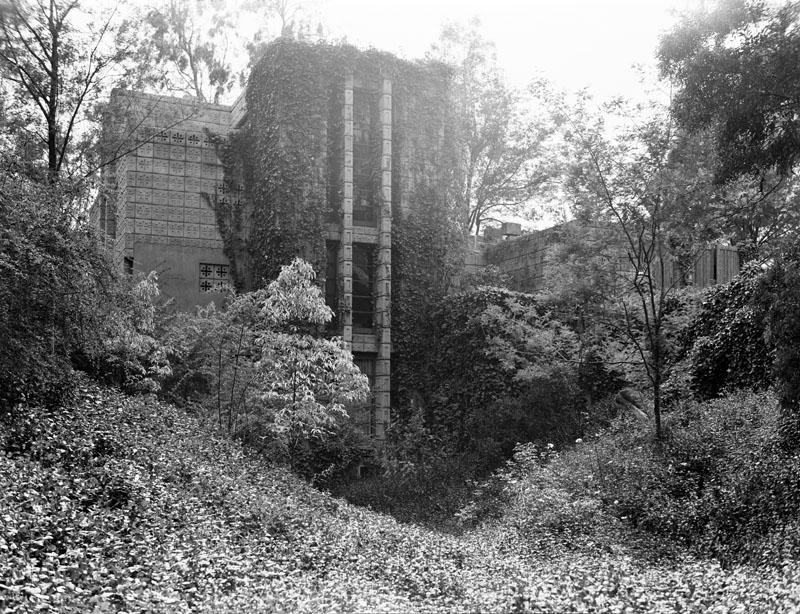 |
|
| (1939)* - Exterior view of the Millard House, named "La Miniatura", located at 645 Prospect Crescent in Pasadena. It was designed by architect Frank Lloyd Wright in a style resembling a Mayan temple, and set in a jungle-like landscape. |
Historical Notes The Millard House was the first of Frank Lloyd Wright's four "textile block" houses — all built in Los Angeles County in 1923 and 1924. Wright took on the Millard House following his completion of the Hollyhock House in Hollywood and the Imperial Hotel in Japan.*^ It was commissioned by rare book dealer Alice Millard, for whom Wright had already designed a home in Chicago in 1906. |
 |
|
| (2011)^.^ – View showing the Millard House as it appears today. |
Historical Notes The 4,230 square foot home has four bedrooms and four bathrooms, two kitchens, and a studio guest house that was designed by Frank Lloyd Wright’s son, Lloyd Wright, a year after the original home was completed. Built in 1923, the house was listed on the National Register of Historic Places in 1976. |
* * * * * |
Please Support Our CauseWater and Power Associates, Inc. is a non-profit, public service organization dedicated to preserving historical records and photos. Your generosity allows us to continue to disseminate knowledge of the rich and diverse multicultural history of the greater Los Angeles area; to serve as a resource of historical information; and to assist in the preservation of the city's historic records.
|
More Historical Early Views
Newest Additions
Early LA Buildings and City Views
History of Water and Electricity in Los Angeles
* * * * * |
References and Credits
* LA Public Library Image Archive
^*California Historic Landmark Listing (Los Angeles)
^#South Pasadena Middle School Home Page
#* Huntington Digital Library Archive
## Google Maps
++ Squareone.org: Pasadena Winter Garden
^^*LA Times Framework: Palomar Telescope
*^^Nuestra Señora la Reina de los Ángeles: losangelespast.com
***Pasadena Museum of History: Pacific Electric Railway Then and Now
**#Metro Transportation Library and Archive
+**Automobile in American Life and Society
++*Estately Blog: Colorado Street Bridge Postcard
+++Facebook.com – Los Angeles Heritage Railroad Museum
#+#Facebook: Hollywood's Garden of Allah novels, by Martin Turnbull
^++Pomona Library Image Archive
+^+Pasadena: A Business History: The Model Grocery
^+^Master Plan of Highways - County of Los Angeles
^*#Noirish Los Angeles - forum.skyscraperpage.com; Oak Knoll PE Line
*#*KCET: Colorado Street Bridge; L.A.'s First Freeways
*##Los Angeles Movie Palaces: Fox Pasadena
#^^Hometown Pasadena: Tower Theatre
#^#Pyroil - The Wonder Gas: theoldmotor.com
#*#Pasadena Adventure: walknridela.com
##*The Pasadena Civic - History
##+Waymarking.com: First Church of Christ, Scientist Pasadena
**^^Cinema Treasures: Florence - State Theatre; Tower Theatre
*^^*Pasadena: A Busines History
^***Facebook.com: I Grew Up in San Gabriel Valley: Colorado Blvd.
^^**Cruiselinehistory.com: Pasadena Santa Fe Station – Gateway to Hollywood
^^*#Facebook.com - Pasadena Digital History
^++^Facebook: Los Angeles Heritage Railroad Foundation
#^^*Pasadena Star News: Pasadena Civic Auditorium; Drone View of Pasadena City Hall; Pasadena Playhouse
#^^^The City of Pasadena - cityofpasadena.net: Central Library
##++Flickr.com: Boston Public Library
++##Facebook:AmericarTheBeautiful
**##Eating L.A. - Guinn's Coffee Shop and Drive-in
*^ Wikipedia: History of Pasadena; Tournament of Roses Parade; The Langham Huntington; Hotel Green; Rose Bowl Game; Pasadena City Hall; Old Town Pasadena; Los Angeles Terminal Railway; Richard H. Chambers United States Court of Appeals and the Vista del Arroyo Hotel and Bungalows; California Institute of Technology; William G. Kerckhoff; Van de Kamp's Holland Dutch Bakeries; Bank of Italy; Arroyo Seco Parkway; Pasadena; United Cigar Stores; Pasadena Star-News; Arroyo Seco; American Legion; Pasadena via Oak Knoll PE Line; Hupmobile
< Back
Menu
- Home
- Mission
- Museum
- Major Efforts
- Recent Newsletters
- Historical Op Ed Pieces
- Board Officers and Directors
- Mulholland/McCarthy Service Awards
- Positions on Owens Valley and the City of Los Angeles Issues
- Legislative Positions on
Water Issues
- Legislative Positions on
Energy Issues
- Membership
- Contact Us
- Search Index
